
mobile - desktop
 | mobile - desktop |
 |
 Contact Sales! |
|
News & Events:
|
|
Reptile & Amphibian
News Blog Keep up with news and features of interest to the reptile and amphibian community on the kingsnake.com blog. We cover breaking stories from the mainstream and scientific media, user-submitted photos and videos, and feature articles and photos by Jeff Barringer, Richard Bartlett, and other herpetologists and herpetoculturists.
Saturday, April 21 2012Living Gems 2011 Babies
Living Gems 2011 Babies
At long last, Living Gems Reptiles is thrilled to profile the babies from its 2011 breeding year. The 17 youngsters in this litter, our first ever, were born on September 14, the result of a pairing between Hills, a brilliant orange male estimated to be born in late 2006: 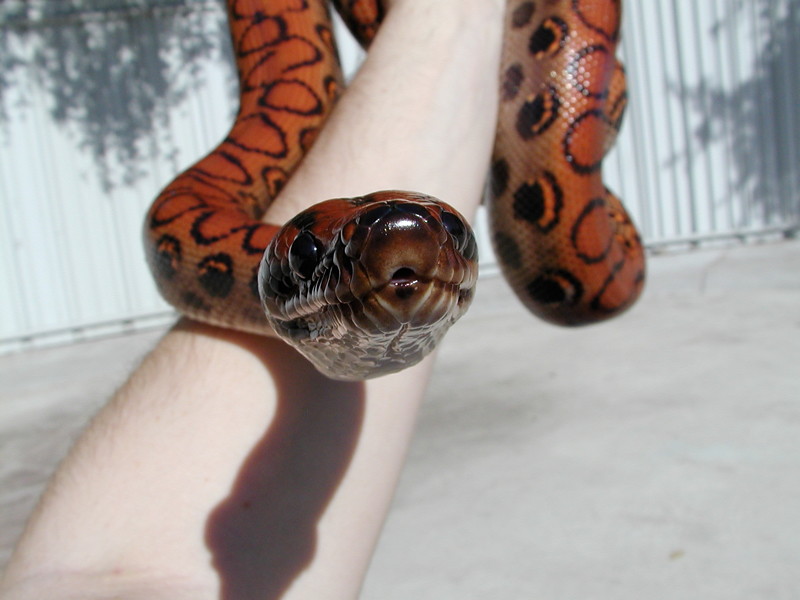 And Alexandrite, a pretty October 2007 female:  Alex was named, as with all Living Gems females, for a pretty gemstone. She is alive and well. Hills was named for the legendary New Zealand mountaineer Sir Edmund Hillary (1919-2008), in honor of this snake’s love of climbing: Hills would always break for my head the first chance he got, and end up wrapped around the top of it. He unfortunately passed away in August of last year, just before the litter was born, and slightly before we went on a sales hold to resolve the events described in the “Beating a Misdiagnosis” thread. The litter contains nine males and eight females. Initial sexing was done by me, and then confirmed by a local professional. Behavior-wise, this litter is full of personality. We’ve done dozens of handling sessions for each baby, part of our commitment to start acclimating them to humans, and -- as with most baby Brazilians -- they missed no chances in the first few sessions to show their outsized bravery. There’s something both impressive and funny about watching 33 grams of fury trying to tell your hand who is boss. Physically, I’m very happy with the litter. For color, their father Hills definitely left his mark: the entire set is above average, with many well above, and an unusually high percentage of potential stunners. Their dorsal ovals all have a slight “blushing” effect where the color gets slightly darker in the center. For pattern, they all have at least one linked dorsal, where one spot has “joined” with its neighbor to form a longer chain. Their side circles are almost exclusively traditional crescents -- nothing like a clean classic look! -- with from zero to three solid black (“eclipse”) and up to three merged spots per baby. Several babies have no departures at all. On about half of the litter, there are small black markings on the back -- another legacy from their father, almost like an official “trademark” pattern for the line that hints of aberrancy -- and/or some faint “bonus black dots” showing among the side crescents. Health-wise, all have now shed five or six times, eaten at least twenty times, and had multiple “confirmations” their digestion is properly working. They have been growing like little weeds: according to my monthly weigh-ins, their last check showed the average baby had tripled its weight in the seven months since their birth, and is running about a month ahead of the average growth rate for baby Brazilians…all of which proves that a small, high-quality collection focused on top care has its benefits for customers. As has been outlined in previous posts, all of these babies come from a disease-tested facility, and Mom’s test results are available upon request. Over the following posts, I will share a description and several pictures of each baby in the litter in order to give you an idea how they act and look, as well as any behavioral or physical quirks. So grab a cup of your favorite brew, sit back, relax, and enjoy! ------ B-01 (Male) This little guy is a calm but highly attentive fellow, who closely follows your every movement when held. He was very placid the last time I handled him for any length, even though he was in shed. Physically, he has several unique traits. On his back, he has three linked chains of two to four spots. He also has a small black dot in his neck area. On his sides, he has a 100% crescent pattern -- a clean, classic look all the way -- and the crescents are thick and distinctive, which should make for an impressive adult. At Birth This shot was taken in mid-September 2011. 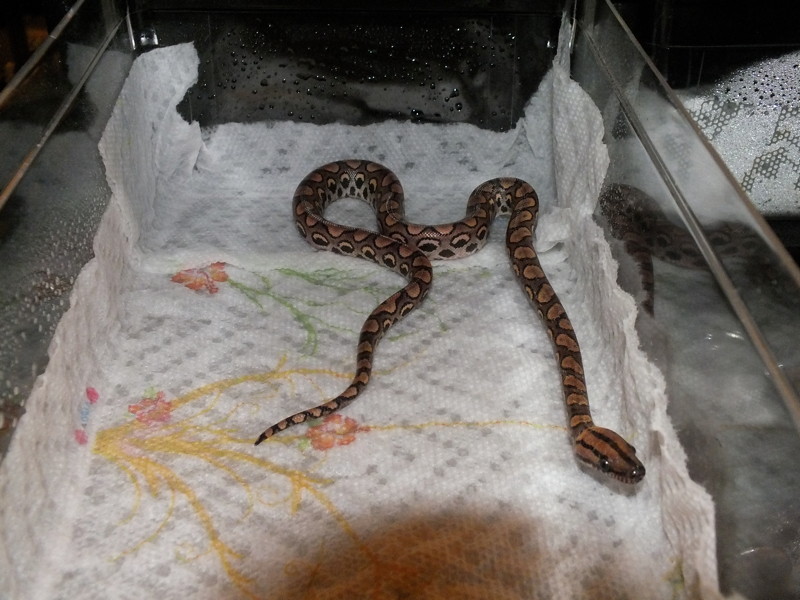 Post Shed This shot was taken in late September 2011. Apologies for the bad lighting; it was taken without formal prep. 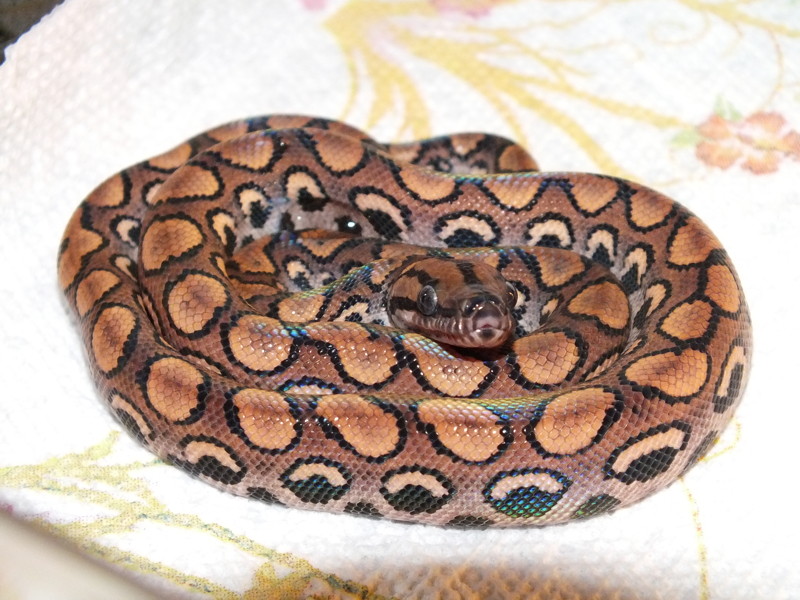 Formal Photo Session This series of shots was taken in early October 2011. Originally, these were to be the sale shots, but circumstances forced a long delay. This mini-set includes a front/side shot, a back/side shot, and a top shot. 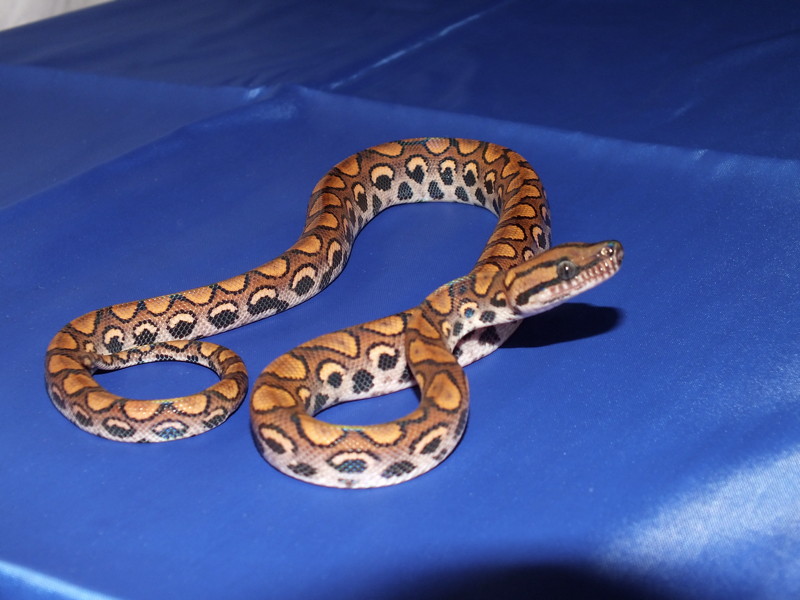 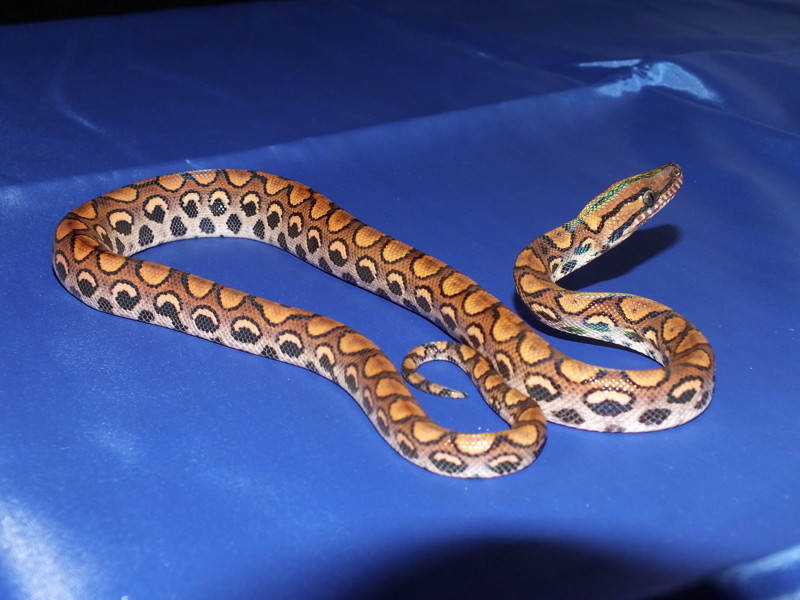 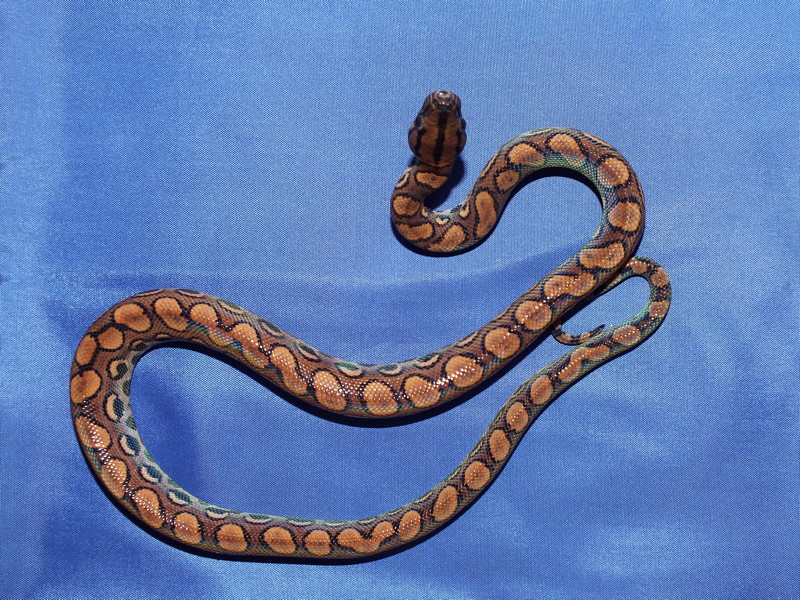 Three-Month Update These shots were taken in late December 2011 to late January 2012, and present an updated view of the baby after the delay. This mini-set includes a side shot and a top shot. 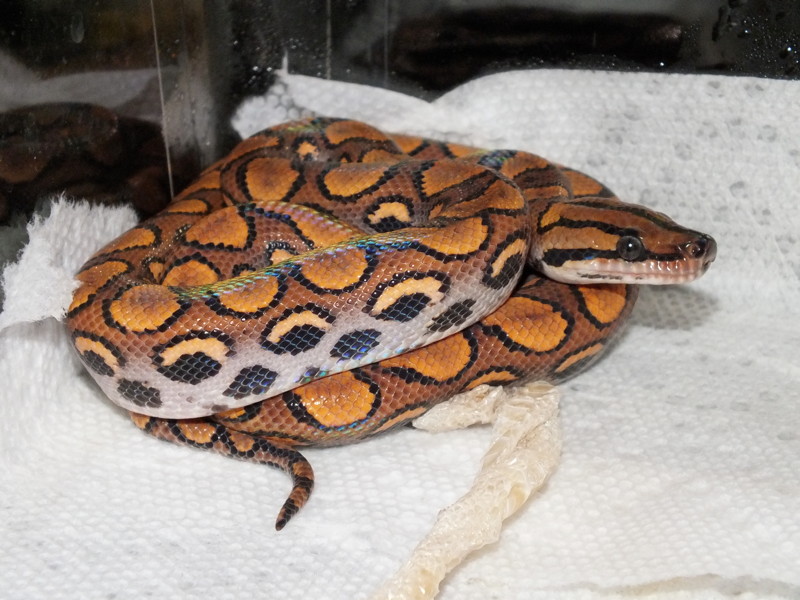 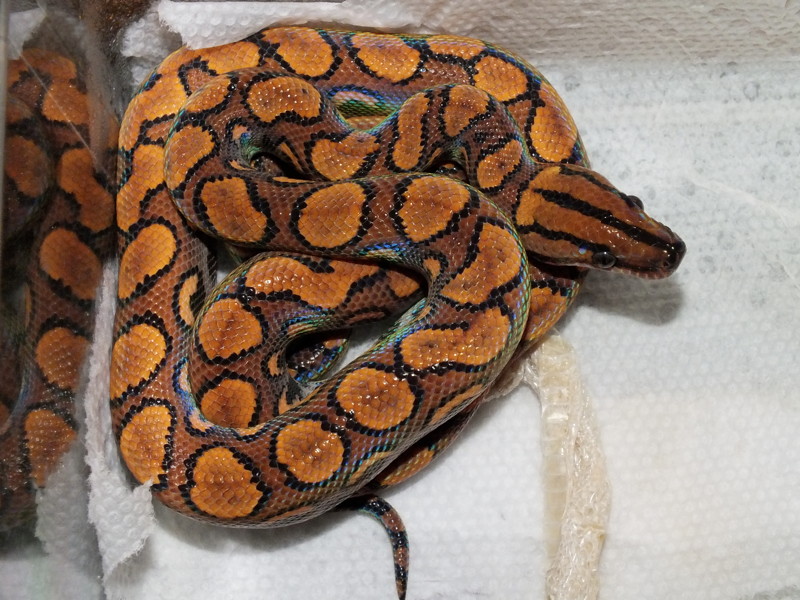 Six-Month Update These shots were taken in March 2012, and present a further updated view of the baby after the delay. This mini-set includes a side shot, a top shot, and a close-up head shot. 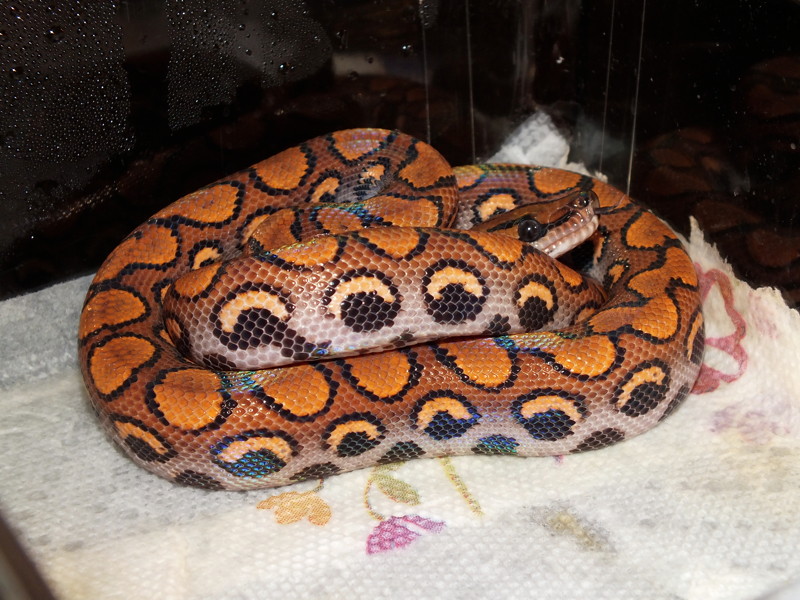 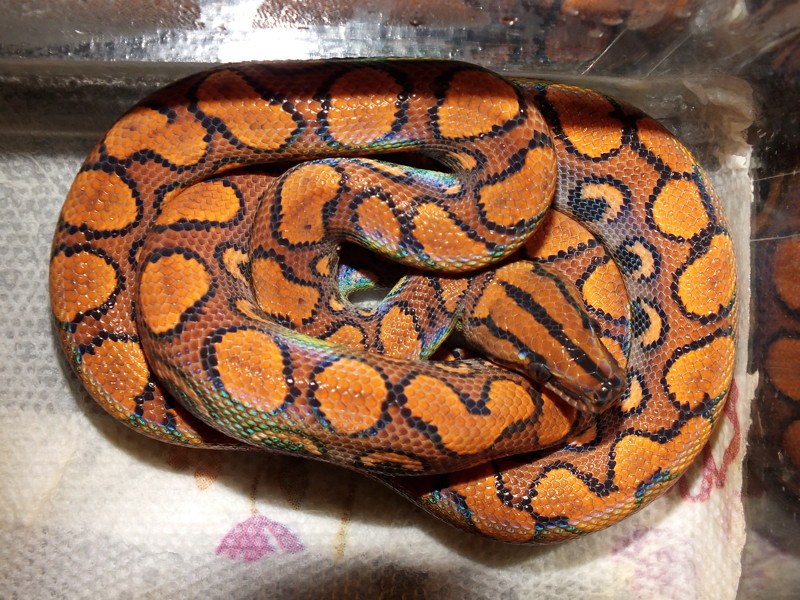 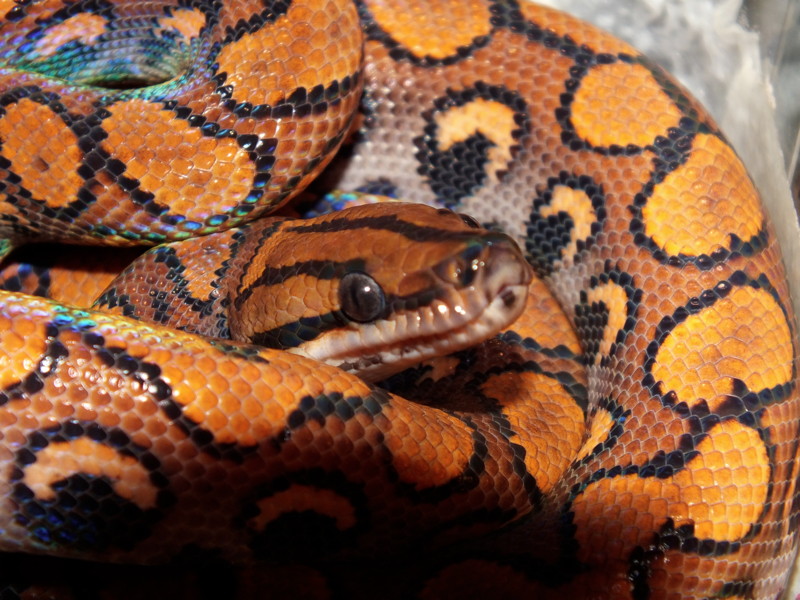 As of March 31, this little one had increased from a birth weight of 34 grams to 99 grams. ------ B-02 (Male) During his final inspection to round out these notes, this little guy was not the model of baby patience: he got very annoyed at me peering at him, and took a baby-defiant swipe or two at me to prove his independence. That said, he’s usually pretty mellow. He may also be a pretty sharp one (for a snake): when I had the local breeder come over to verify gender, B-02 took a swipe at me as I was putting him back in his drawer. I protested to the baby he was targeting the wrong guy, and my friend noted that he yeah, I was just the guy who had hired the guy who examined his junk. Like I said…this little one may be sharper than we think. Physically, he has several unique traits. On his back, he has one linked chain of two spots, and one longer set that should be breedable into a chain: four of his dorsals are closely touching but still have thin borders separating them. On his right side, he has two departures from an otherwise solid crescent pattern: one eclipse and one merged dot. On his left side, he has four departures: three eclipses and one merged dot. At Birth This shot was taken in mid-September 2011. 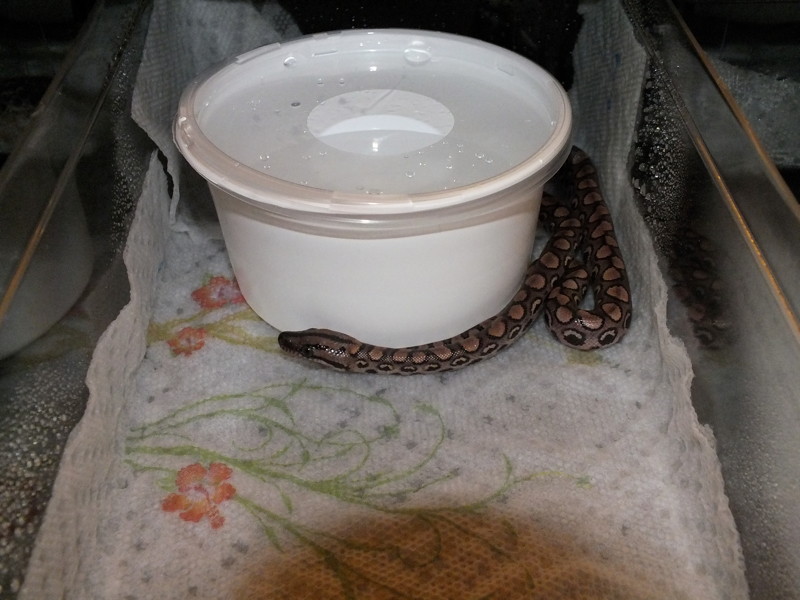 Post Shed This shot was taken in late September 2011. Apologies for the bad lighting; it was taken without formal prep.  Formal Photo Session This series of shots was taken in early October 2011. Originally, these were to be the sale shots, but circumstances forced a long delay. This mini-set includes a front/side shot, a back/side shot, and a top shot. 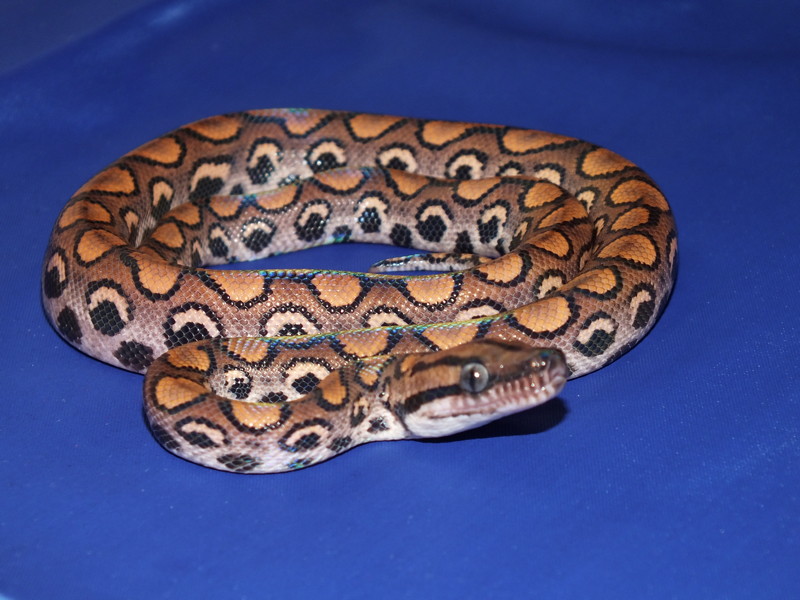 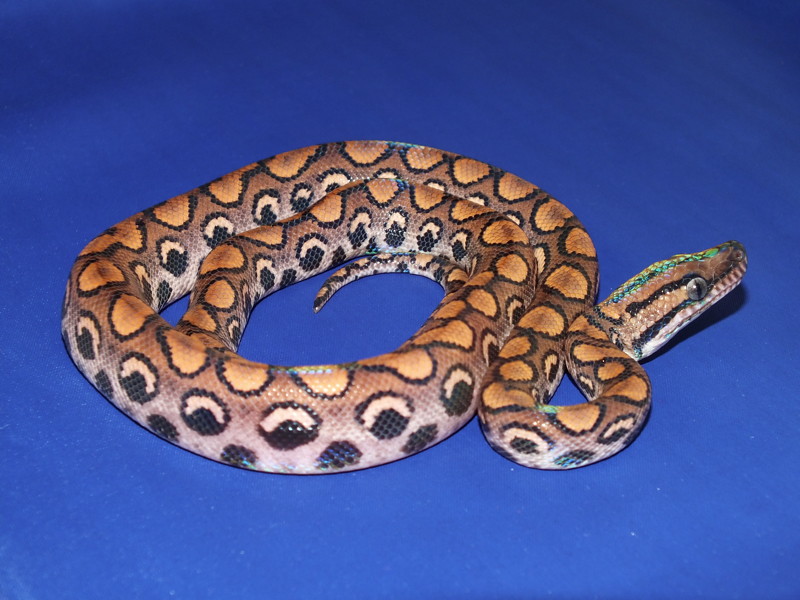 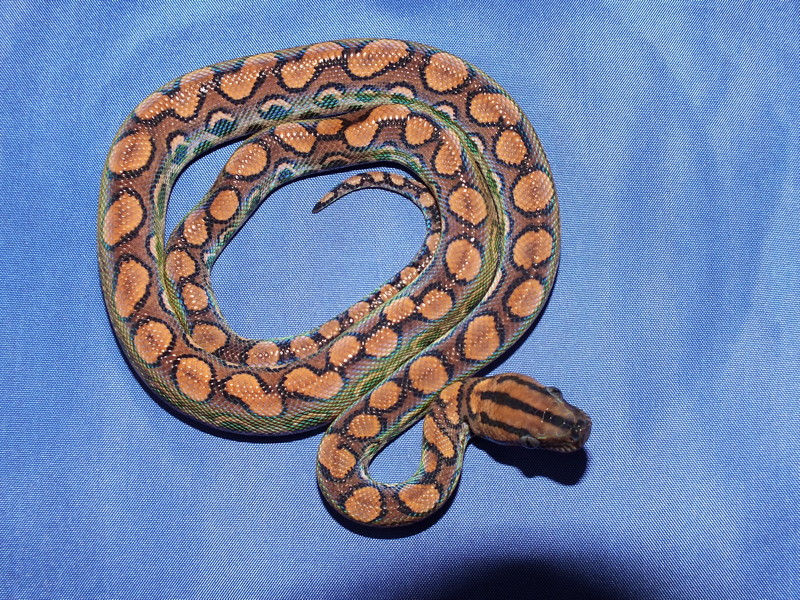 Three-Month Update These shots were taken in late December 2011 to late January 2012, and present an updated view of the baby after the delay. This mini-set includes a front shot and a top shot. 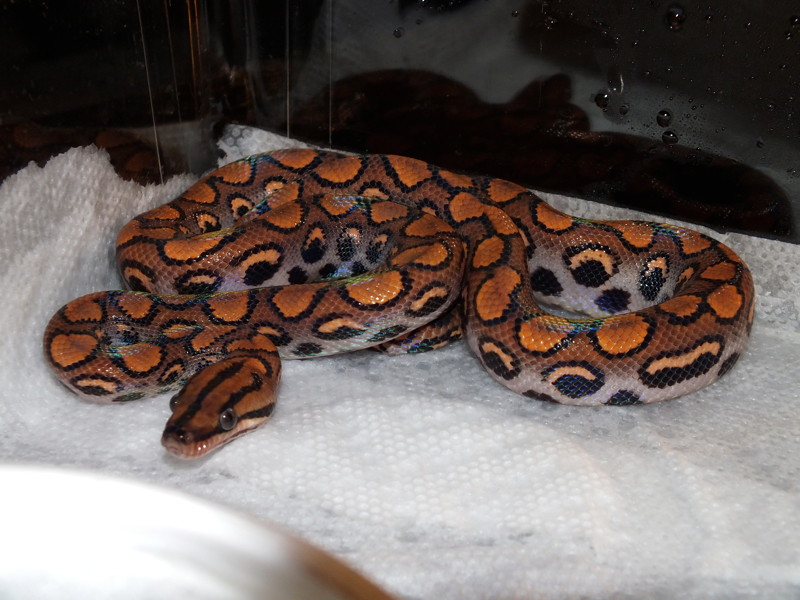  Six-Month Update These shots were taken in March 2012, and present a further updated view of the baby after the delay. This mini-set includes a side shot, a top shot, and a close-up head shot. 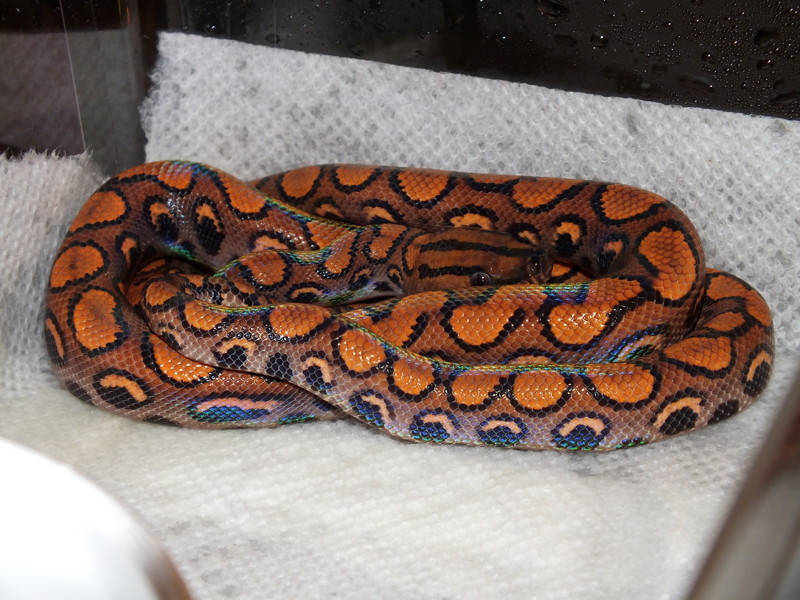 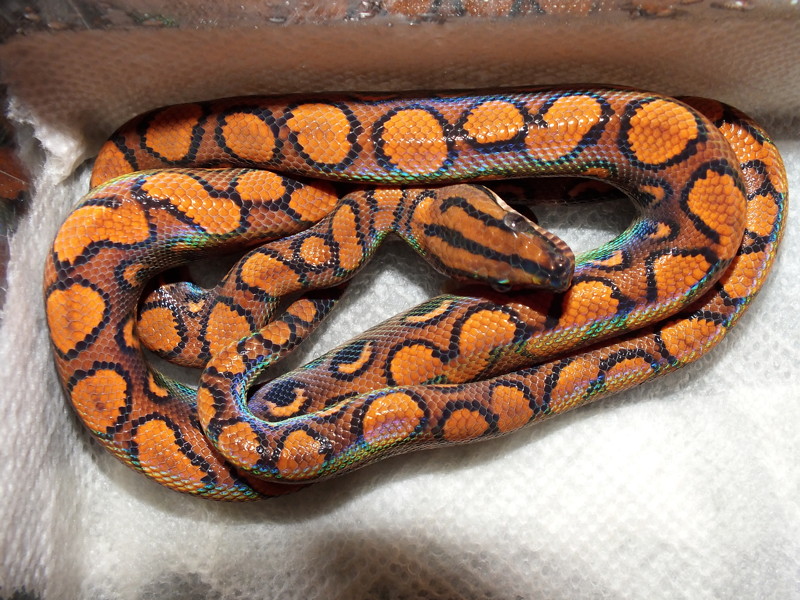 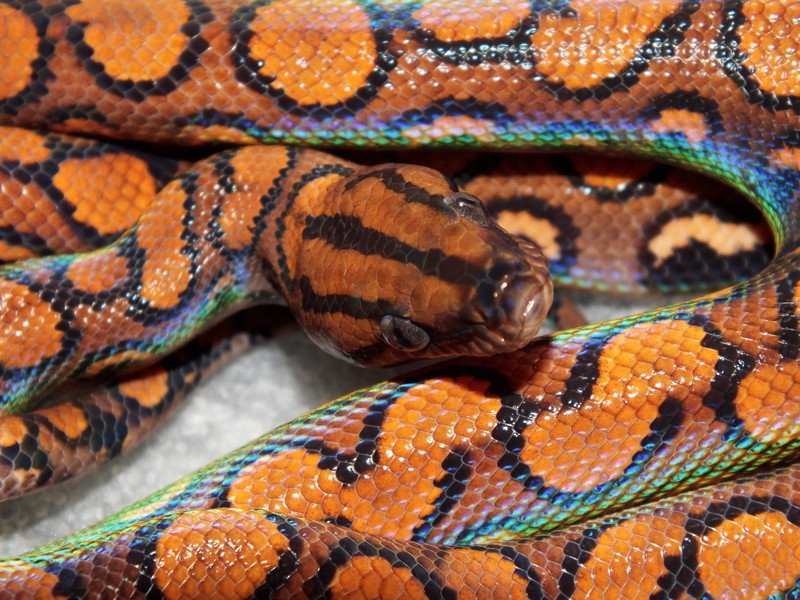 As of March 31, this little one had increased from a birth weight of 32 grams to 90 grams. ------ B-03 (Female) This little lady tried to make the litter’s first escape attempt the day she was born, worming out the top center of the door from her Mom’s hide right as I was closing it, and nearly getting herself clipped in the process (my hands were full with two other babies at the time). She had an almost “raisiney” appearance before her first shed, which cleared right up when she cast off her old skin. During the handling session where I mapped out her patterns, she was very on guard and wary of this unusual inspection, but held her peace the entire time. She can be a bit nervous as well; during the December weigh-in she was very clingy. This little girl has several unique traits. On her back, she has two linked chains of two spots. On her left side, she has a 100% crescent pattern. On her right side, she has two departures from an otherwise solid crescent pattern: one eclipse and one merged dot. Finally, she has a small distinctive black “bar” towards her tail along her center line. At Birth This shot was taken in mid-September 2011. 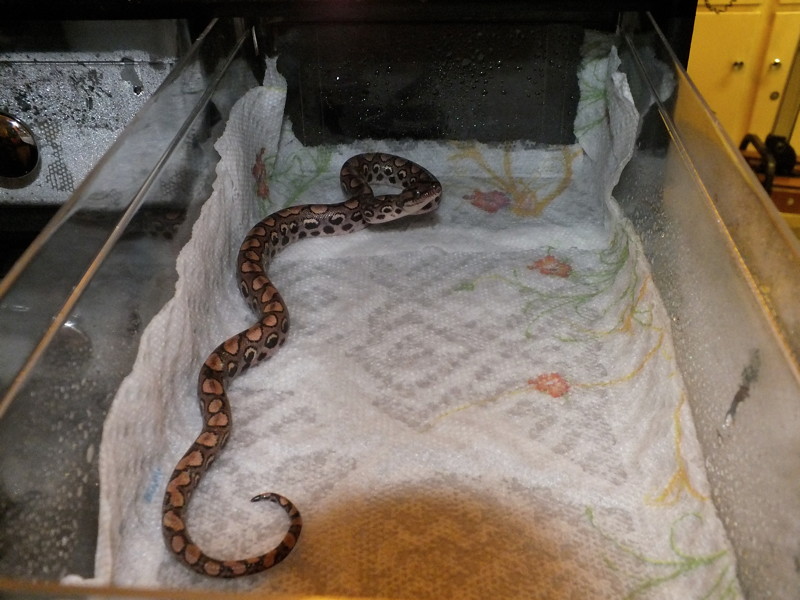 Post Shed This shot was taken in late September 2011. Apologies for the bad lighting; it was taken without formal prep. 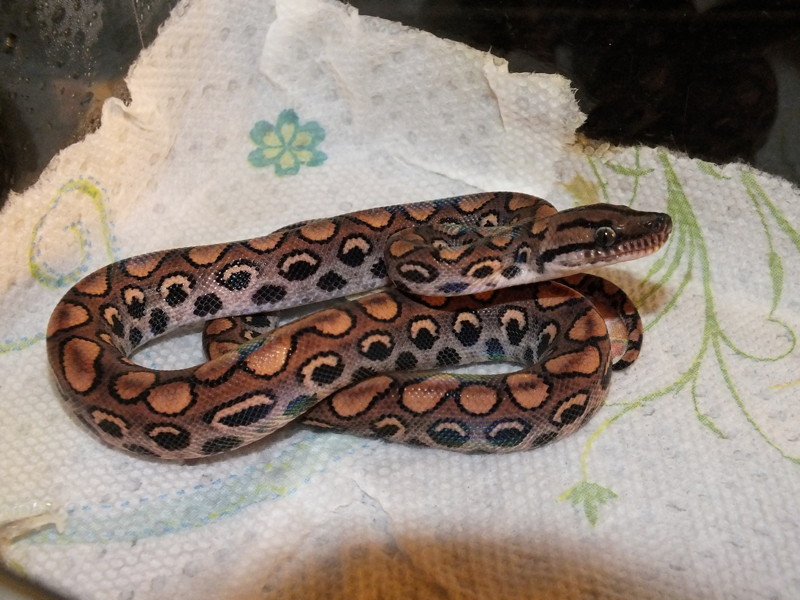 Formal Photo Session This series of shots was taken in early October 2011. Originally, these were to be the sale shots, but circumstances forced a long delay. This mini-set includes a front shot, a side shot, and a top shot.  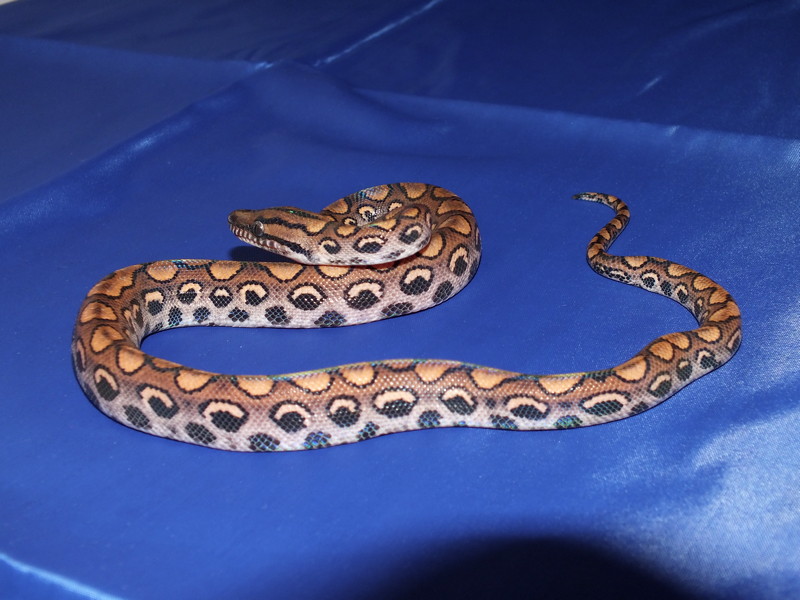  Three-Month Update These shots were taken in late December 2011 to late January 2012, and present an updated view of the baby after the delay. This mini-set includes two top shots, one taken just after she shed, and one a day later (a better photo I thought). 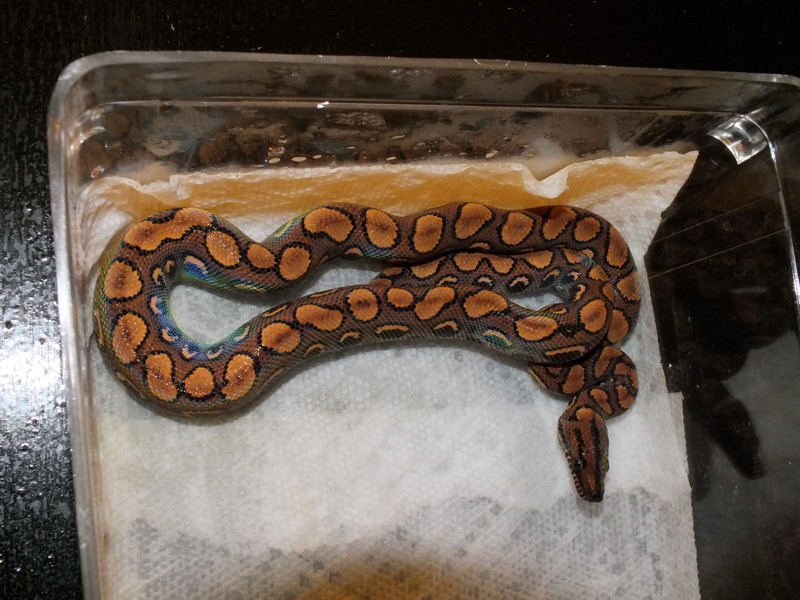 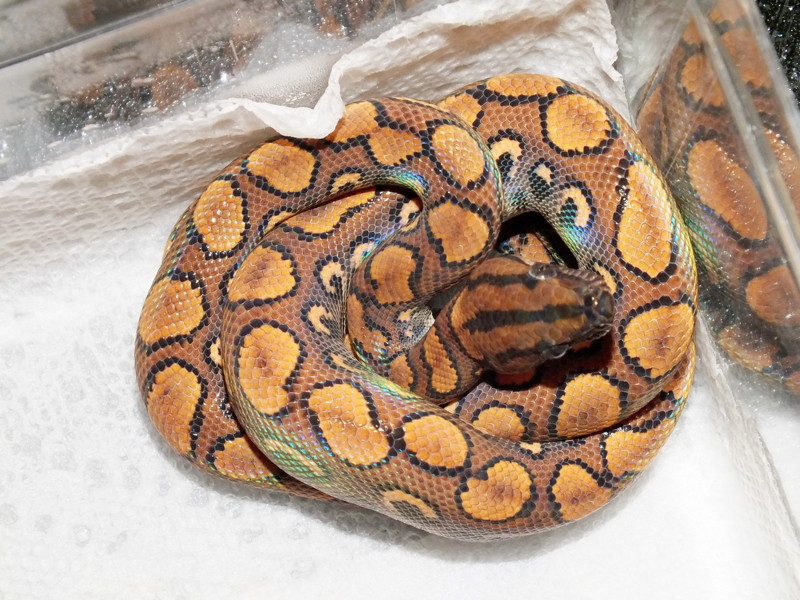 Six-Month Update These shots were taken in March 2012, and present a further updated view of the baby after the delay. This mini-set includes a front/side shot, a top shot, and a close-up head shot. 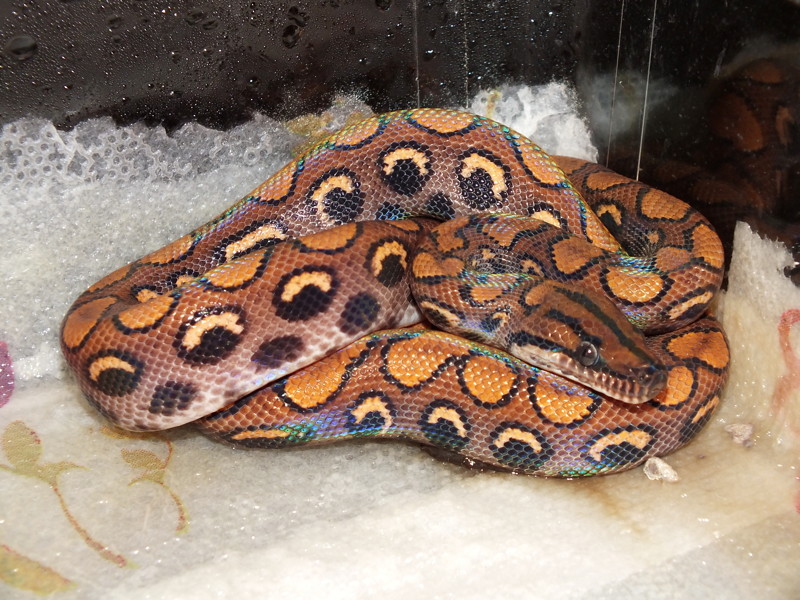 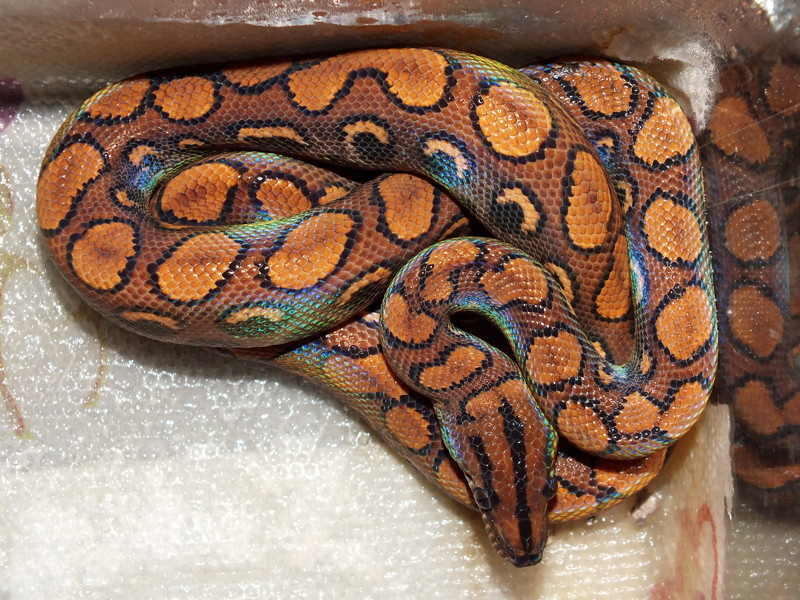  As of March 31, this little one had increased from a birth weight of 34 grams to 85 grams. ------ B-04 (Male) This little guy was in full spirit during his pattern inspection: he got really annoyed with my physical review, and decided to let my thumb know exactly how he felt about it (which was more cute than damaging -- he didn’t even break the skin). While he eats with clockwork reliability, he does tend to like his meal abandoned in his drawer with him before he’ll deign to eat it. Either that, or he thinks my “cooking” stinks. Physically, he has several unique traits. On his back, he has an impressive five linked chains, one of three spots and four of two. On his left side, he has a 100% crescent pattern. On his right side, he has only one or two departures from an otherwise solid crescent pattern, both eclipses. At Birth These shots were taken in mid-September 2011. The first shot was taken shortly after birth, while he was still with Mom. Not surprisingly, he looked a little rough around the edges. 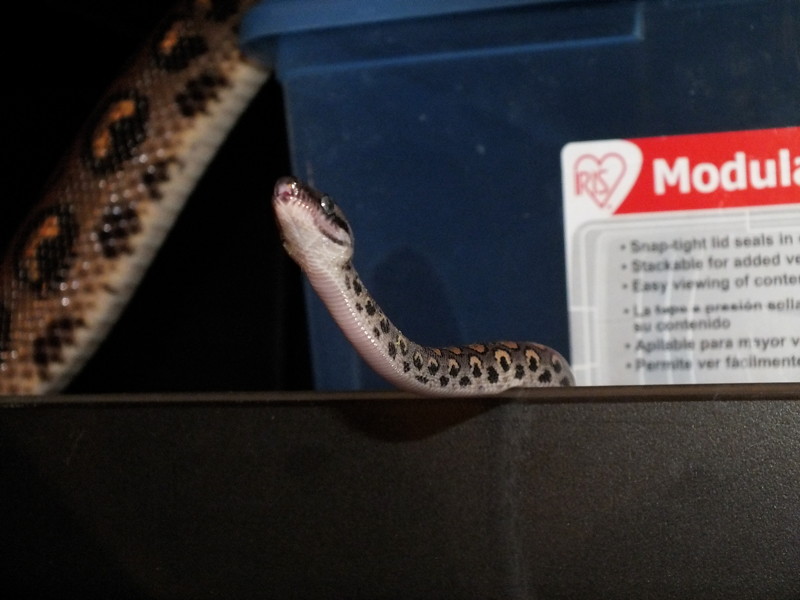 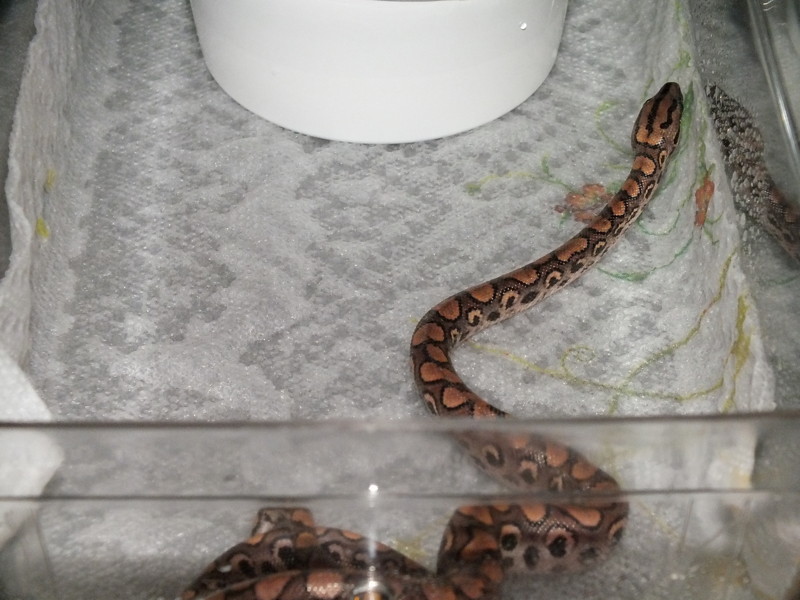 Post Shed This shot was taken in late September 2011. Apologies for the bad lighting; it was taken without formal prep. 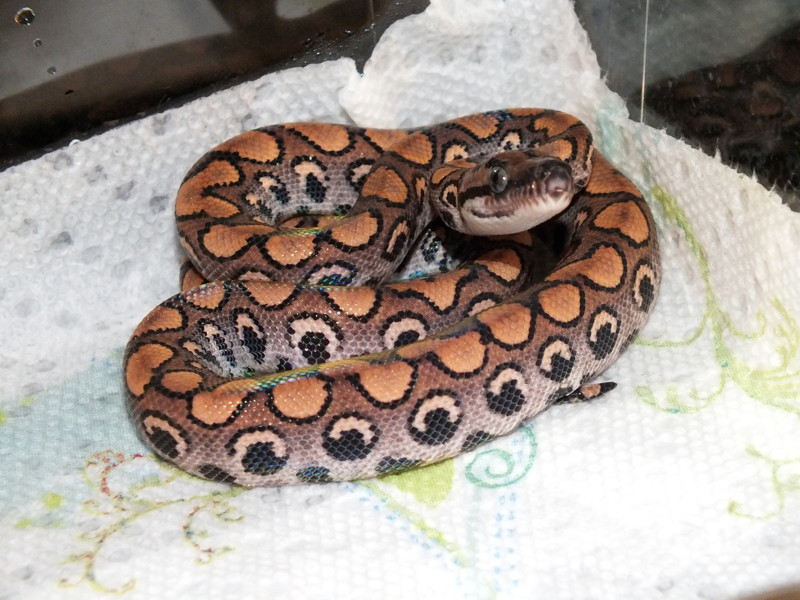 Formal Photo Session This series of shots was taken in early October 2011. Originally, these were to be the sale shots, but circumstances forced a long delay. This mini-set includes a front/side shot, a back/side shot, and a top shot.  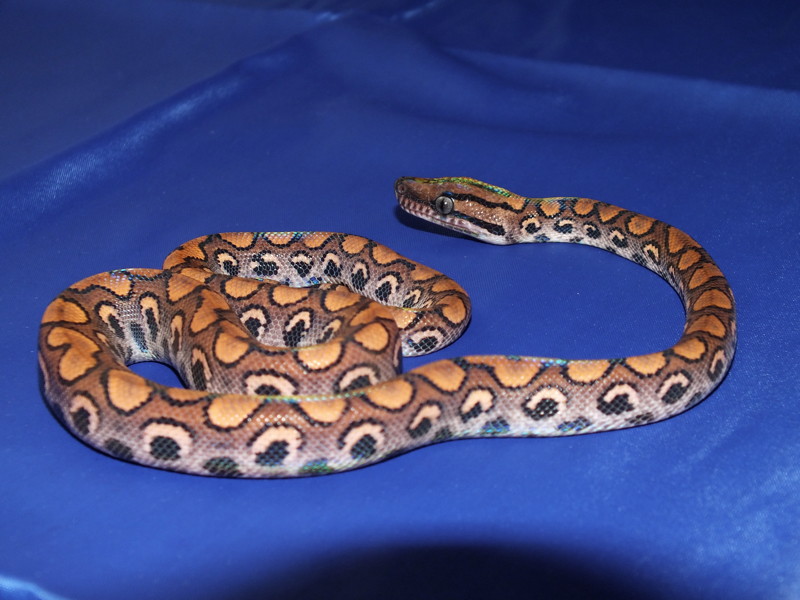 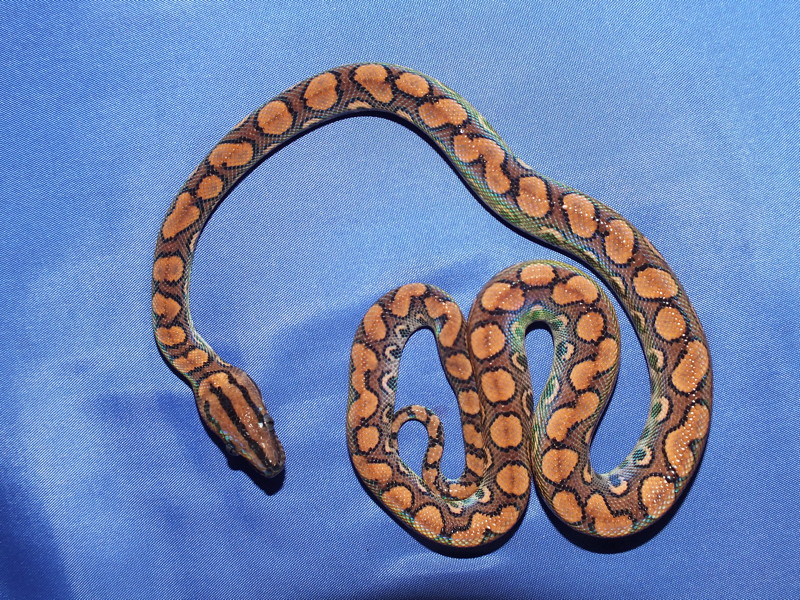 Three-Month Update These shots were taken in late December 2011 to late January 2012, and present an updated view of the baby after the delay. This mini-set includes a side shot and a top shot. 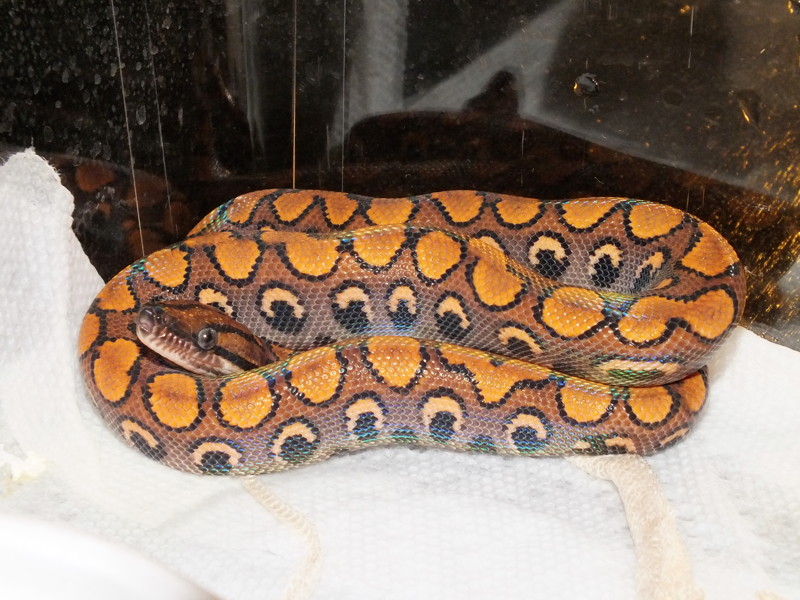 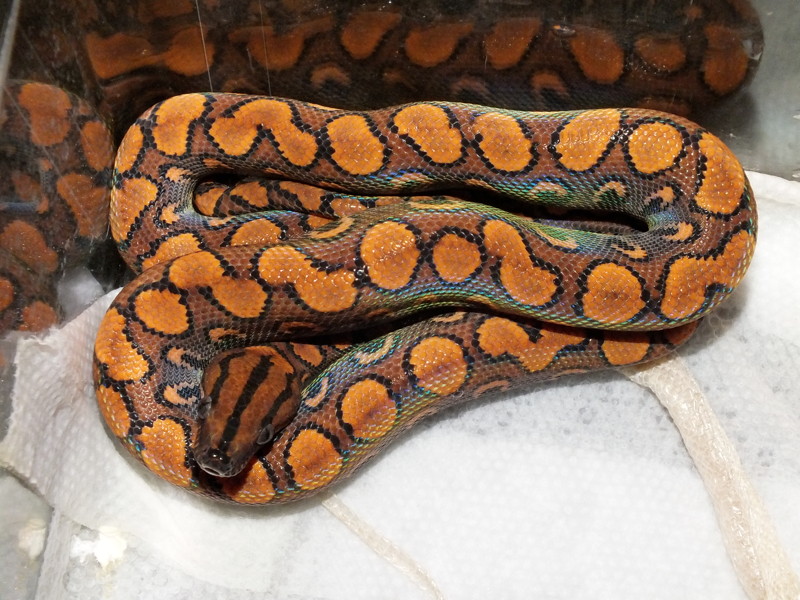 Six-Month Update These shots were taken in March 2012, and present a further updated view of the baby after the delay. This mini-set includes a front/side shot, a top shot, and a close-up head shot. 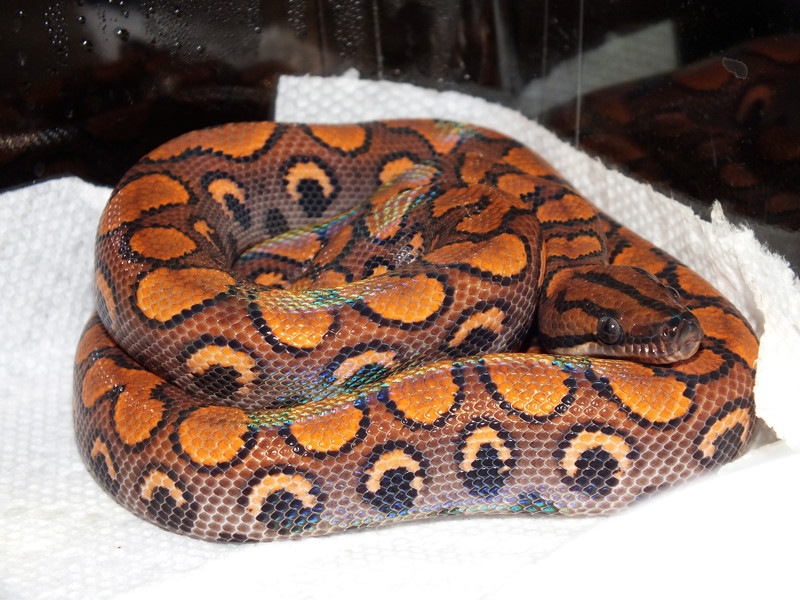 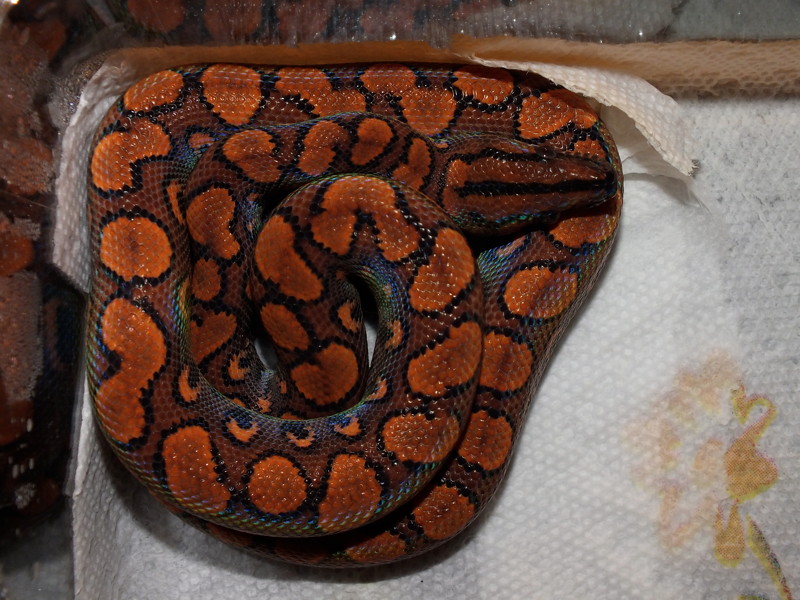 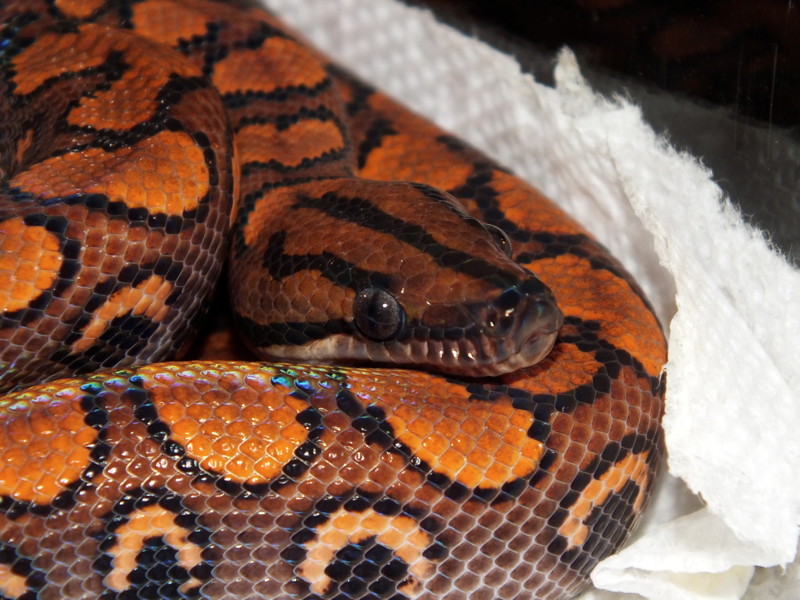 As of March 31, this little one had increased from a birth weight of 32 grams to 101 grams. ------ B-05 (Female) This little gem is my lead female holdback candidate. She’s fairly placid now, but early on in our “friendship” she was so eager to get at me she actually bit herself in her rush to connect! During a recent handling session, she was very calm but highly energetic, exploring my arm as we worked and finally wrapping herself around left wrist like a small colorful bracelet. Coolest of all, out of all the litter, she is one that inherited her sire’s love of climbing -- she heads right for my glasses and the top of my head like a human jungle gym every chance she gets. Physically, she has several unique traits. On her back, she has two linked chains of two spots, and another long row of seven touching dots that could be moldable into a chain with breeding. On her right side, she has a 100% crescent pattern. On her left side, she has one departure from an otherwise solid crescent pattern, a merged spot. Finally, she an interesting little black “eight” pattern on her back. At Birth This shot was taken in mid-September 2011. 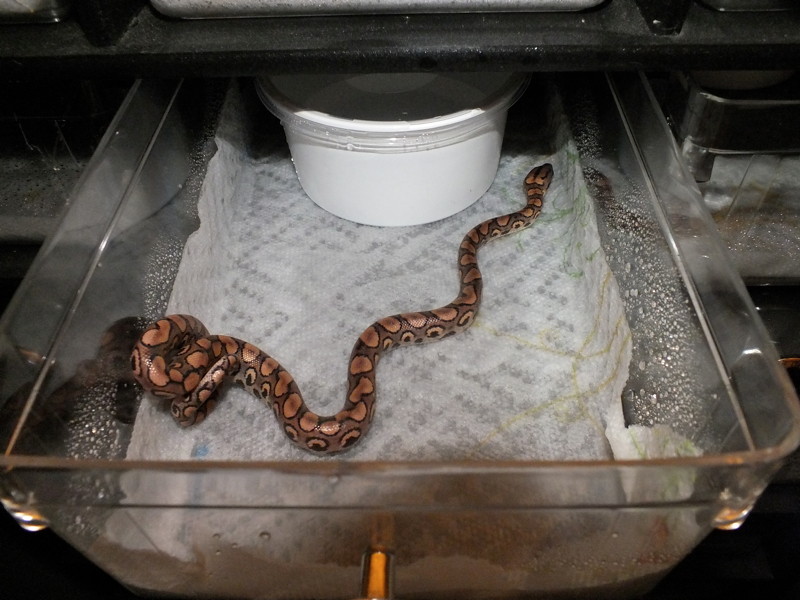 Post Shed This shot was taken in late September 2011. Apologies for the bad lighting; it was taken without formal prep. 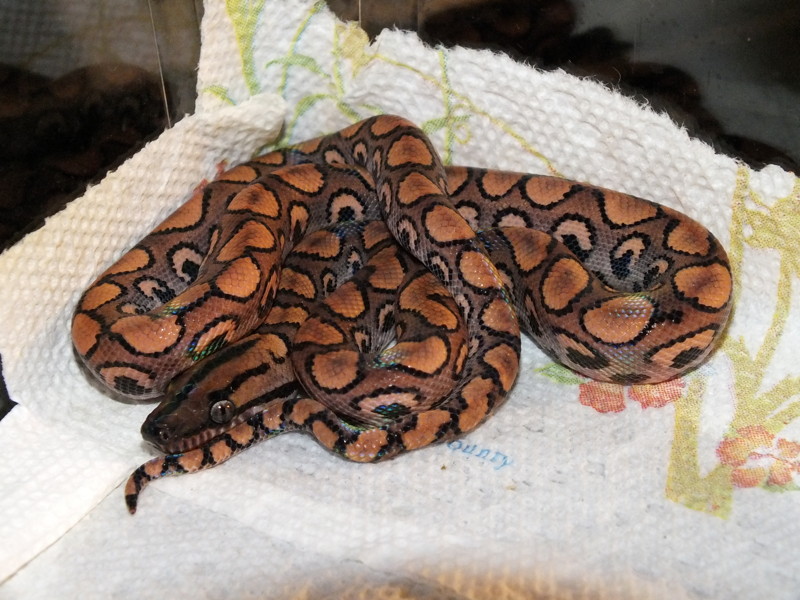 Formal Photo Session This series of shots was taken in early October 2011. Originally, these were to be the sale shots, but circumstances forced a long delay. This mini-set includes a front/right shot, a front/left shot, and a top shot. 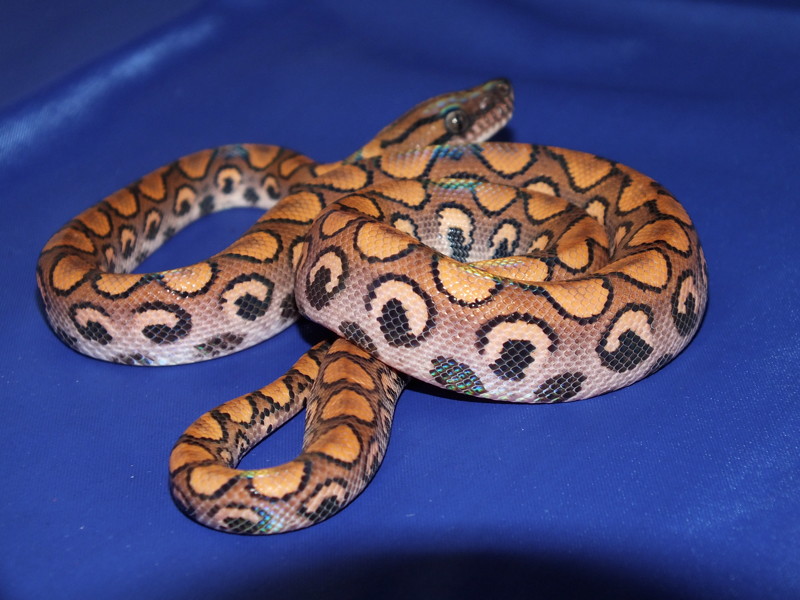 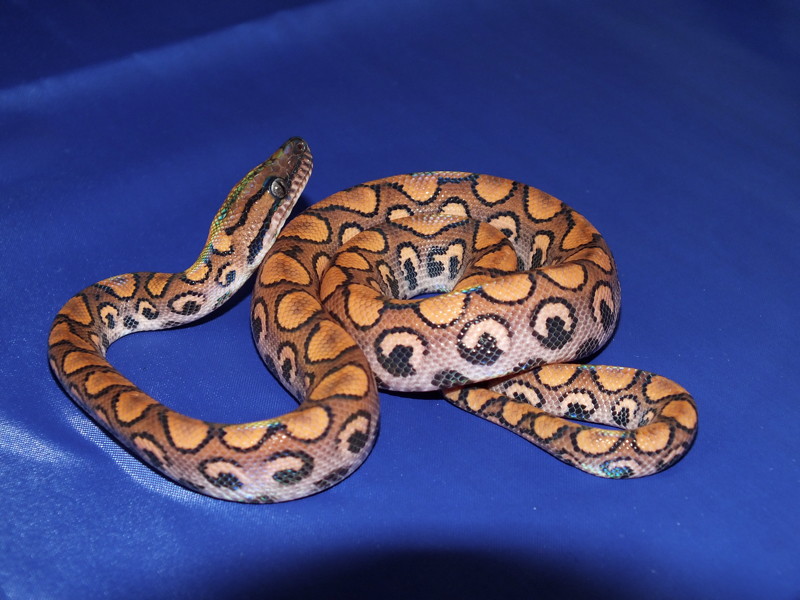 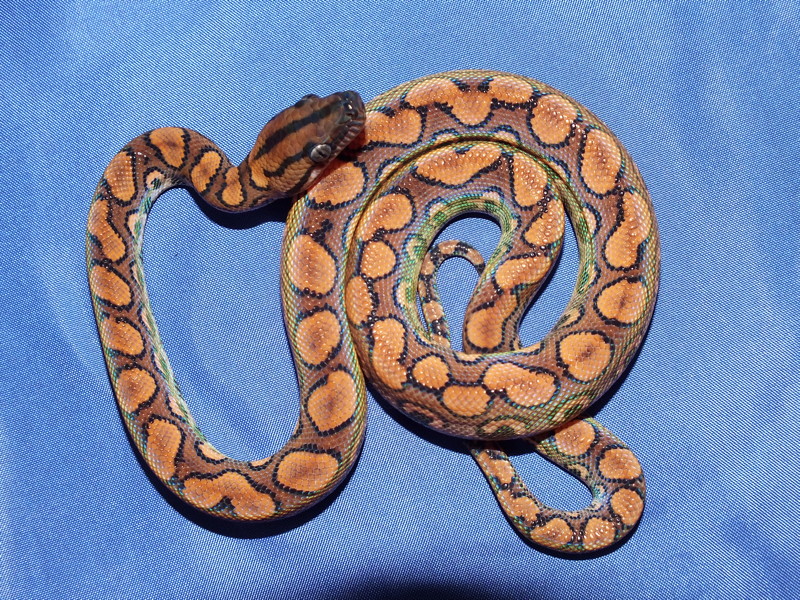 Three-Month Update These shots were taken in late December 2011 to late January 2012, and present an updated view of the baby after the delay. This mini-set includes a front/side shot and a top shot.  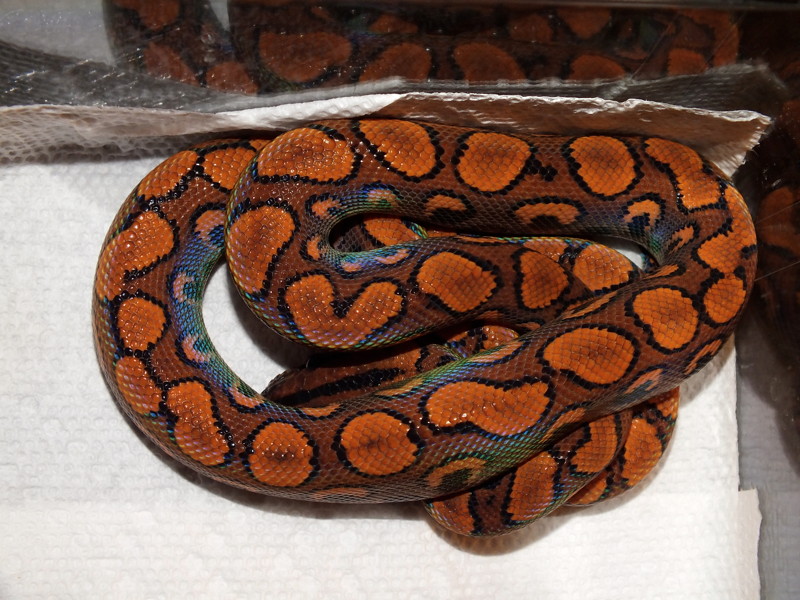 Six-Month Update These shots were taken in March 2012, and present a further updated view of the baby after the delay. This mini-set includes a front shot and a top shot. 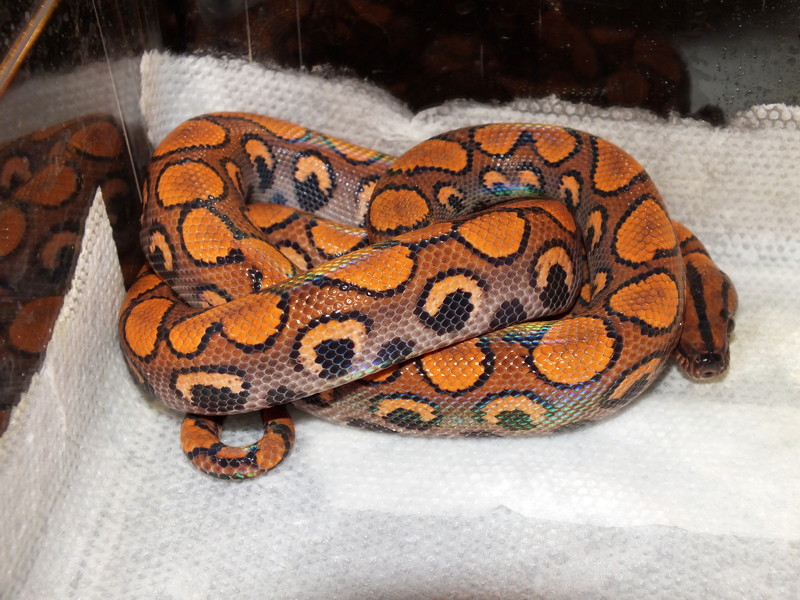 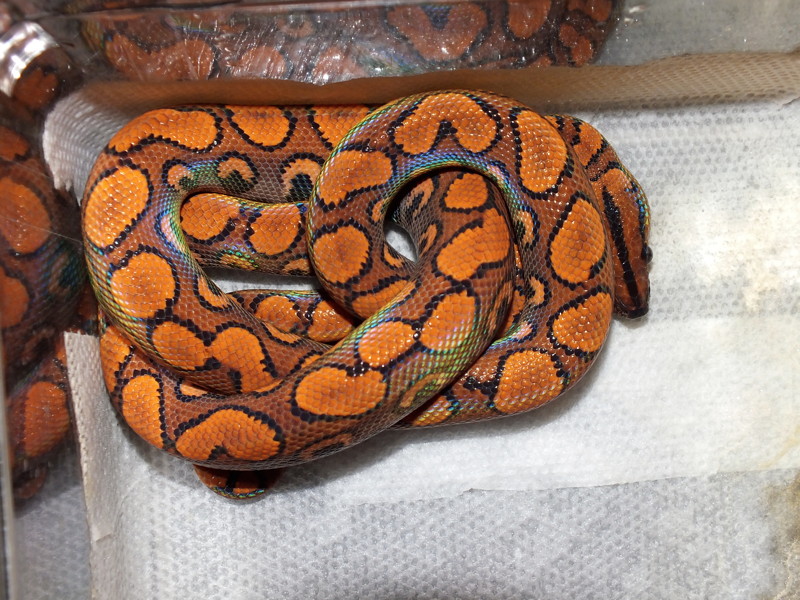 As of March 31, this little one had increased from a birth weight of 33 grams to 105 grams. ------ B-06 (Male) This fellow was one of the more placid members of his litter…right up until sexing day, the idea of which thrilled him not at all. Let’s just say he made up for lost time that evening. Sine then he’s settled back into his usual placid little self. Physically, he has several unique traits. On his back, he has two linked chains of two spots. On his right side, he has two departures from an otherwise solid crescent pattern, one eclipse and one merged dot, both in his neck area. On his left side, he also has two departures, one eclipse near his neck and one merged dot farther back. Finally, he has an interesting light patch on his lower right head, and a small black dot on his neck. At Birth This shot was taken in mid-September 2011. 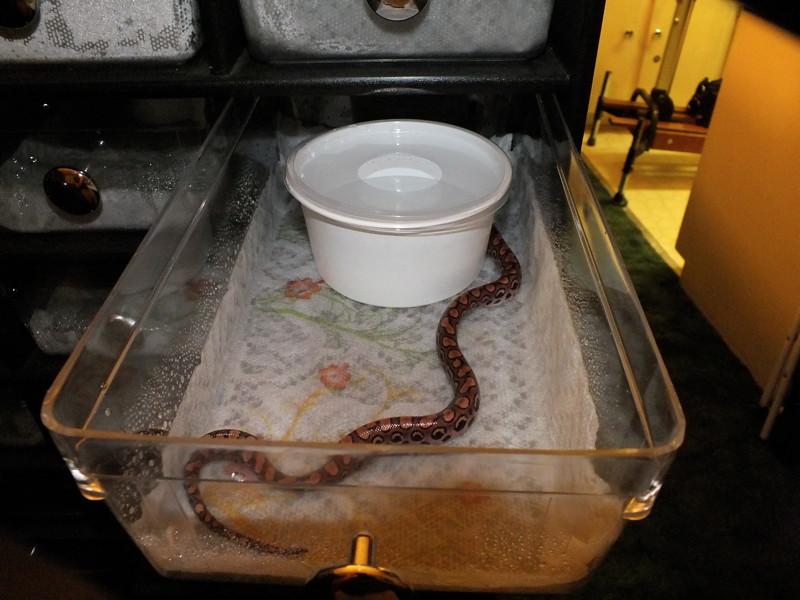 Post Shed This shot was taken in late September 2011. Apologies for the bad lighting; it was taken without formal prep. 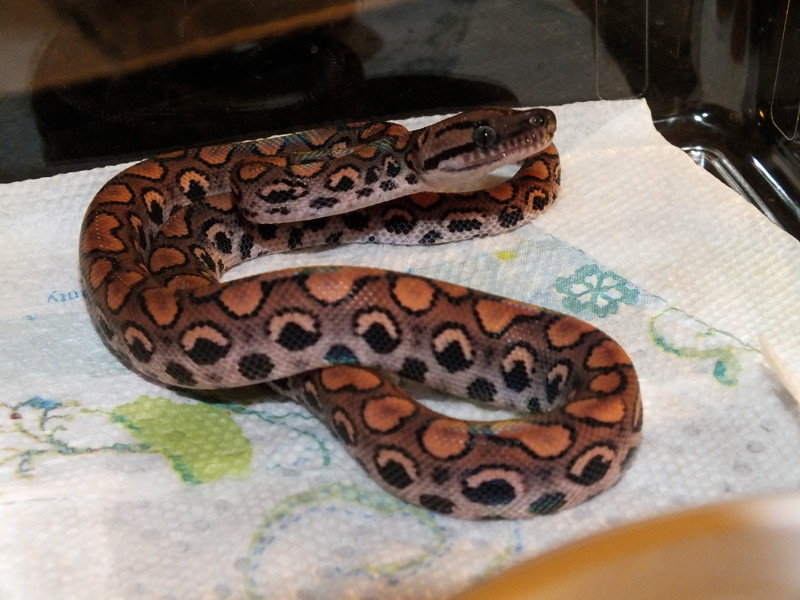 Formal Photo Session This series of shots was taken in early October 2011. Originally, these were to be the sale shots, but circumstances forced a long delay. This mini-set includes a front/right shot, a front/left shot, and a top shot.  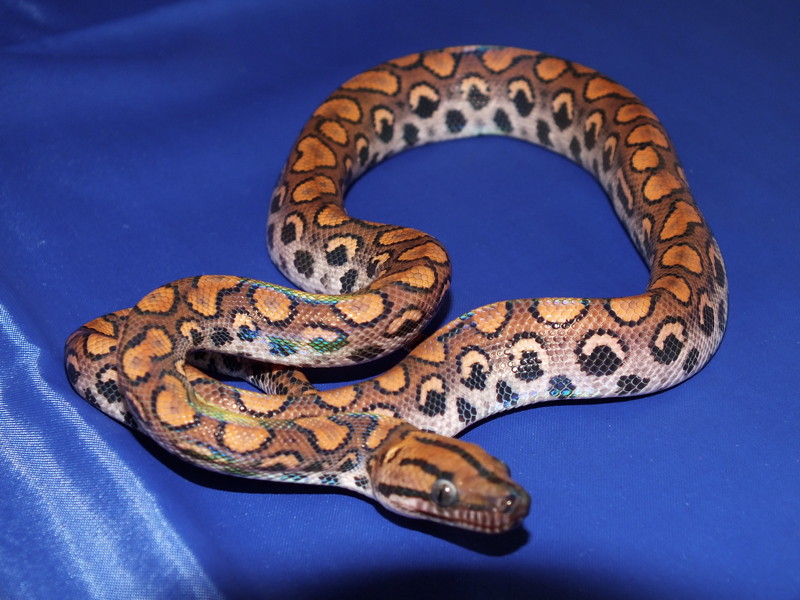  Three-Month Update This shot was taken in late December 2011 to late January 2012, and presents an updated view of the baby after the delay.  Six-Month Update These shots were taken in March 2012, and present a further updated view of the baby after the delay. This mini-set includes a front shot, a top shot, and a close-up head shot. 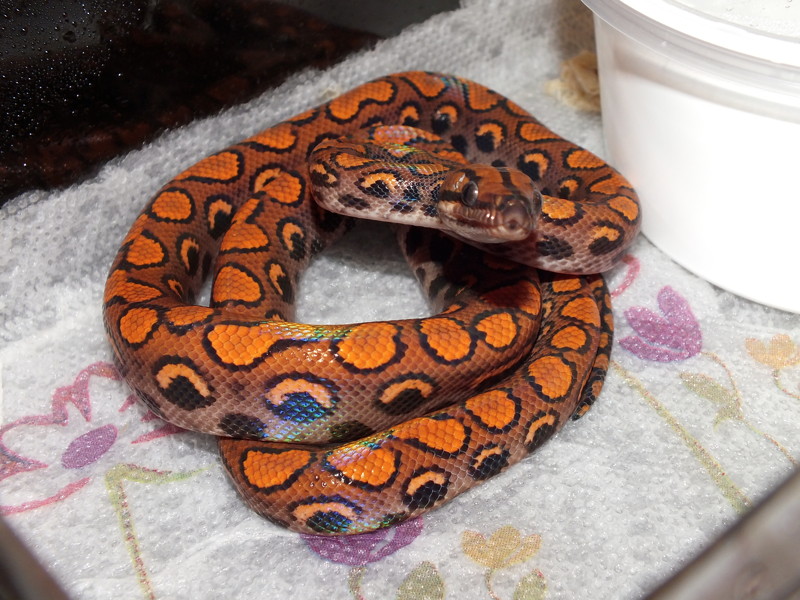 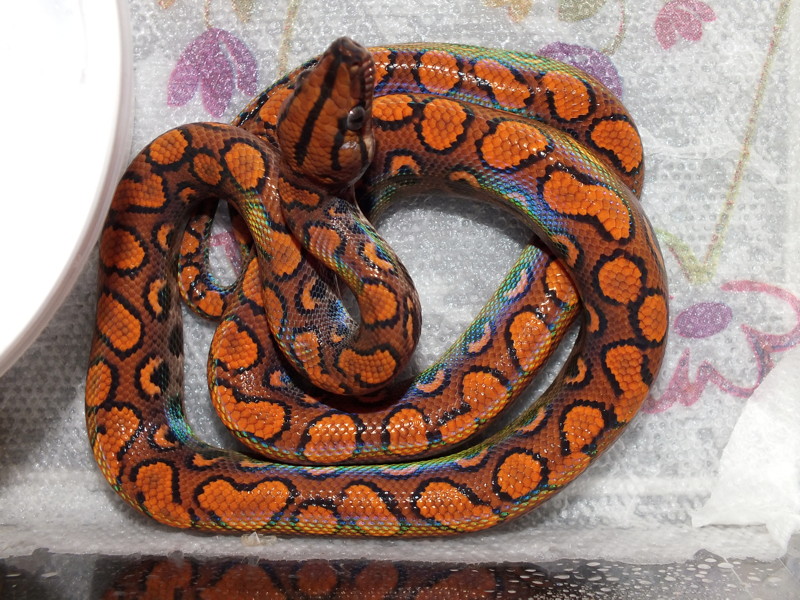 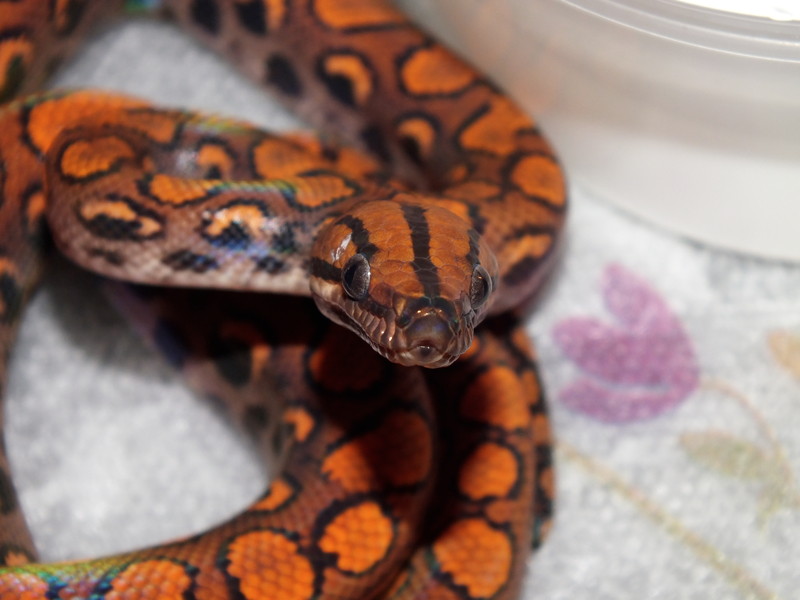 As of March 31, this little one had increased from a birth weight of 33 grams to 85 grams. ------ B-07 (Female) A perfectly normal, curious little female, this little lady has not revealed any personality quirks so far…though I’m sure she, as all baby Brazilians, has some just waiting to be discovered! Physically, she has several unique traits. On her back, she has two linked chains of three and two spots, respectively. On her left side, she has a 100% crescent pattern. On her right side, she has two departures from an otherwise solid crescent pattern: one merged dot and a series of three “bonus” black dots. Finally, she has an intriguing small black patch on her center line. At Birth This shot was taken in mid-September 2011. 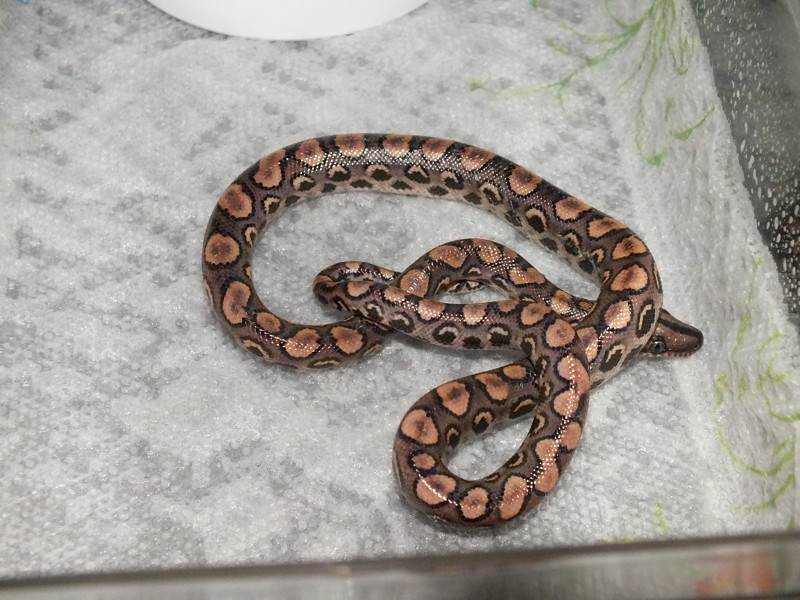 Post Shed This shot was taken in late September 2011. Apologies for the bad lighting; it was taken without formal prep. 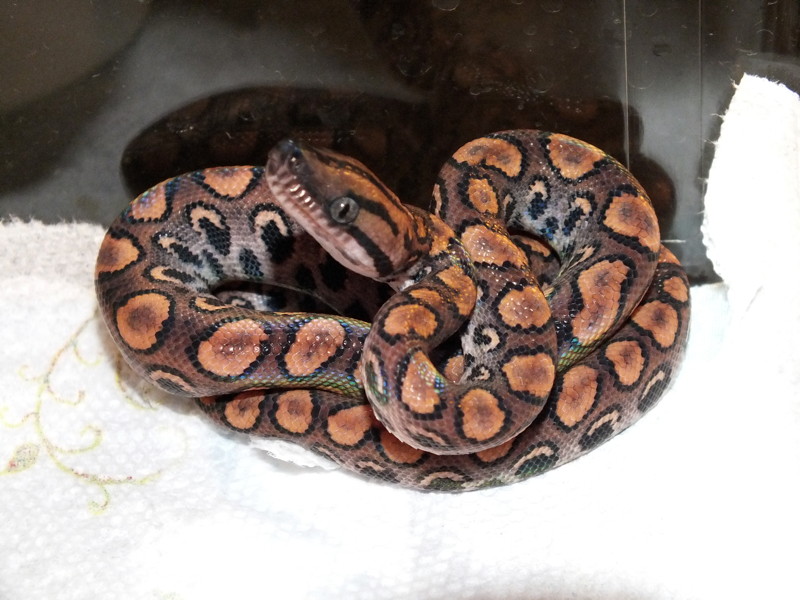 Formal Photo Session This series of shots was taken in early October 2011. Originally, these were to be the sale shots, but circumstances forced a long delay. This mini-set includes a front shot, a side shot, and a top shot. 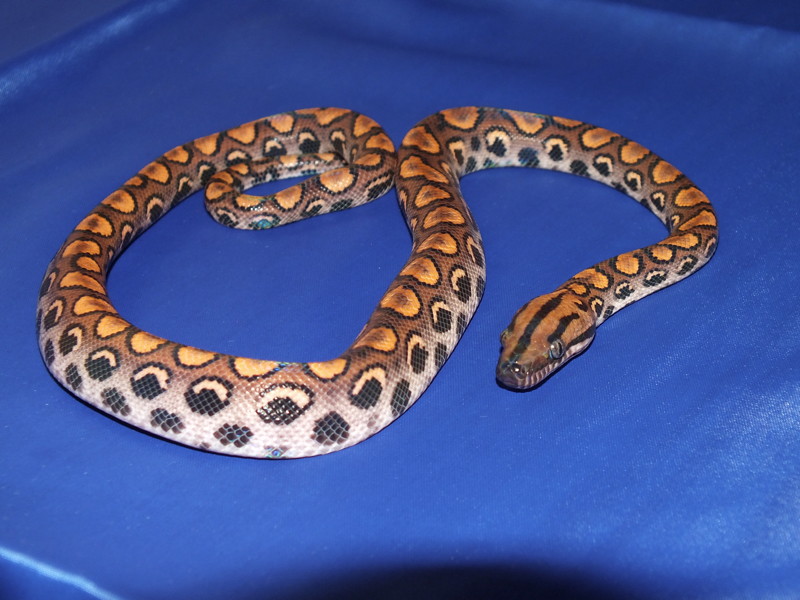 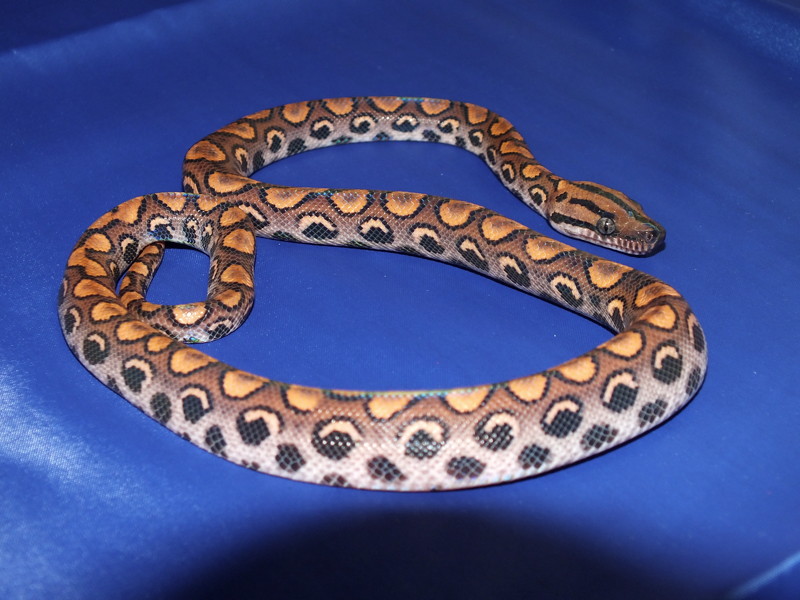  Three-Month Update These shots were taken in late December 2011 to late January 2012, and present an updated view of the baby after the delay. This mini-set includes a front shot and a top shot. 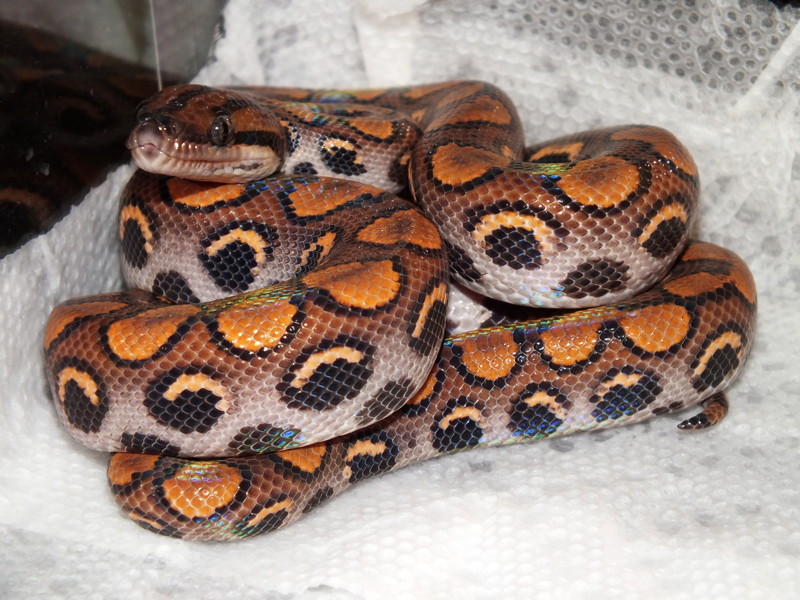 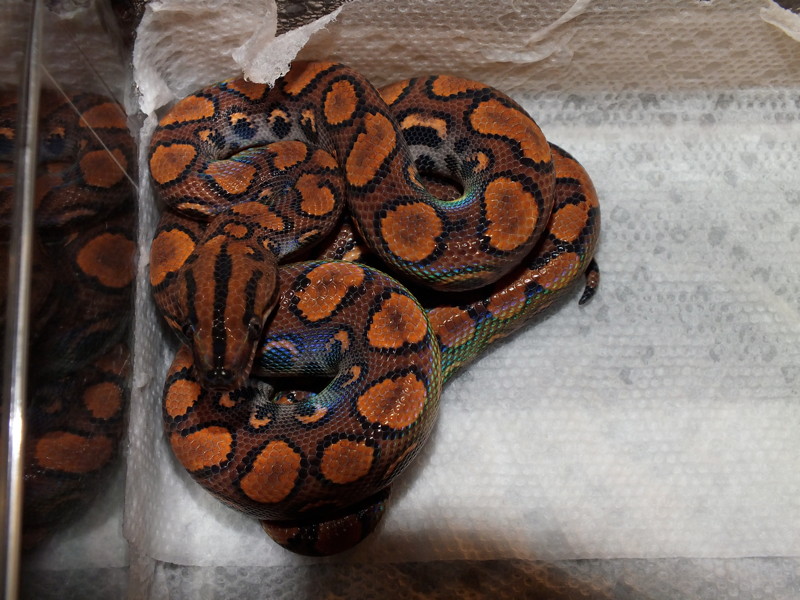 Six-Month Update These shots were taken in March 2012, and present a further updated view of the baby after the delay. This mini-set includes a side shot and a top shot.  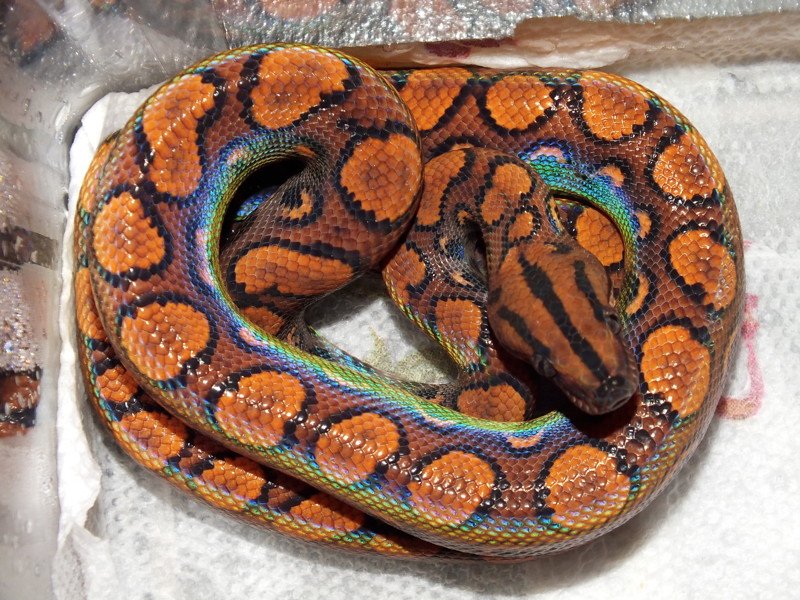 As of March 31, this little one had increased from a birth weight of 31 grams to 87 grams. ------ B-08 (Male) This little fellow is my lead male holdback candidate. He is one of the most calm and inquisitive babies in the litter. He was one of the first to move from “discovering” his meal to figuring out striking is good, and is now always front and center on feeding day! Physically, he has several unique traits. On his back, he has mad linking going on: one chain of three spots, five chains of two spots, and a massive line of touching spots that should merge with breeding. On his sides, he has a 100% crescent pattern -- a clean, classic look all the way -- with the single exception of a small Nike-ish “swoosh” on his right side. (Hmm, marketing deal?) At Birth This shot was taken in mid-September 2011. 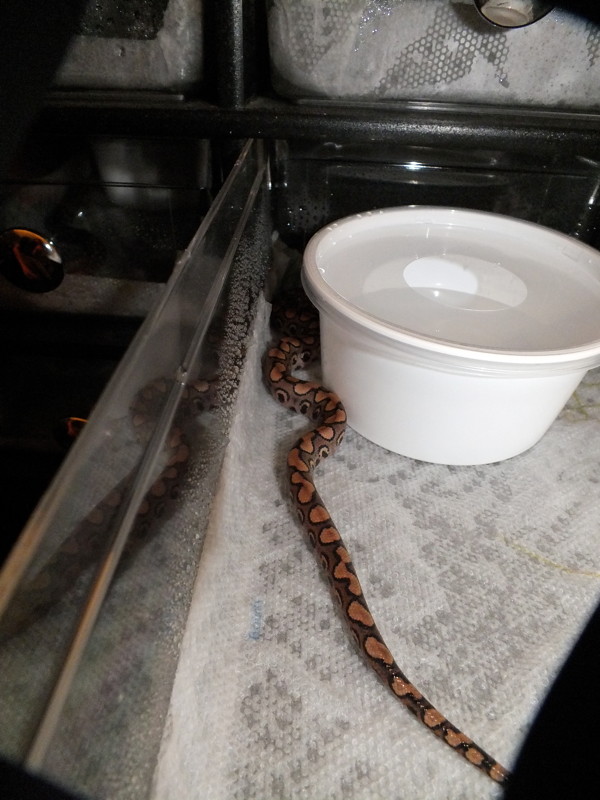 Post Shed This shot was taken in late September 2011. Apologies for the bad lighting; it was taken without formal prep.  Formal Photo Session This series of shots was taken in early October 2011. Originally, these were to be the sale shots, but circumstances forced a long delay. This mini-set includes a front shot, a side shot, and a top shot. 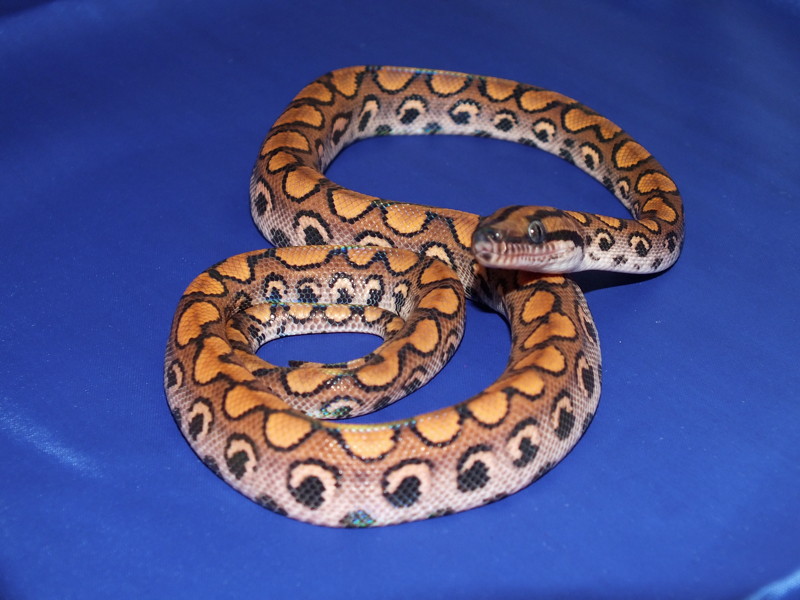   Three-Month Update These shots were taken in late December 2011 to late January 2012, and present an updated view of the baby after the delay. This mini-set includes a side shot and a top shot.  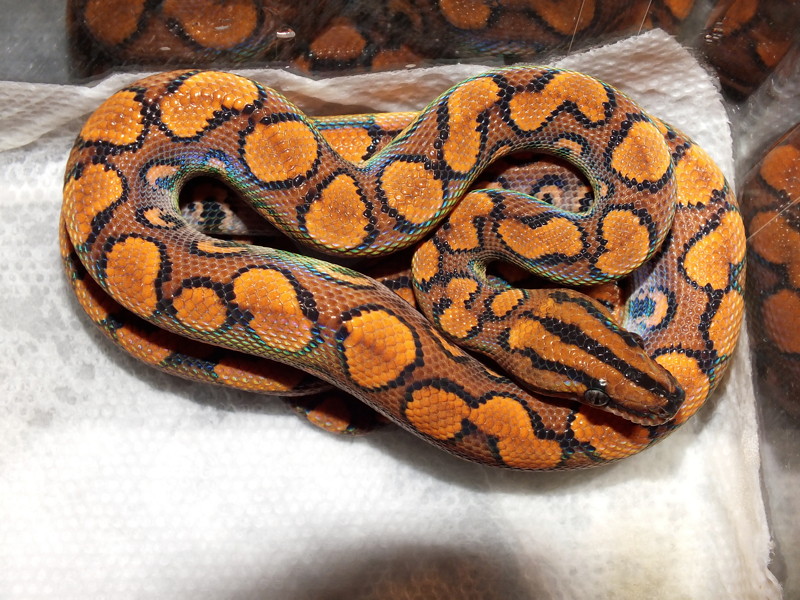 Six-Month Update These shots were taken in March 2012, and present a further updated view of the baby after the delay. This mini-set includes a side shot and a top shot. 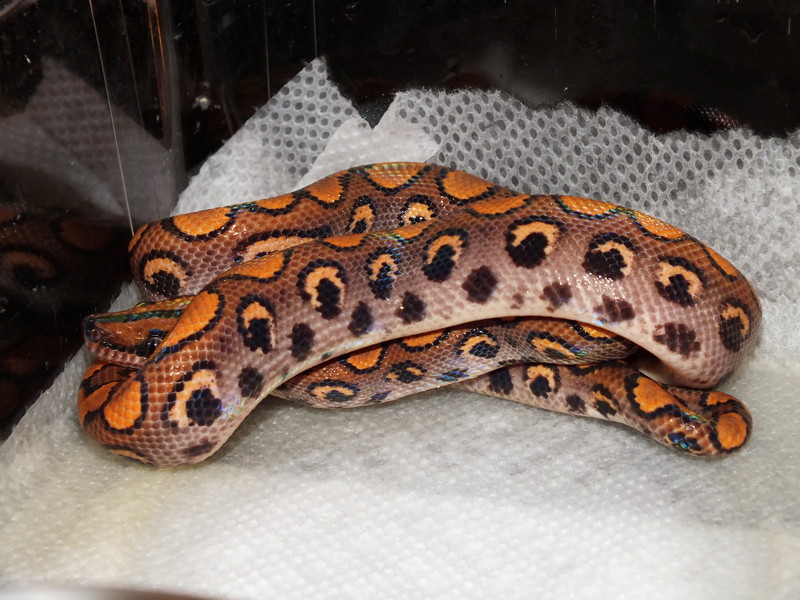 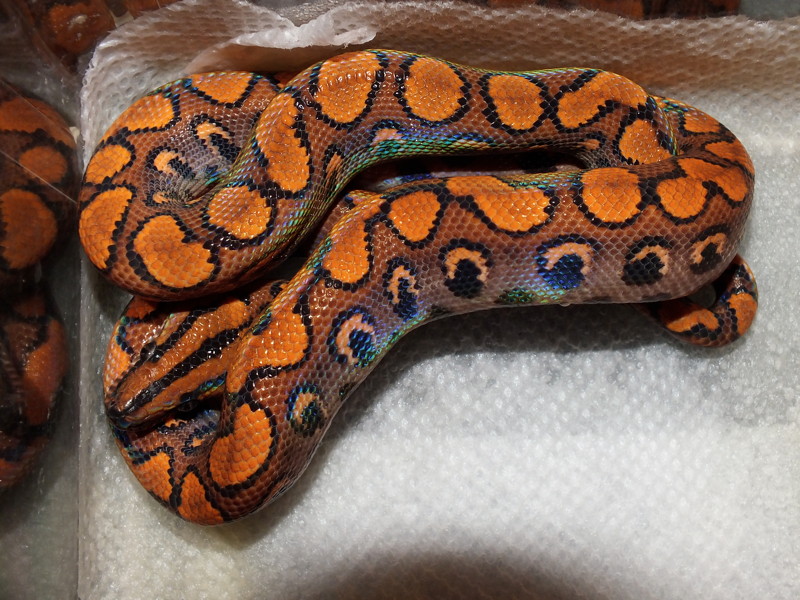 As of March 31, this little one had increased from a birth weight of 34 grams to 92 grams. ------ B-09 (Female) Like her brother #08, this little one is both calm and inquisitive. She was also one of the first to move from “discovering” her meal to figuring out striking is good! Physically, this little one has several unique traits. On her back, she has five linked chains of two spots, and eight or nine touching dots that could be moldable into a chain with breeding. On her left side, she has a 100% crescent pattern. On her right side, she has three departures from an otherwise solid crescent pattern, all merged dots. Finally, she has a small black dot on her neck. At Birth This shot was taken in mid-September 2011.  Post Shed This shot was taken in late September 2011. Apologies for the bad lighting; it was taken without formal prep. 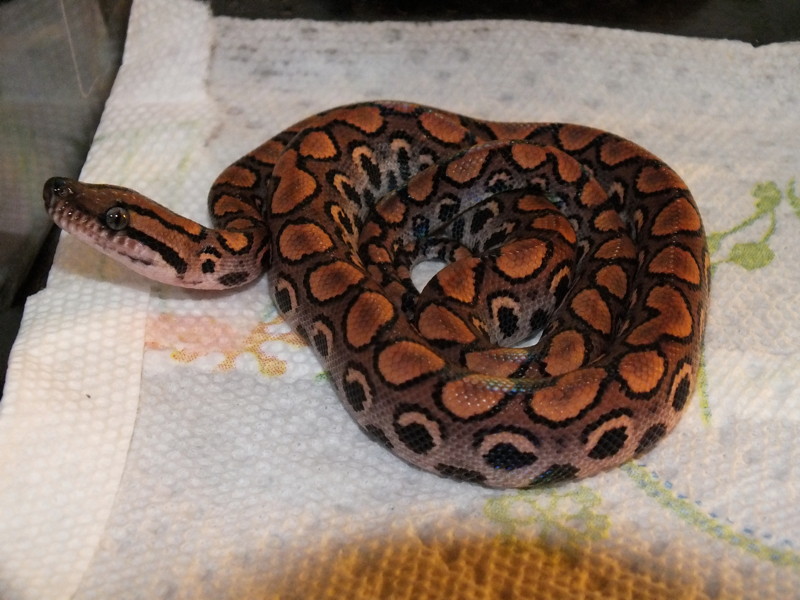 Formal Photo Session This series of shots was taken in early October 2011. Originally, these were to be the sale shots, but circumstances forced a long delay. This mini-set includes a front shot, a side shot, a top shot, and a close-up head shot.  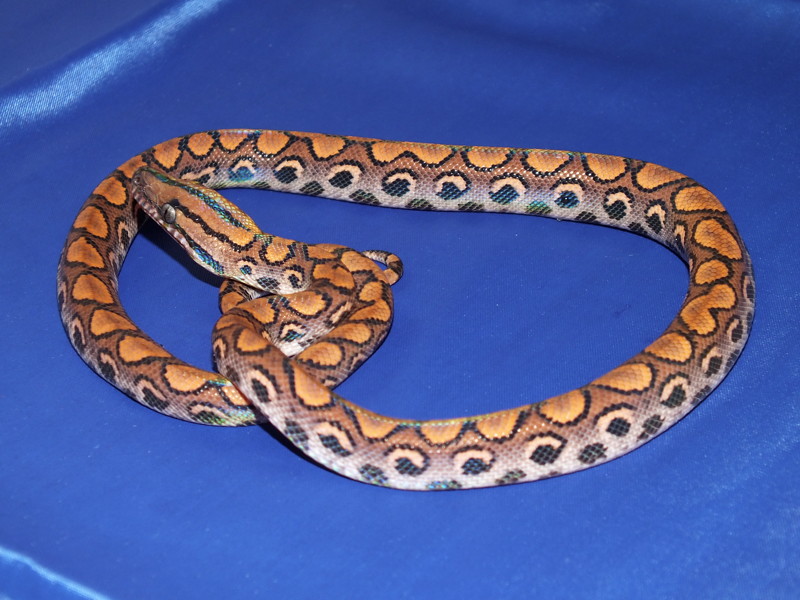 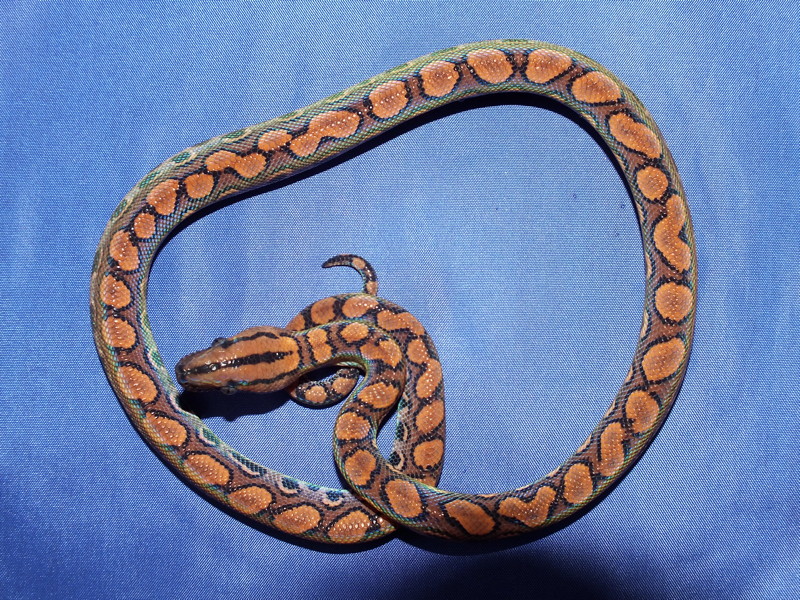  Three-Month Update These shots were taken in late December 2011 to late January 2012, and present an updated view of the baby after the delay. This mini-set, taken in the scale because she was being squirmy, includes a top shot and paired head/body shots.  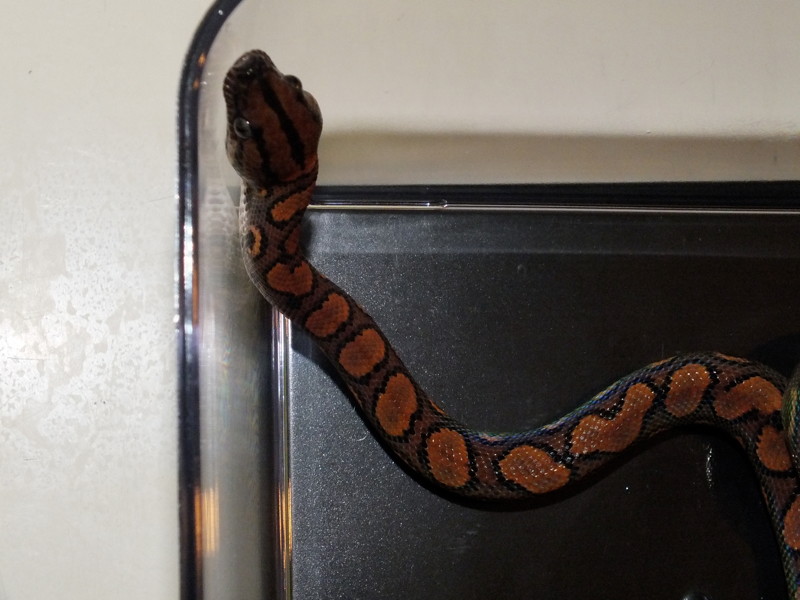 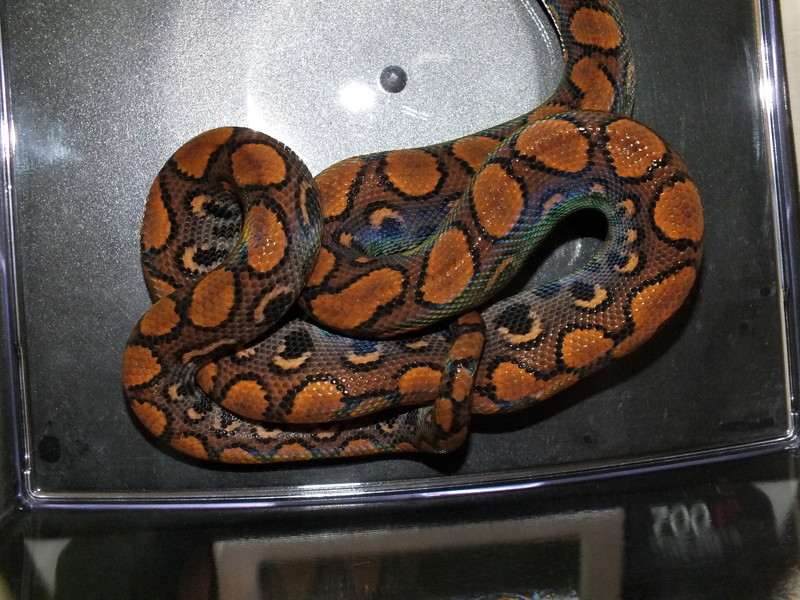 Six-Month Update These shots were taken in March 2012, and present a further updated view of the baby after the delay. This mini-set includes a front shot, a top shot, and a head/upper body shot. Note the first shot came out oddly dark. 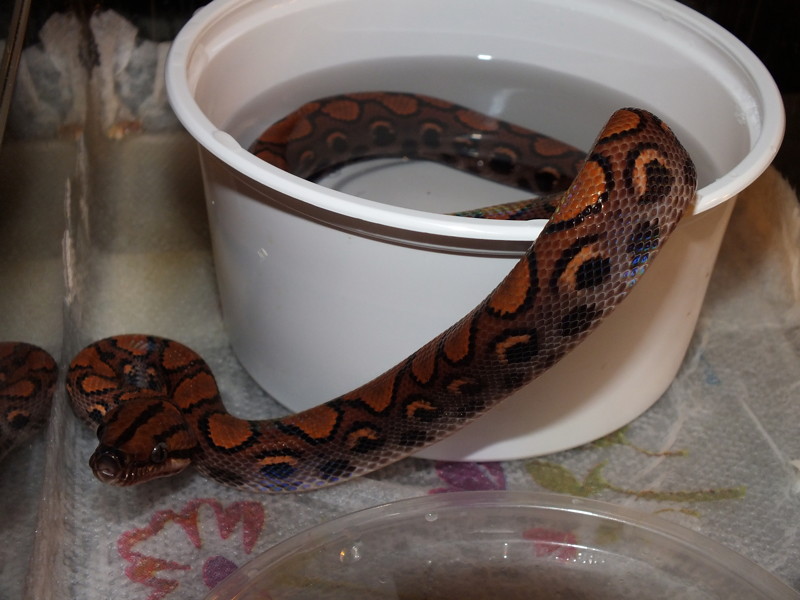 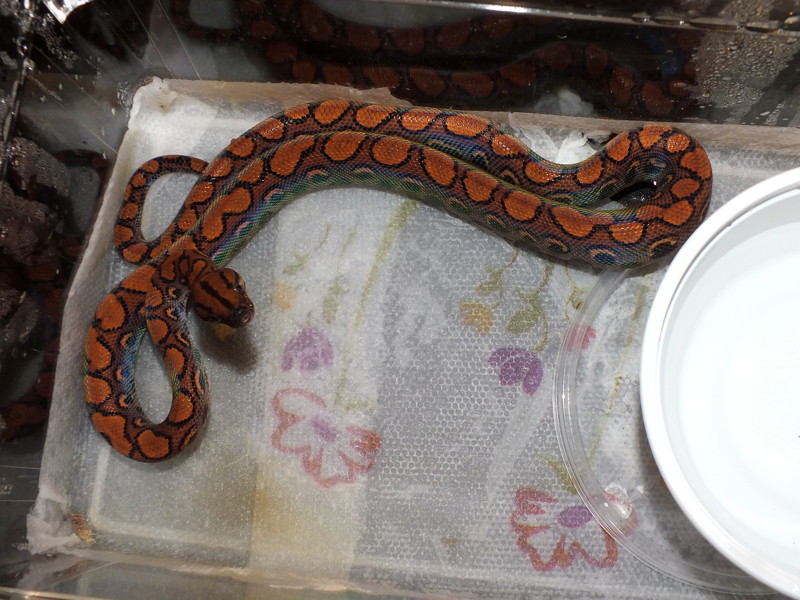  As of March 31, this little one had increased from a birth weight of 33 grams to 87 grams. ------ B-10 (Female) This little girl was both amazingly calm and amazingly active during the pattern inspection -- constantly curious and on the move while I looked her over. She also holds the “bathroom mess” award of her litter, once managing to sully her entire drawer within 24 hours of its being cleaned. Physically, she has several unique traits. Her dorsal borders lines are rather broken and irregular, especially in her neck area, which make counting difficult. Nevertheless, she has two linked chains of three and two spots, respectively. On her left side, she has a 100% crescent pattern, and the black portion of one of these travels down to fuse with the nearby bottom half-spot. On her right side, she has one departure from an otherwise solid crescent pattern, a merged dot. Finally, she has a medium black triangle on her lower back, a mark taken straight from her sire. At Birth These shots were taken in mid-September 2011. The first shot was taken shortly after birth, and captured her practicing her gymnastics skills. 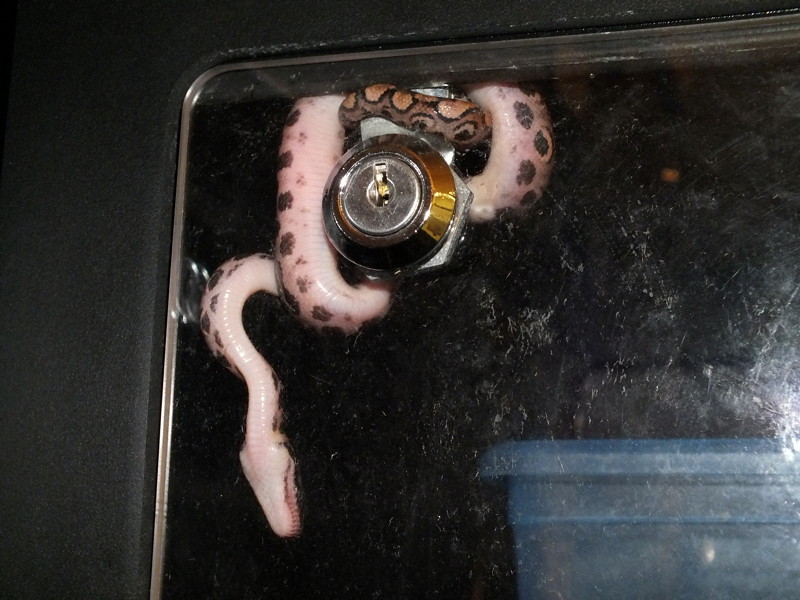 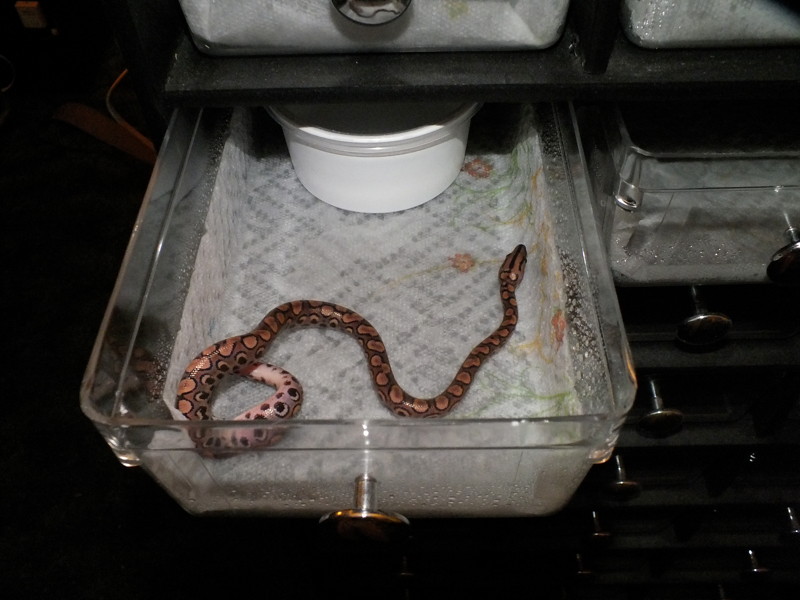 Post Shed This shot was taken in late September 2011. Apologies for the bad lighting; it was taken without formal prep. 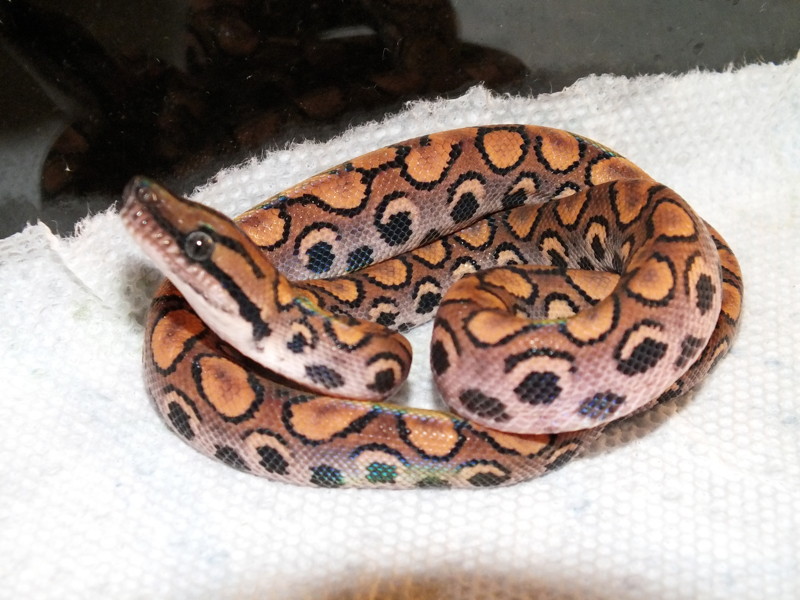 Formal Photo Session This series of shots was taken in early October 2011. Originally, these were to be the sale shots, but circumstances forced a long delay. This mini-set includes a side shot, a back shot, a top shot, and a close-up head shot. 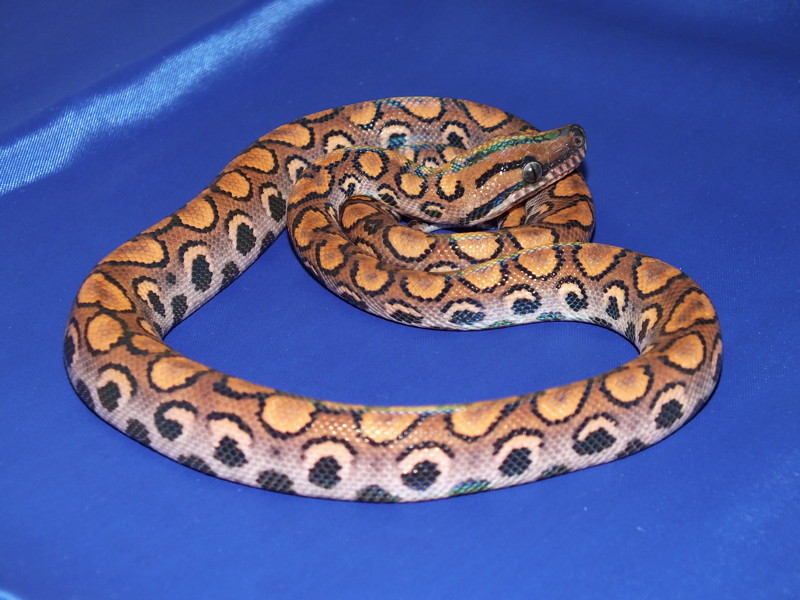 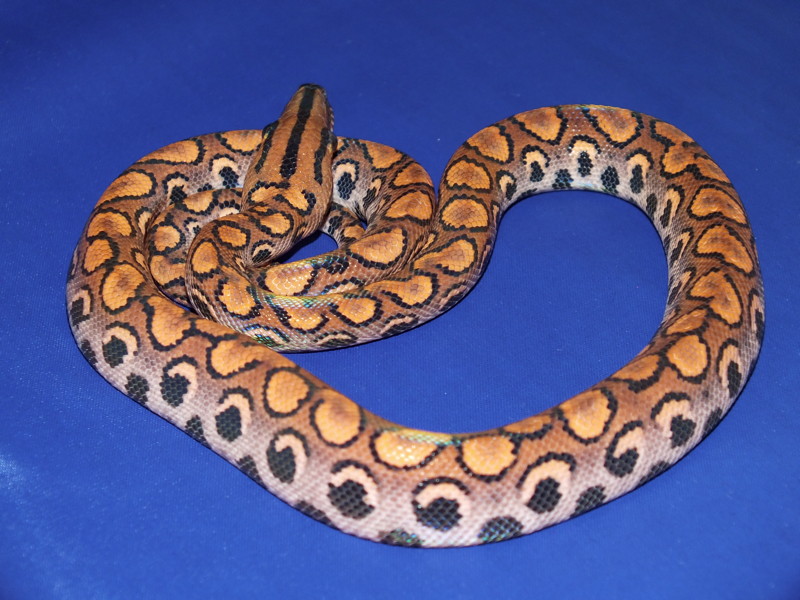  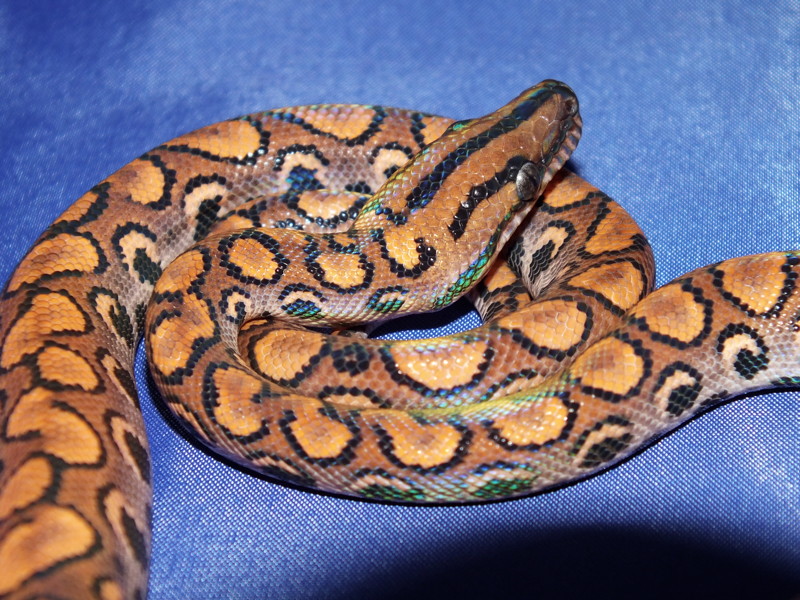 Four-Month Update These shots were taken in late December 2011 to late January 2012, and present an updated view of the baby after the delay. This mini-set includes a side shot and a top shot.  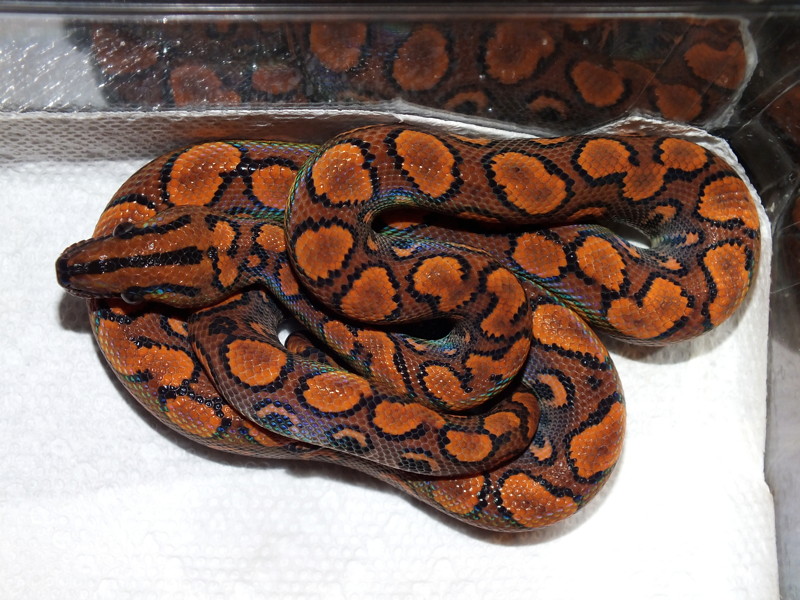 Six-Month Update These shots were taken in March 2012, and present a further updated view of the baby after the delay. This mini-set includes a front shot, a top shot, and a close-up head shot. 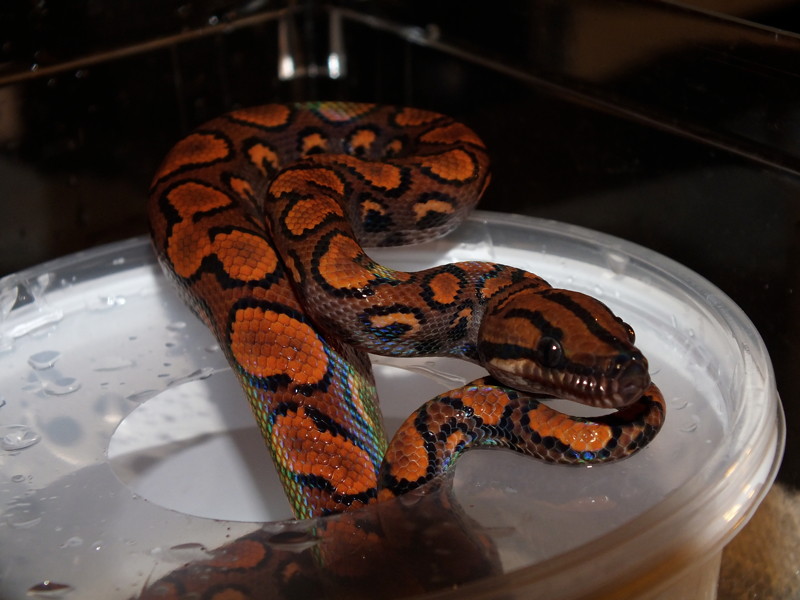 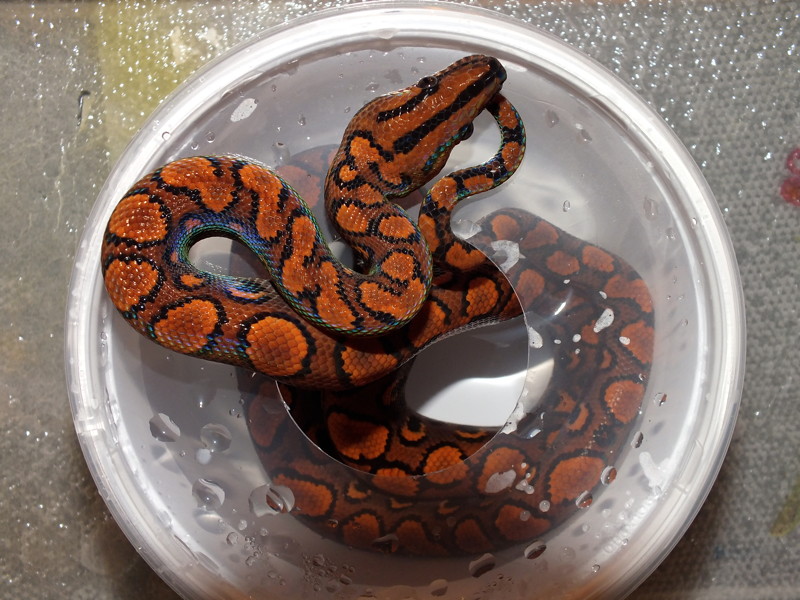 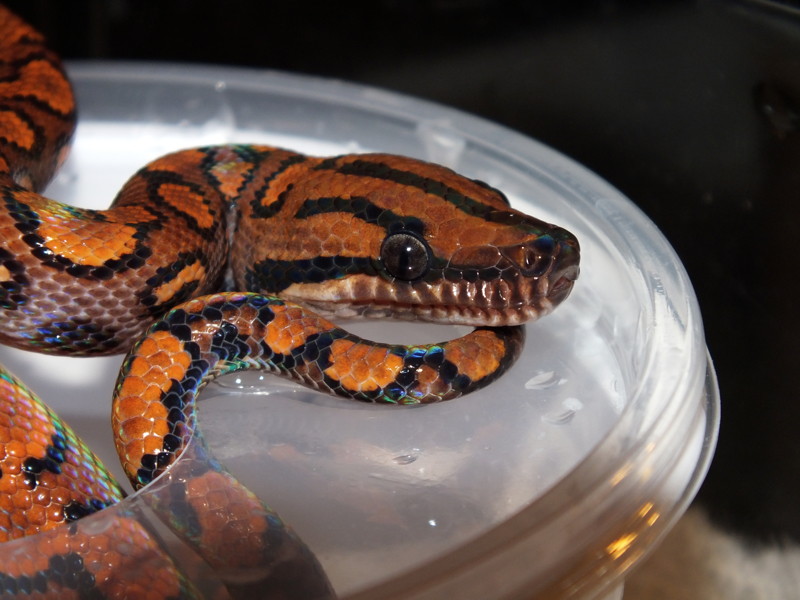 As of March 31, this little one had increased from a birth weight of 33 grams to 87 grams. ------ B-11 (Male) This little guy is another of the calm but active ones, who would not sit still during the pattern inspection, or many cleaning sessions. Physically, he has several unique traits. He has a lighter-colored head, which can be an indicator of good things to come On his back, he has a whopping five linked chains of four spots (once), three spots (once), and two spots (thrice), respectively. On his right side, he has a 100% crescent pattern (though three of them arguably lean eclipse). On his left side, he has three departures from an otherwise solid crescent pattern, all eclipses. At Birth These shots were taken in mid-September 2011. The first shot was taken shortly after birth, and captured him practicing even more impressive gymnastics skills than his sister. 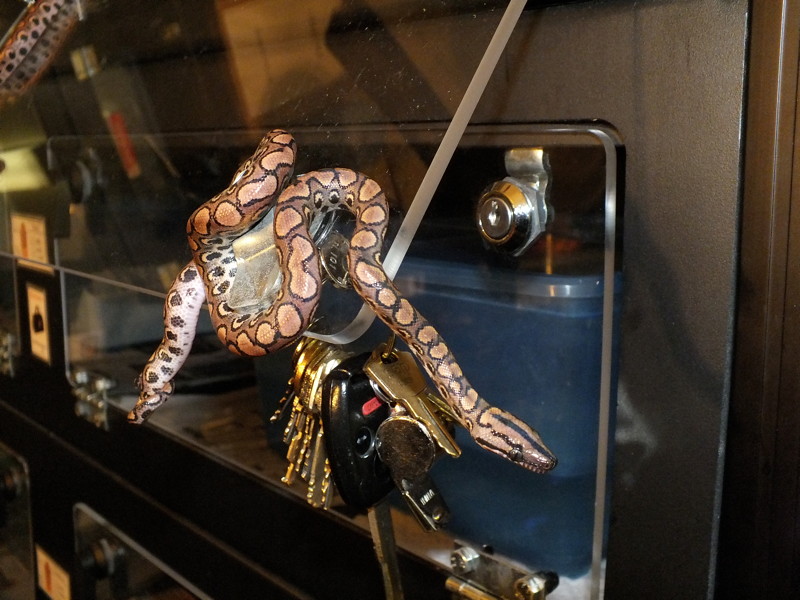 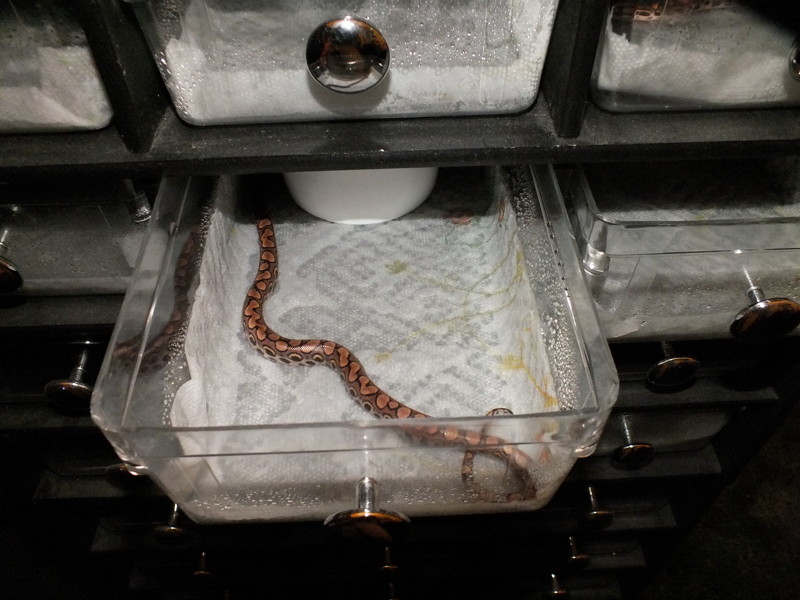 Post Shed This shot was taken in late September 2011. Apologies for the bad lighting; it was taken without formal prep. 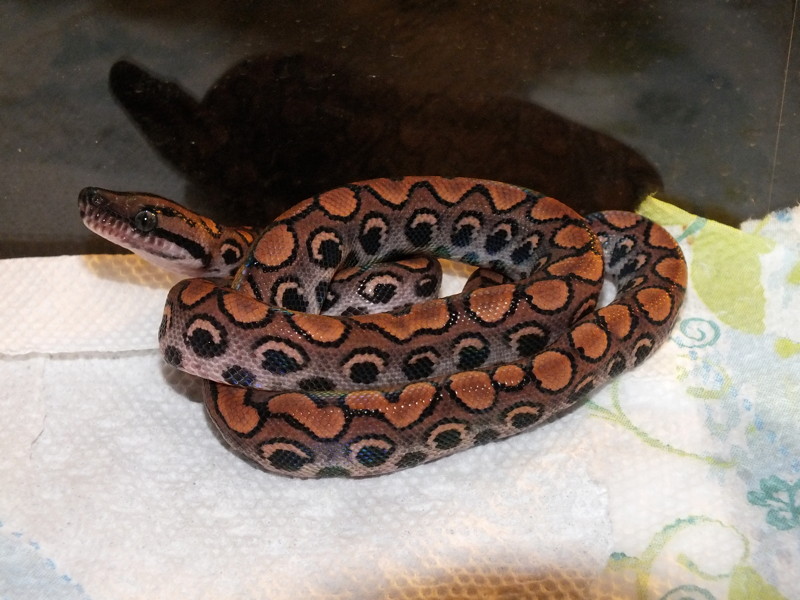 Formal Photo Session This series of shots was taken in early October 2011. Originally, these were to be the sale shots, but circumstances forced a long delay. This mini-set includes a front shot, a side shot, a top shot, and a close-up head shot. 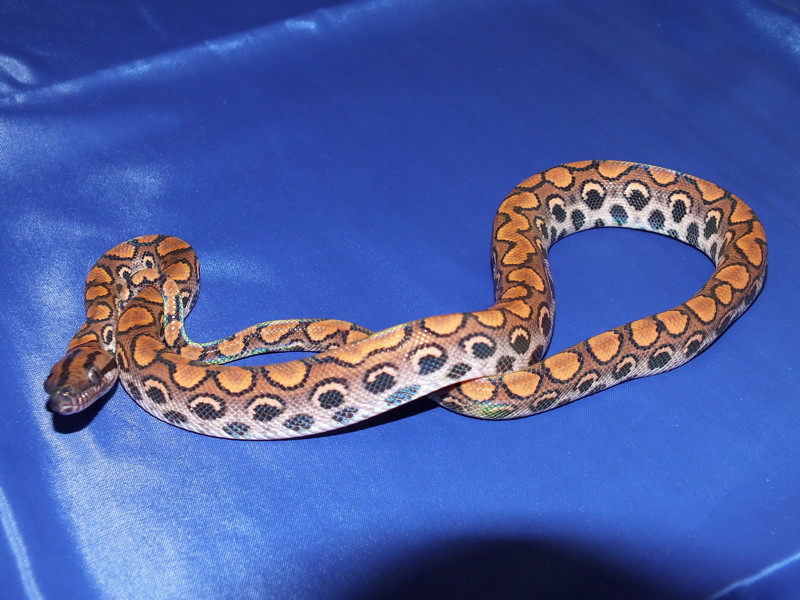 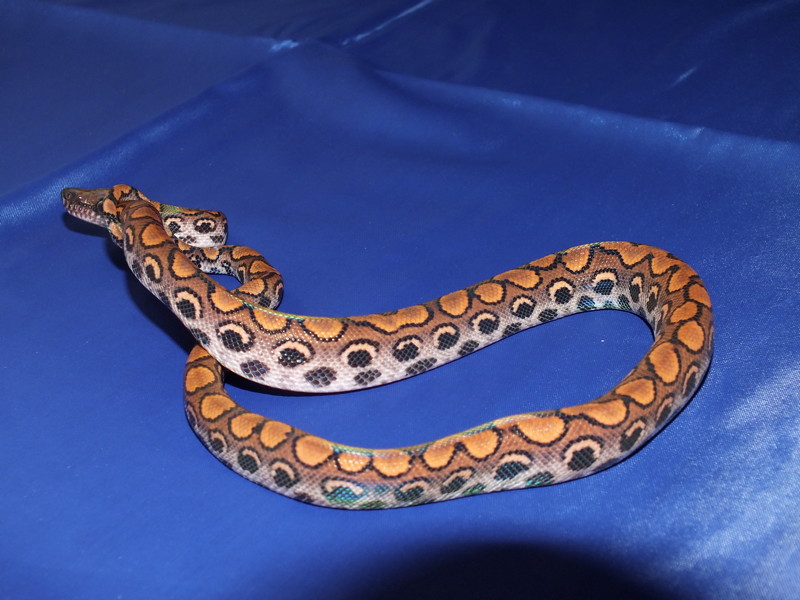 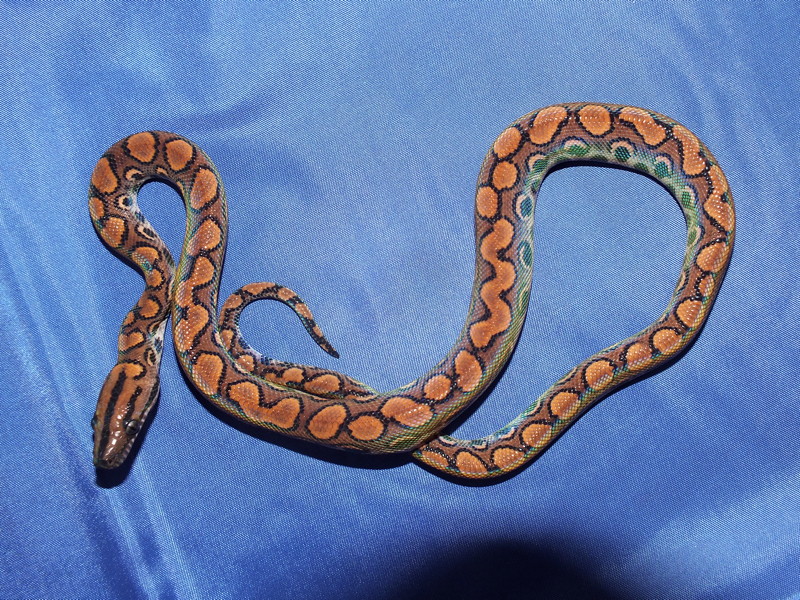 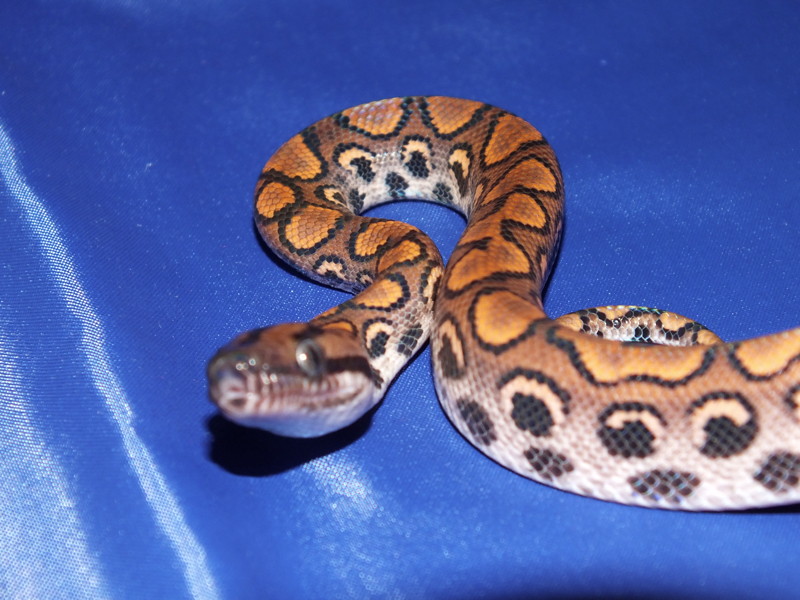 Four-Month Update These shots were taken in late December 2011 to late January 2012, and present an updated view of the baby after the delay. This mini-set includes a front/side shot and a top shot. 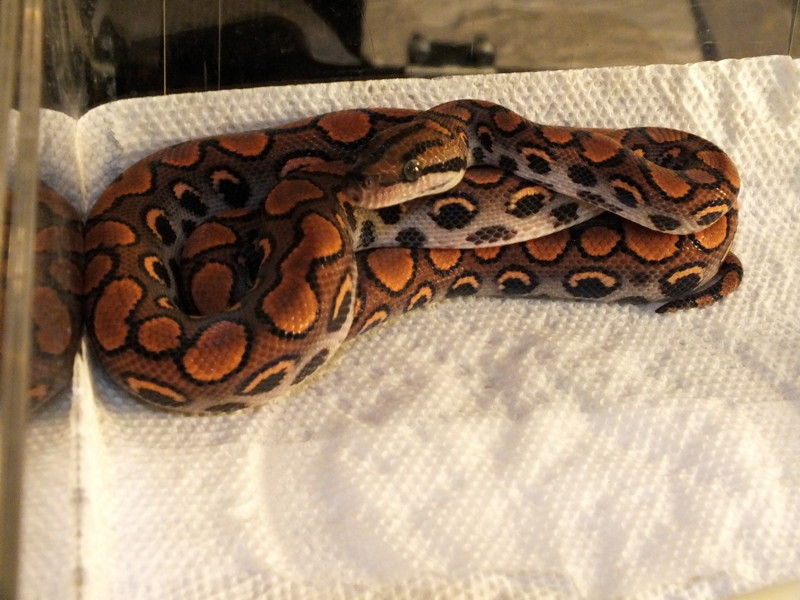 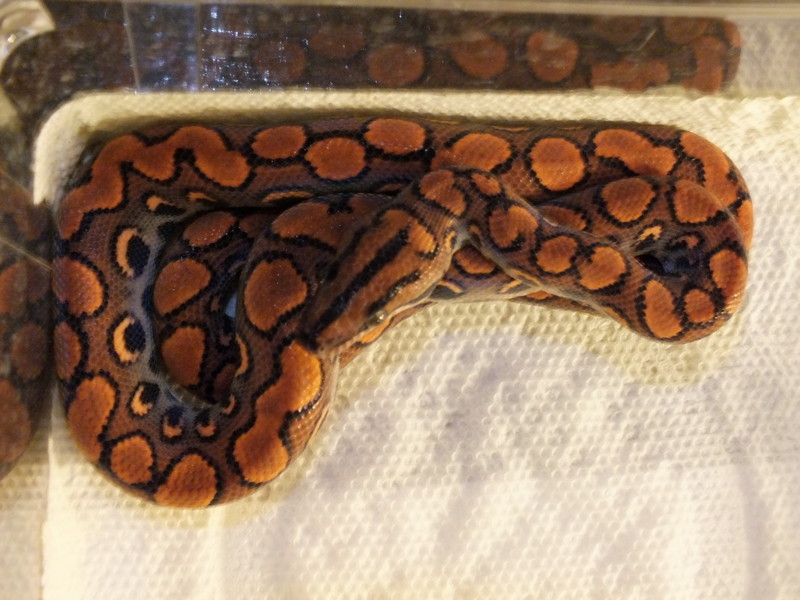 Six-Month Update These shots were taken in March 2012, and present a further updated view of the baby after the delay. This mini-set includes a front/side shot, a top shot, and a close-up head shot.   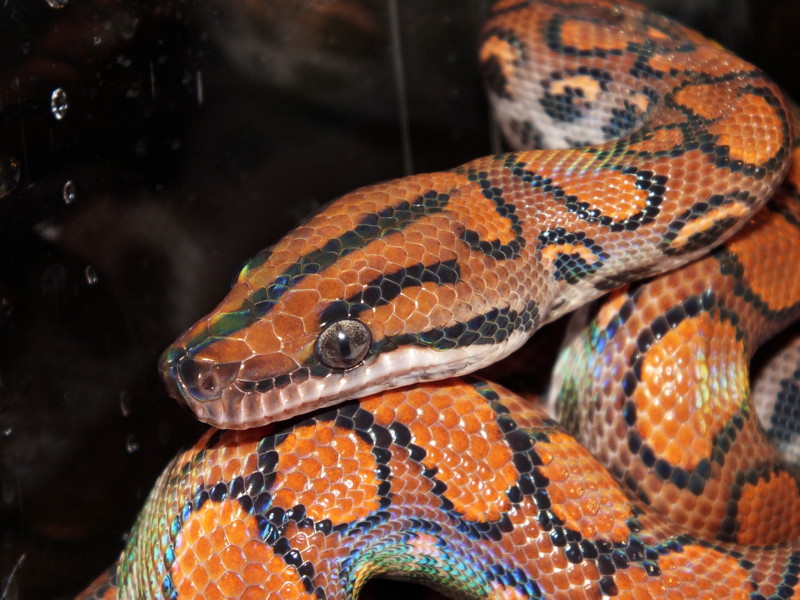 As of March 31, this little one had increased from a birth weight of 34 grams to 90 grams. ------ B-12 (Female) This little lady was one of the spunkiest of her litter for a long time, all wriggle and teeth. With time and care, however, she has calmed down nicely. She is also the pickiest feeder of her litter. Since we started the litter on rats at birth, rats are what she has decided she will eat: I can leave a mouse in there all day, and she will turn her nose up at it; but if I switch it for a rat, the meal is in her belly right away! She will also pass on meals due to impending shed -- perfectly normal, but the only one in her litter to regularly do so. (She has happily accepted “proper” makeup meals in most of these cases, meaning if I follow her very specific “instructions” on prey type.) Physically, she has several unique traits. On her back, she has three to five linked chains of two spots (two are highly probable, depending on how the viewer judges these things). On her sides, she has a 100% crescent pattern -- a clean, classic look all the way. Finally, she has three small black spots on her back (one small on her neck, one small on her back, and one medium on her back), all derived from her sire’s branch of the family tree. At Birth This shot was taken in mid-September 2011. 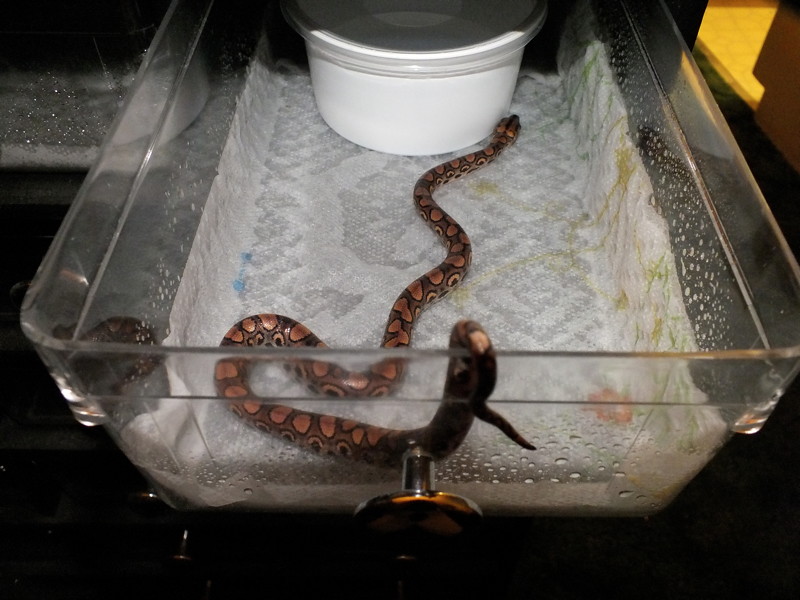 Post Shed This shot was taken in late September 2011. It’s a pretty cute she as she checks out the camera for the first time. Apologies for the bad lighting; it was taken without formal prep. 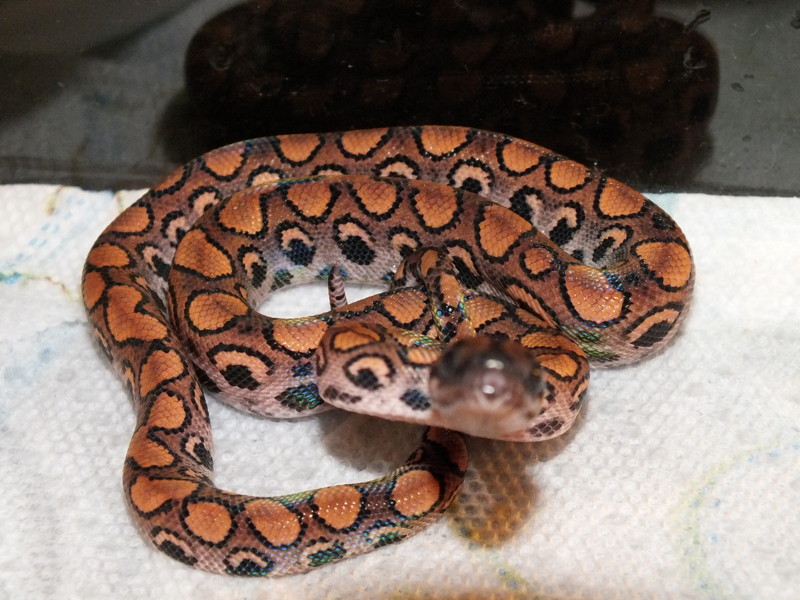 Formal Photo Session This series of shots was taken in early October 2011. Originally, these were to be the sale shots, but circumstances forced a long delay. This mini-set includes a front left shot, a front right shot, a top shot, and a close-up head shot. 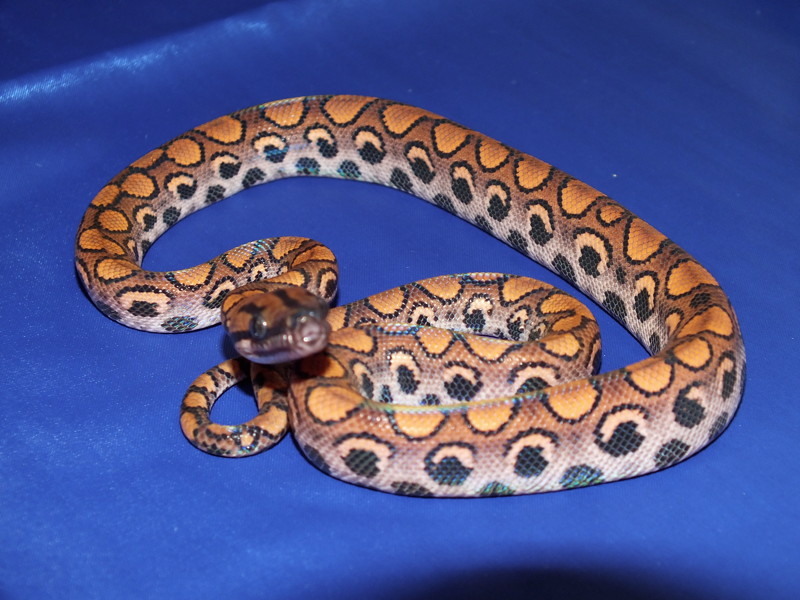 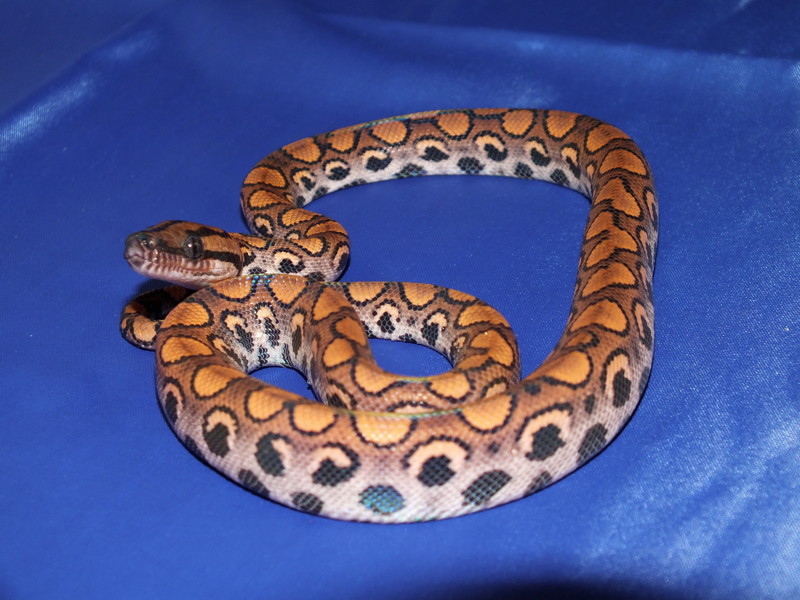   Four-Month Update These shots were taken in late December 2011 to late January 2012, and present an updated view of the baby after the delay. This mini-set includes a front shot and a top shot. 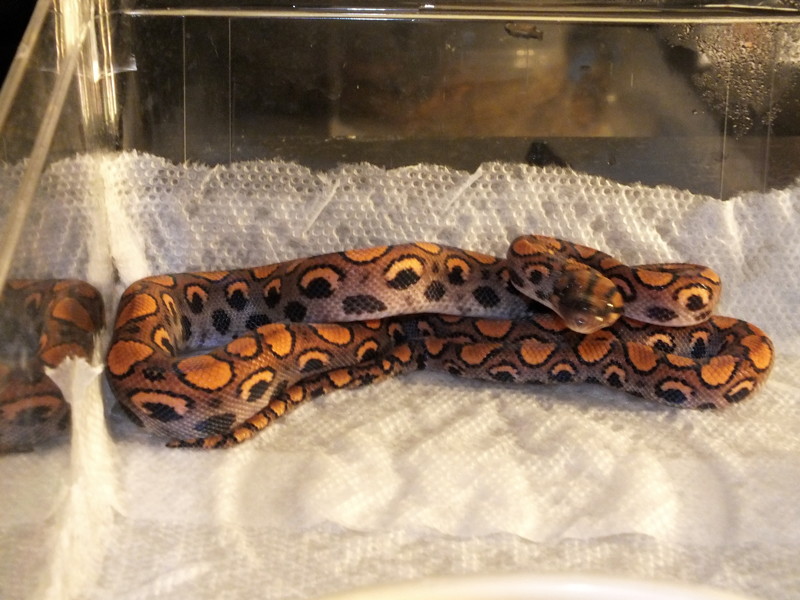 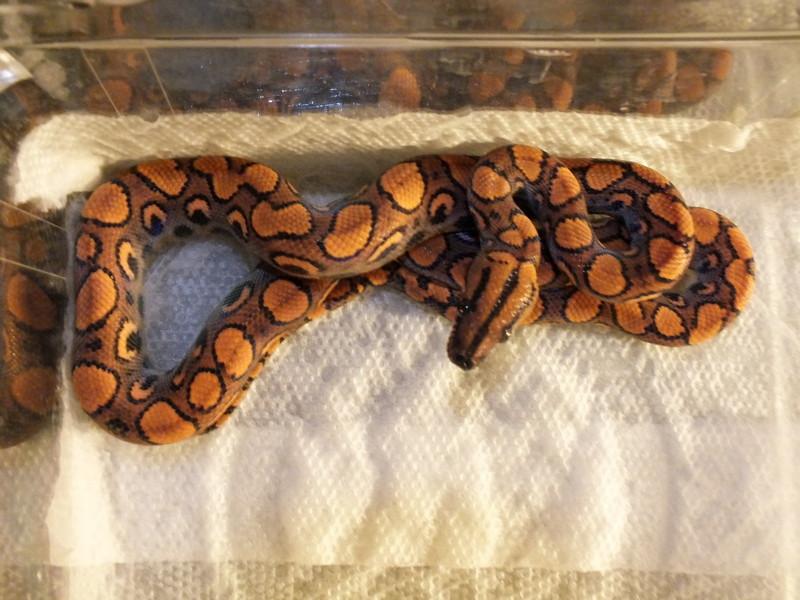 Six-Month Update These shots were taken in March 2012, and present a further updated view of the baby after the delay. This mini-set includes a side shot, a top shot, and a close-up head shot. 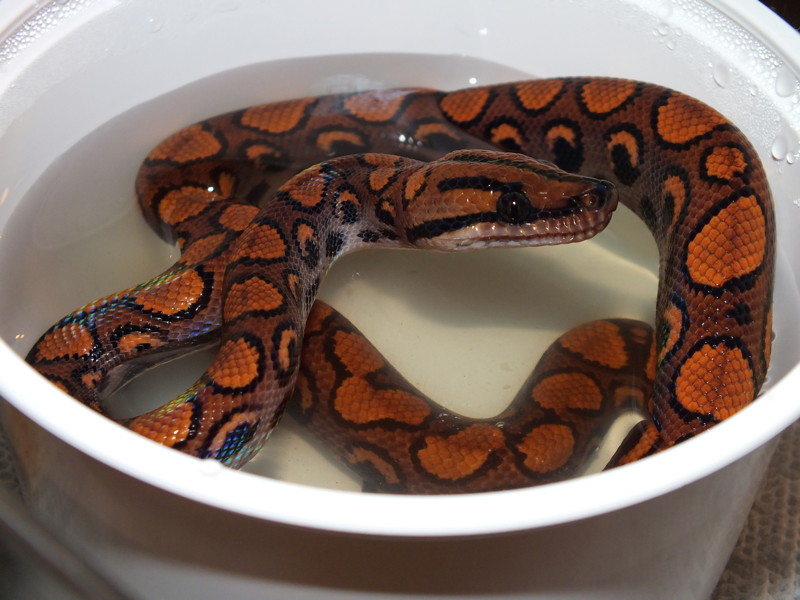 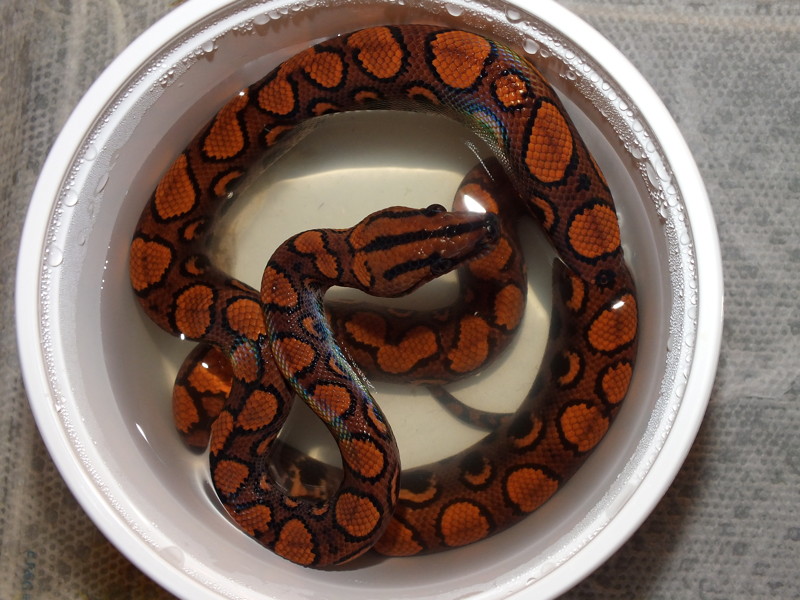 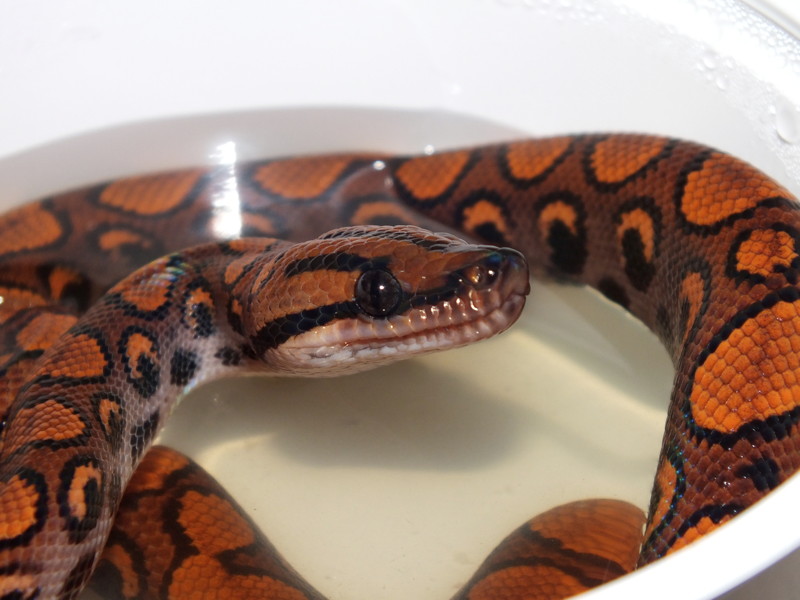 As of March 31, this little one had increased from a birth weight of 31 grams to 78 grams. ------ B-13 (Female) This girl was probably the calmest member of her litter for a long time, not biting me a single time, even on sexing day…right up until the night I typed this sentence. Since then, she has shown more attitude -- she wins the litter’s “most likely to nip when being picked up” award -- but is still a total sweetheart once you do. Physically, she has several unique traits. On her back, she has thick border lines compared to her littermates, and a single linked chain of two (almost three) spots. On her right side, she has one departure from an otherwise solid crescent pattern, an eclipse. On her left side, she has one departure from an otherwise solid crescent pattern, again an eclipse. At Birth These shots were taken in mid-September 2011. The first shot was taken shortly after birth, and captured her exploring the viv with Mom. The second is a (slightly) later shot, after she was placed in her own drawer-home. 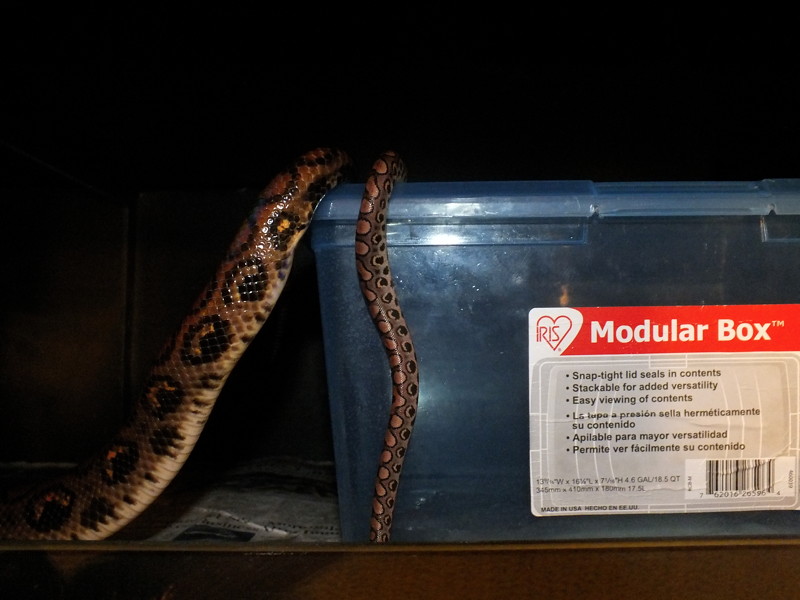 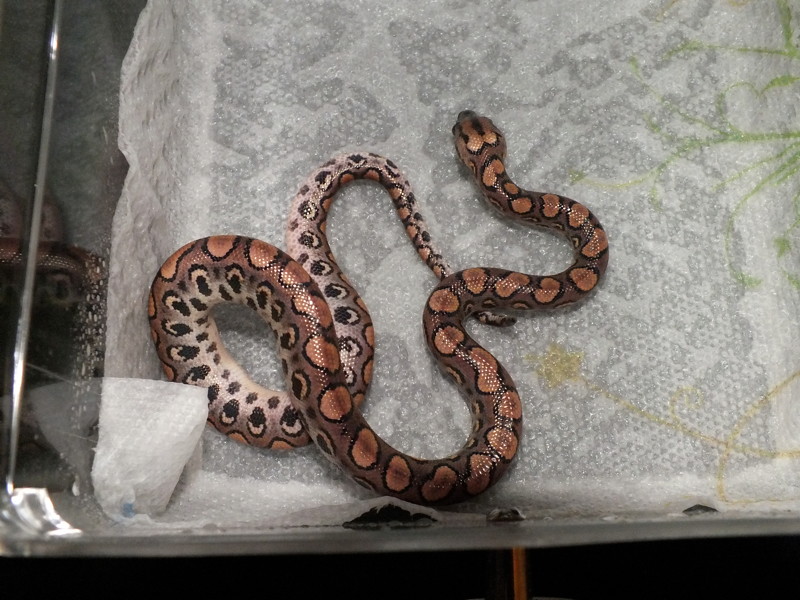 Post Shed This shot was taken in late September 2011. Apologies for the bad lighting; it was taken without formal prep. 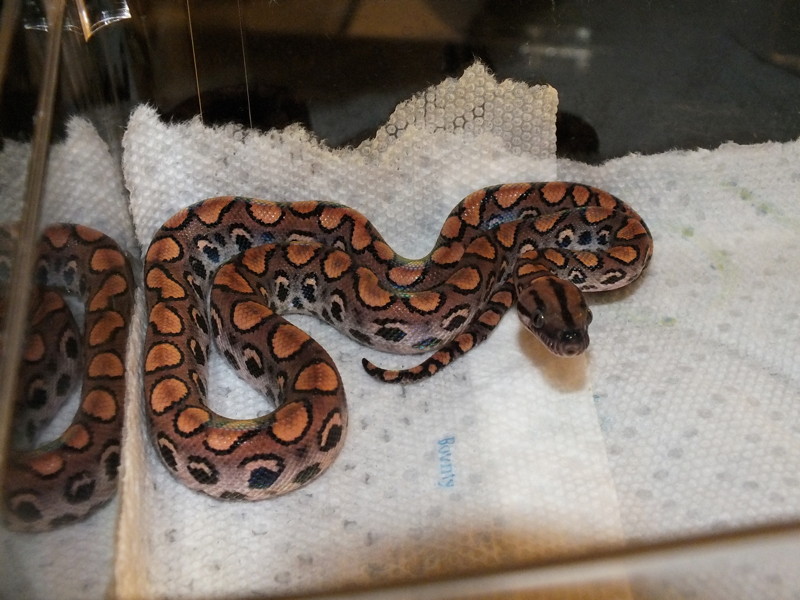 Formal Photo Session This series of shots was taken in early October 2011. Originally, these were to be the sale shots, but circumstances forced a long delay. This mini-set includes a front/side shot, a side/rear shot, a top shot, and a close-up head shot. 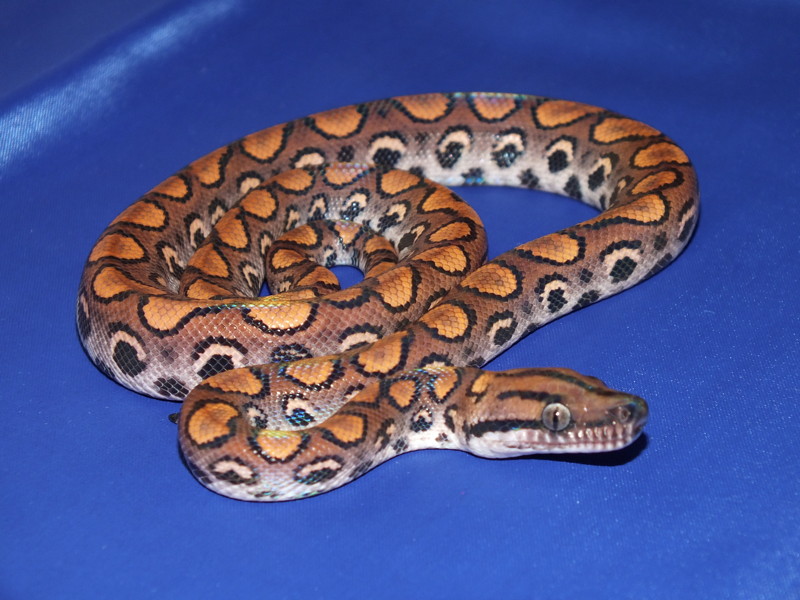 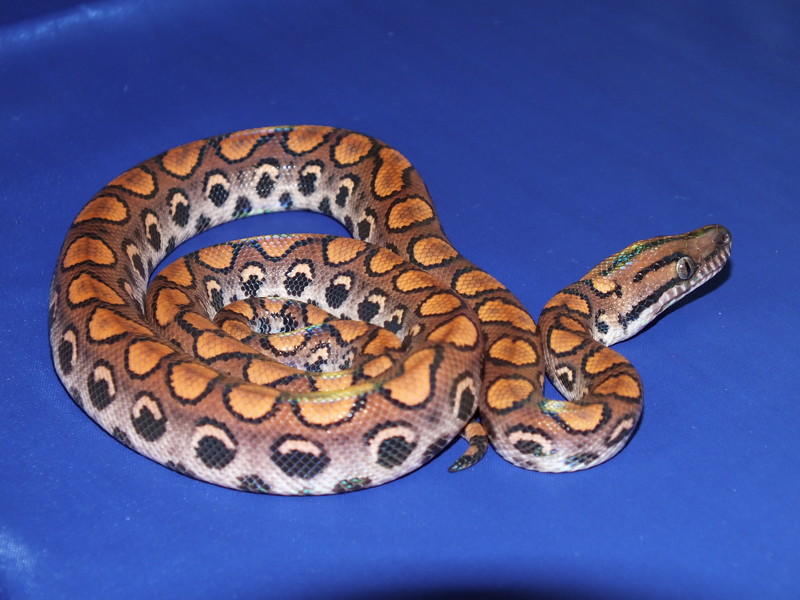 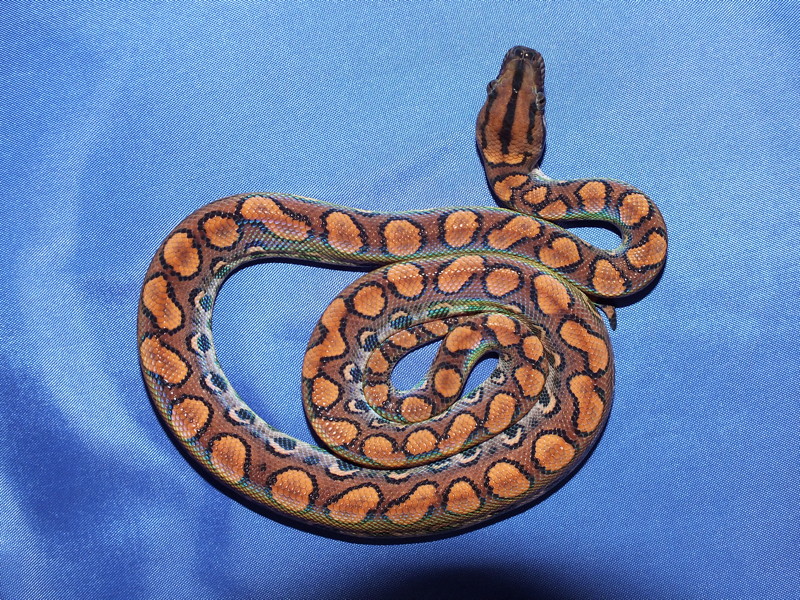 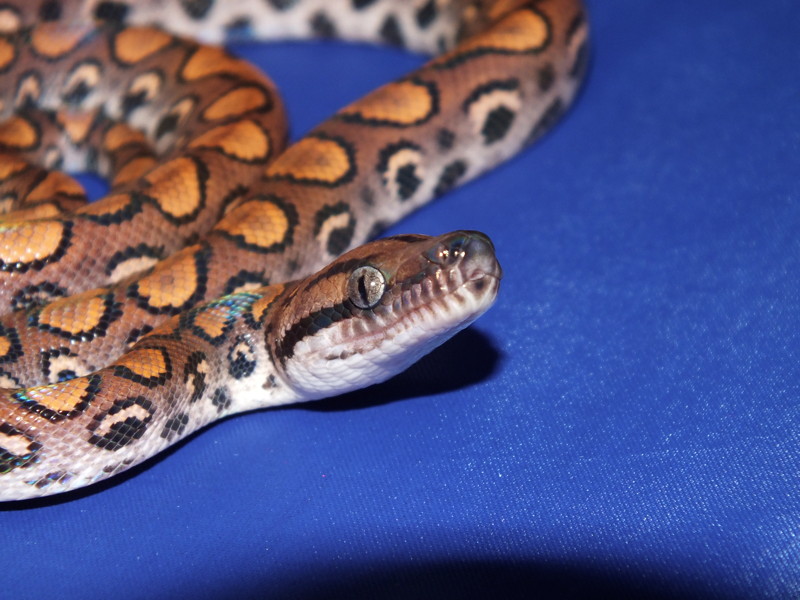 Four-Month Update This shot was taken in late December 2011 to late January 2012, and presents an updated view of the baby after the delay. 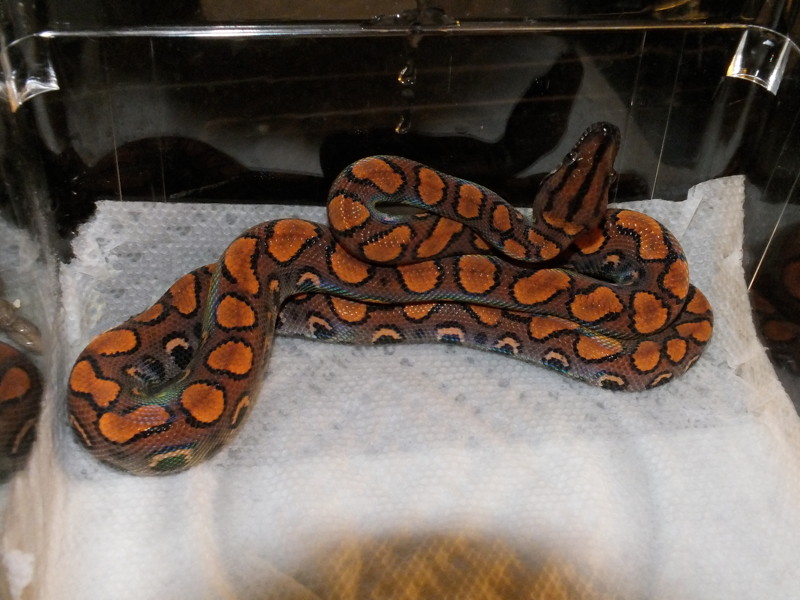 Seven-Month Update These shots were taken in April 2012 (she was the only baby not to shed in March), and present a further updated view of the baby after the delay. This mini-set includes a front/side shot, a top shot, and a close-up head shot. 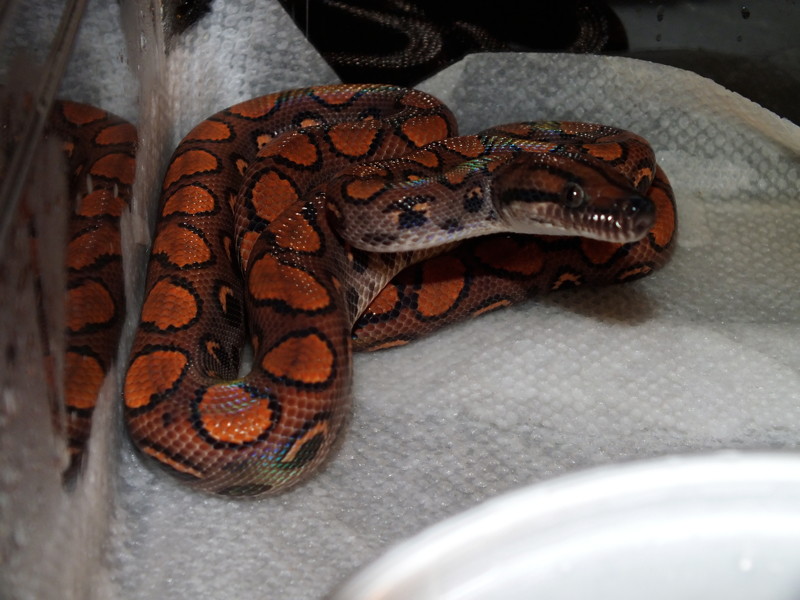 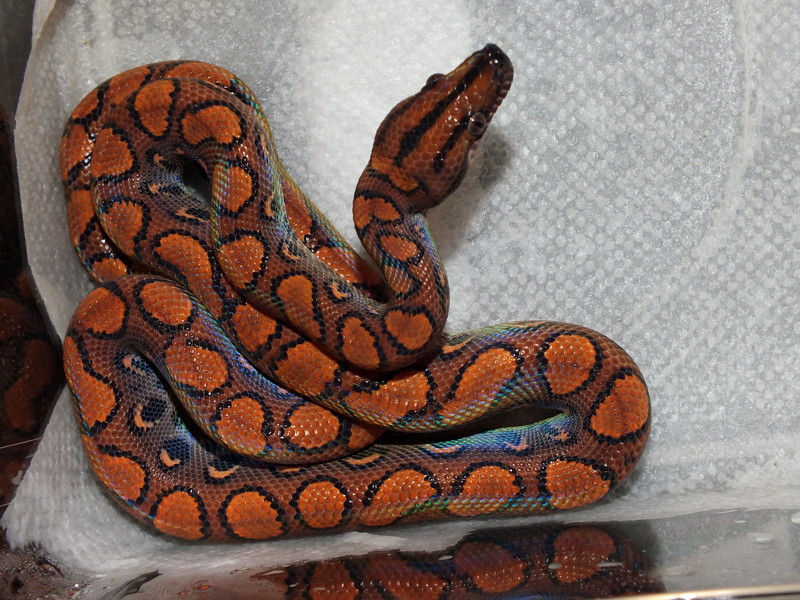 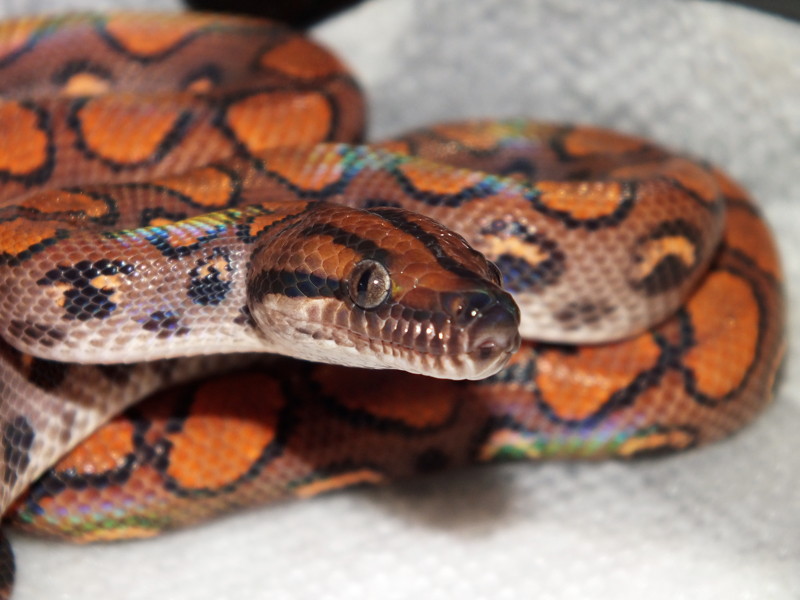 As of March 31, this little one had increased from a birth weight of 33 grams to 90 grams. ------ B-14 (Female) This was one of the last few babies I found. She was coiled off to the side, right on the heat, wedged between the now-empty hide and the wall. She seemed rather surprised when I moved the hide to grab her. (“Wait, you can move that thing?”) Over time, she has shown herself to be a real sweetheart, and is one of the calmest babies in this litter. Physically, she has several unique traits. She has a lighter-colored head, which can be an indicator of good things to come. On her back, she has two linked chains of two spots. On her sides, she has a 100% crescent pattern -- a clean, classic look all the way. Finally, she has a bonus black dot on her right side around mid-body. At Birth These shots were taken in mid-September 2011. The first shot was taken shortly after birth, and was shot just after her Mom's hide was moved away from the wall, thus exposing her chosen hiding place. The second is a (slightly) later shot, after she was placed in her own drawer-home. 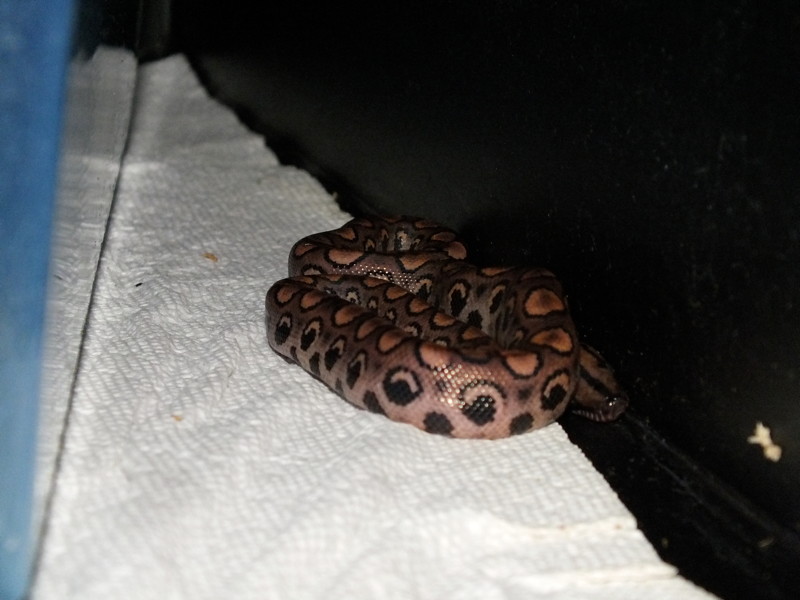 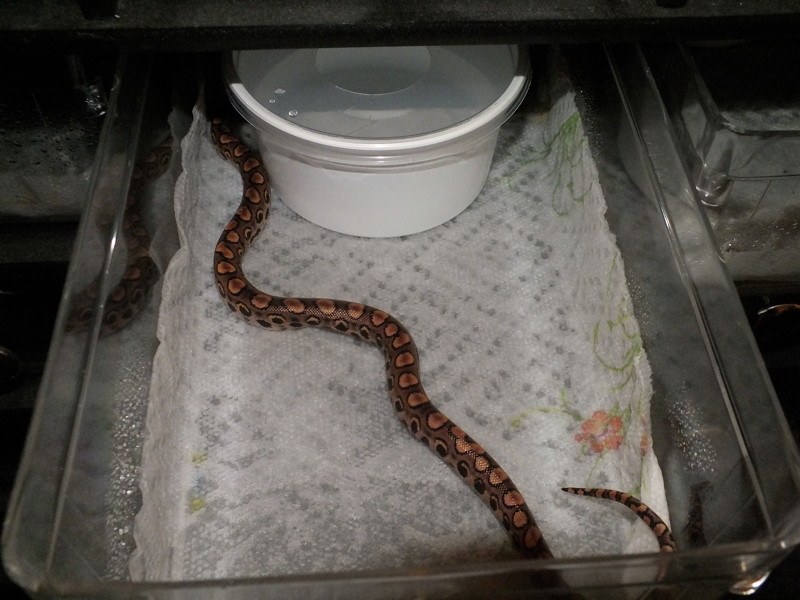 Post Shed This shot was taken in late September 2011. Apologies for the bad lighting; it was taken without formal prep. 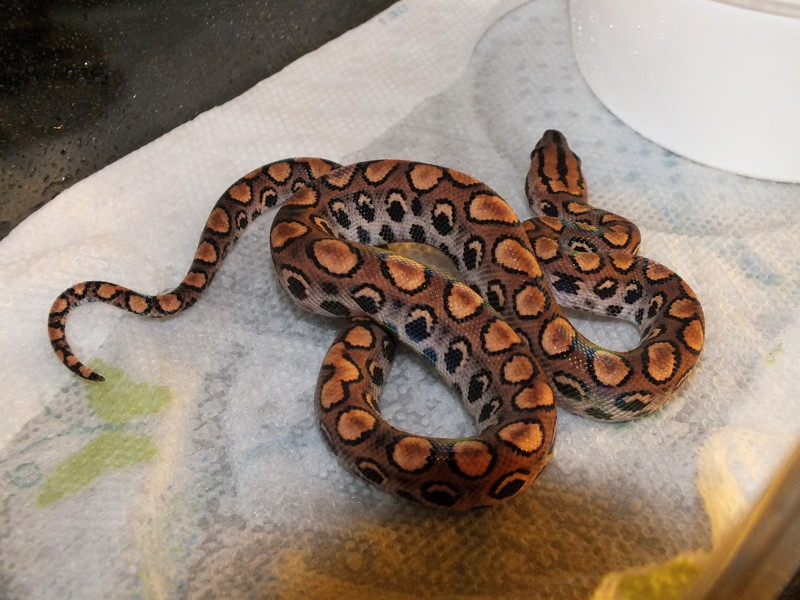 Formal Photo Session This series of shots was taken in early October 2011. Originally, these were to be the sale shots, but circumstances forced a long delay. This mini-set includes a right/rear shot, a left/rear shot, a top shot, and a close-up head shot (after she finally turned around for me). 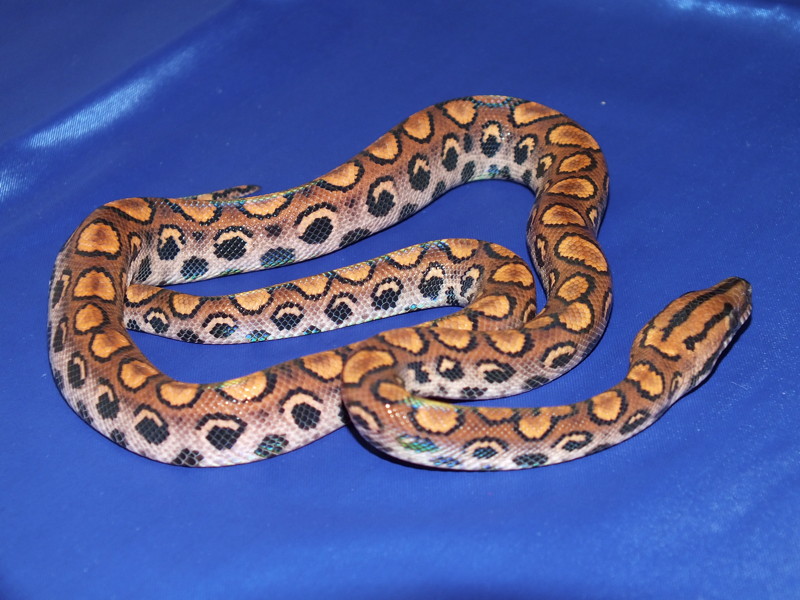  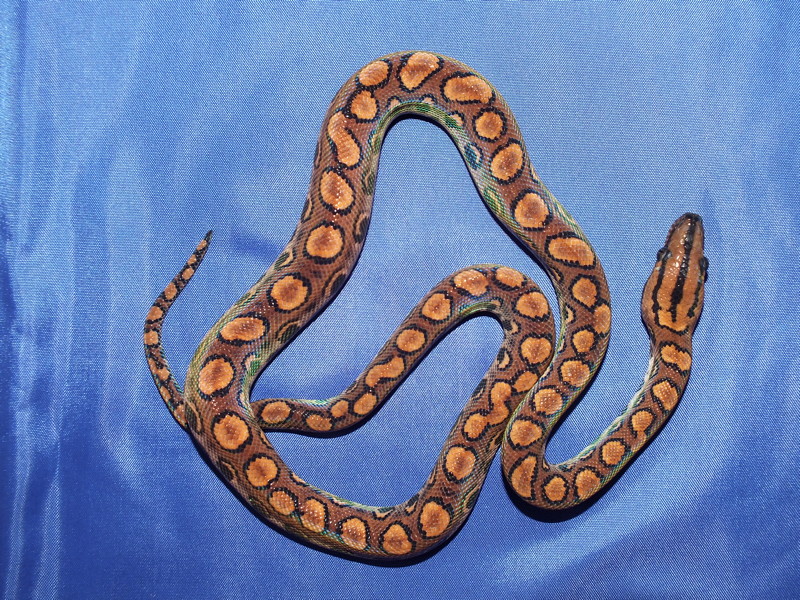 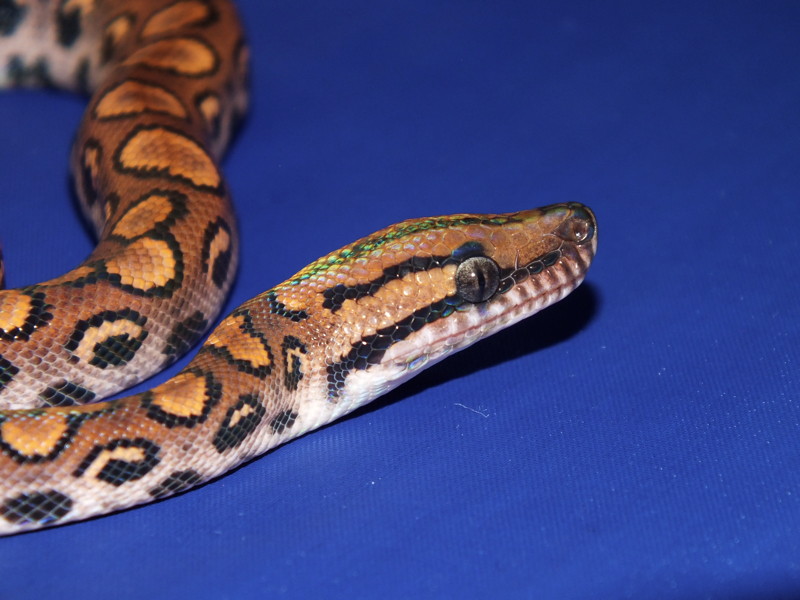 Three-Month Update These shots were taken in late December 2011 to late January 2012, and present an updated view of the baby after the delay. This mini-set includes a front shot and a top shot. 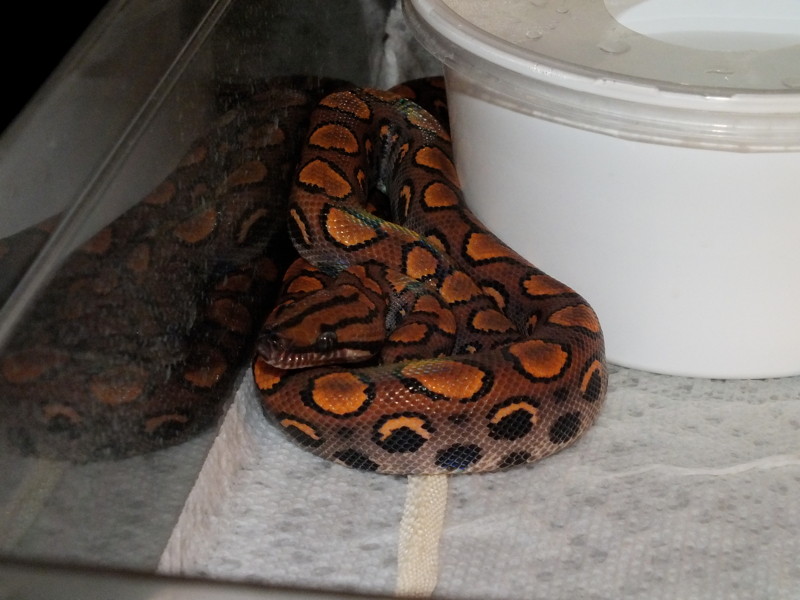  Six-Month Update These shots were taken in March 2012, and present a further updated view of the baby after the delay. This mini-set includes a raised/side shot, a top shot, and a close-up head shot. 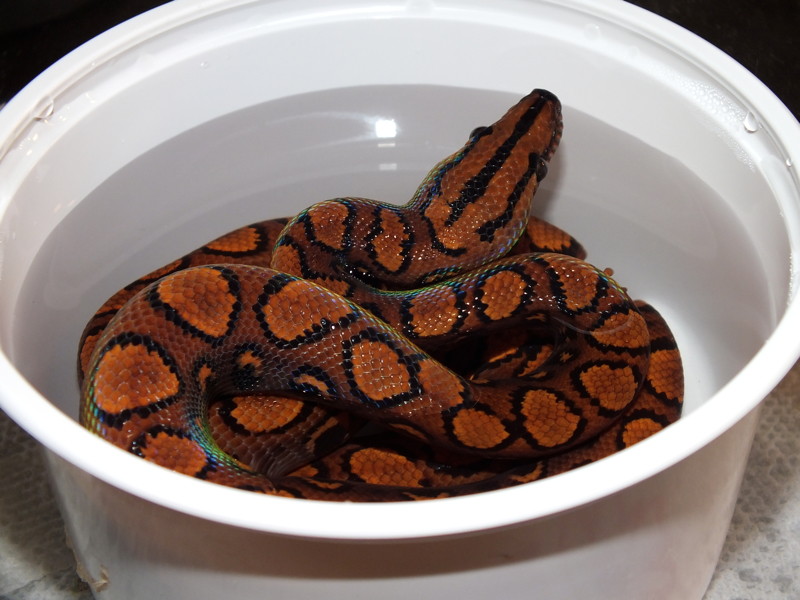 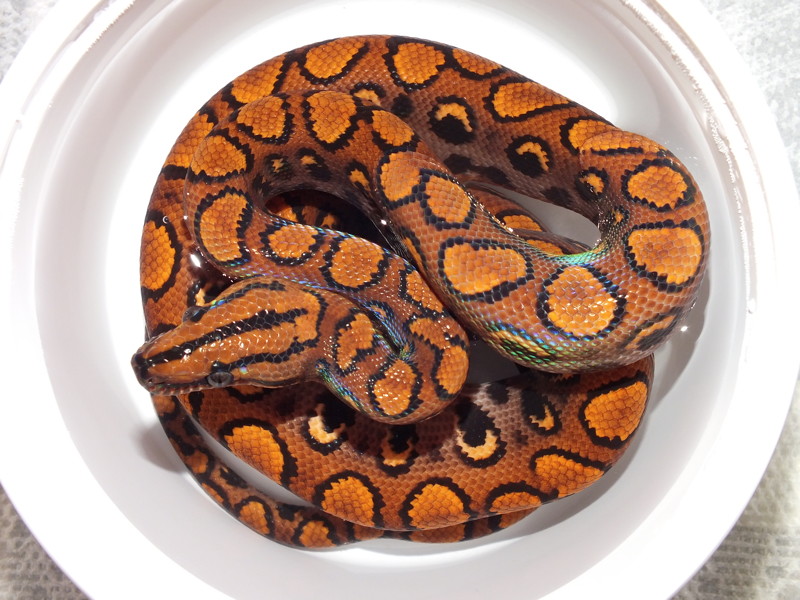 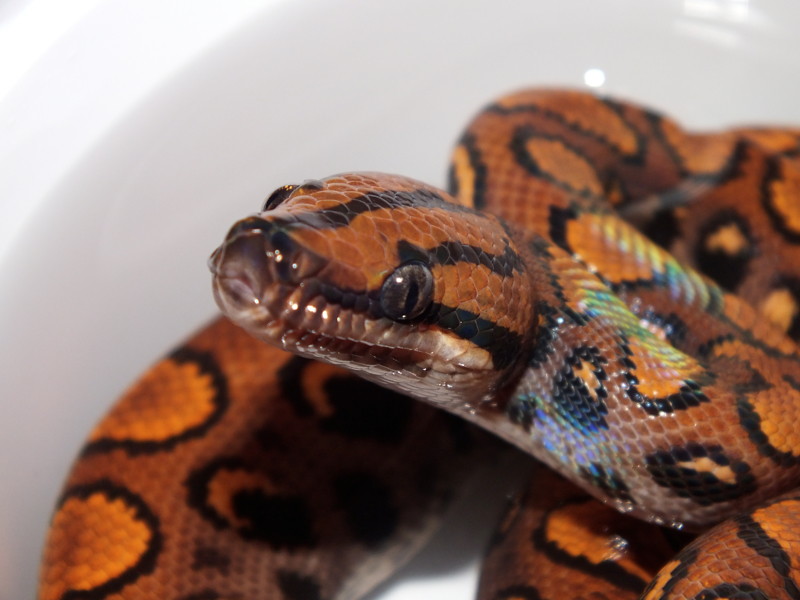 As of March 31, this little one had increased from a birth weight of 34 grams to 86 grams. ------ B-15 (Male) This little dude is the spunkiest member of his litter, and apparently the athlete of the group, too. I found him near the end of initial sorting, swimming merrily away in the almost-empty water bowl long after everyone else had moved on. He rewarded his rescuer by promptly sinking his baby teeth into the nearest finger. He is also the only member who ever successfully “escaped,” by deciding to make a mad dash for freedom -- he boiled up and out of drawer and to the floor three feet below before I could react. (It was the world’s shortest jailbreak.) These days, he is much calmer but still roguish: he tried another dash for freedom the night of the pattern inspection, but got caught en route; during the December weigh-in, he tried a nip, and used his tail to grab the counter-top in another attempt at escape; during several recent cleaning sessions, his baby vision locked in on my quick-moving cleaning fingers, and attempted baby wrath followed. His attitude is very much “why be held when you can explore?” Physically, he has several unique traits. He has a light-colored head, which can be an indicator of good things to come. On his back, he has four linked chains of two spots. On his left side, he has a 100% crescent pattern. On his right side, he has one departure from an otherwise solid crescent pattern, an eclipse. At Birth These shots were taken in mid-September 2011. The first shot was taken shortly after birth, and caught him swimming away in Mom’s water bowl. The second is a (slightly) later shot, after he was placed in his own drawer-home. 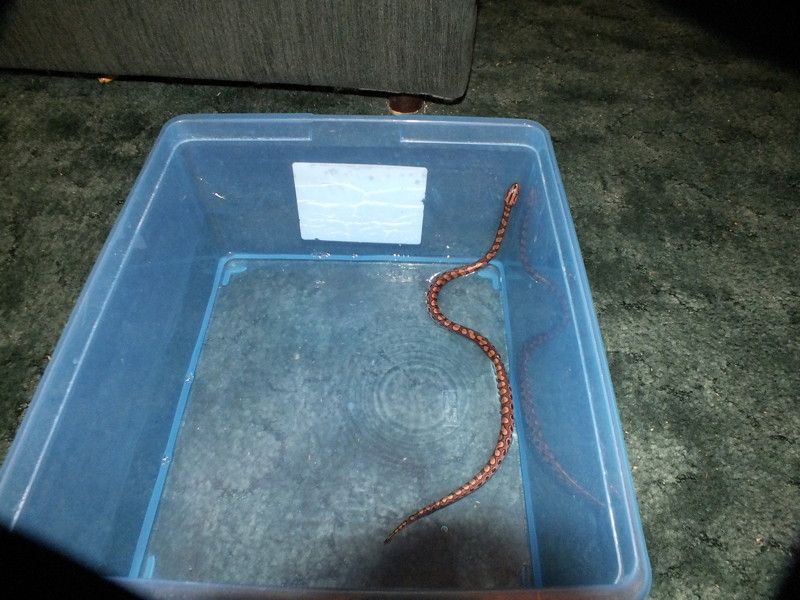 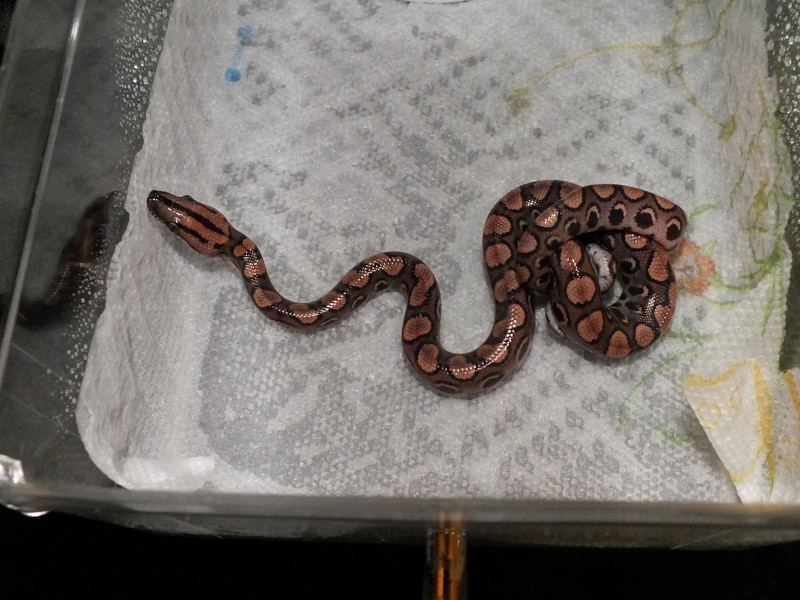 Post Shed This shot was taken in late September 2011. Apologies for the bad lighting; it was taken without formal prep. 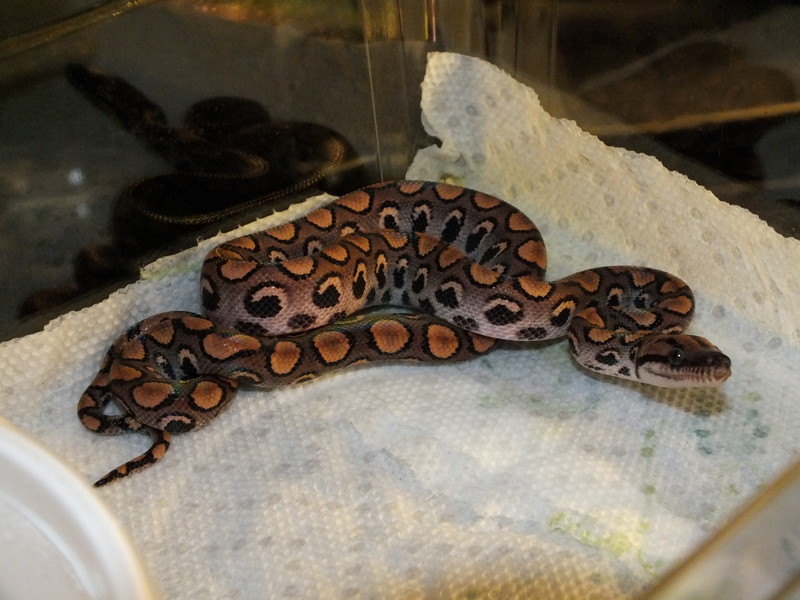 Formal Photo Session This series of shots was taken in early October 2011. Originally, these were to be the sale shots, but circumstances forced a long delay. This mini-set includes a front shot, a side shot, a top shot, and a close-up head shot.  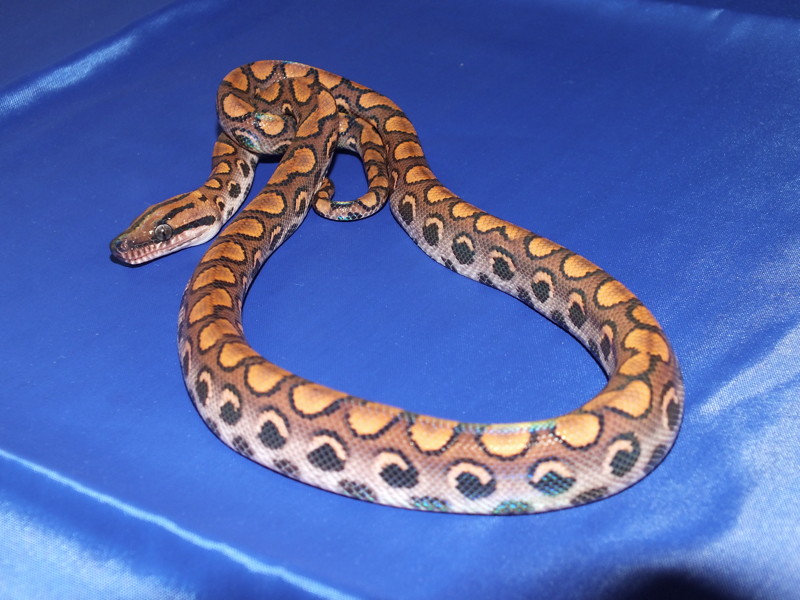 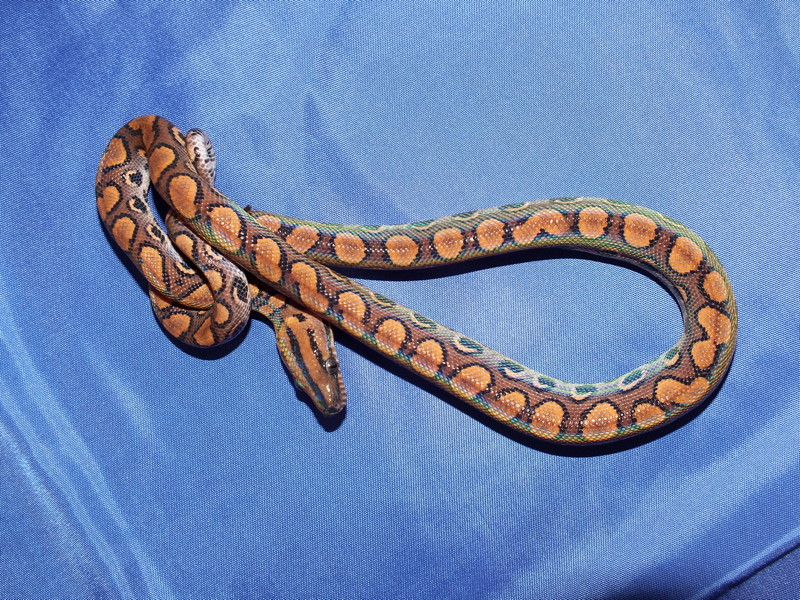 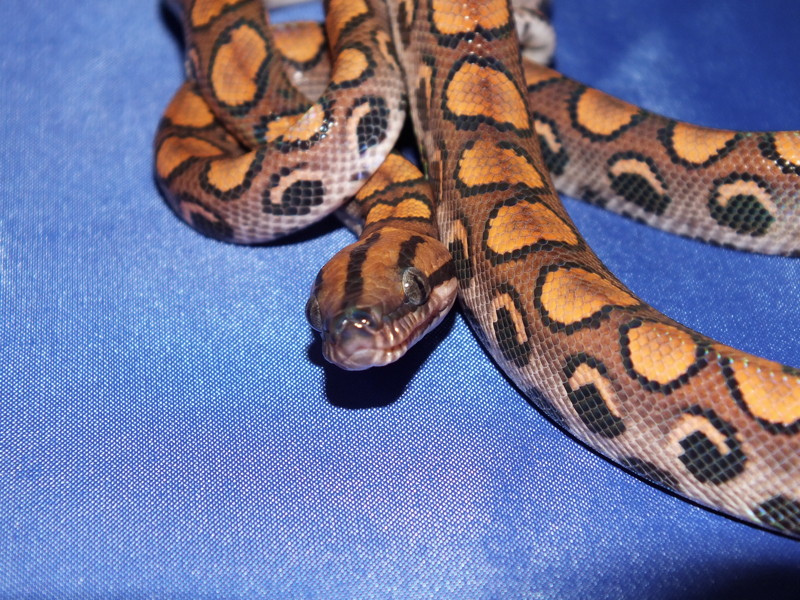 Three-Month Update These shots were taken in late December 2011 to late January 2012, and present an updated view of the baby after the delay. This mini-set includes a front shot and a top shot.  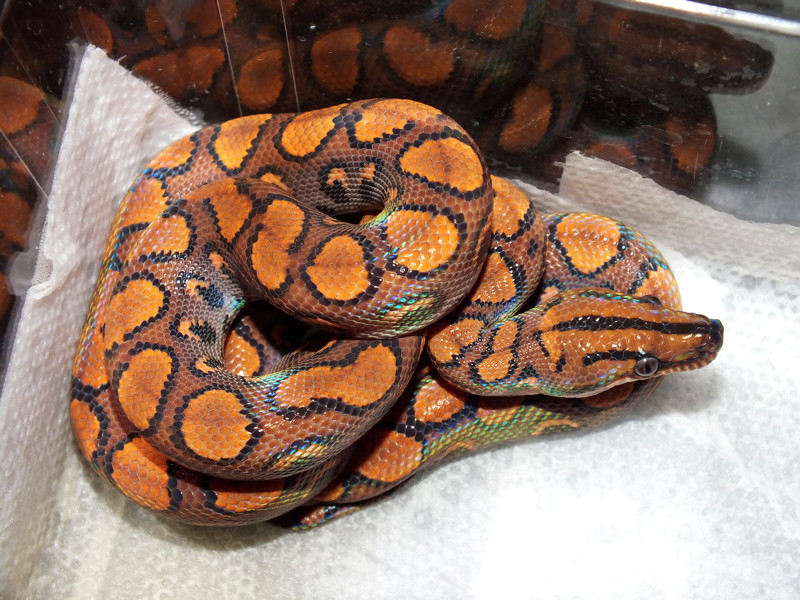 Six-Month Update These shots were taken in March 2012, and present a further updated view of the baby after the delay. This mini-set includes a front shot and a top shot.  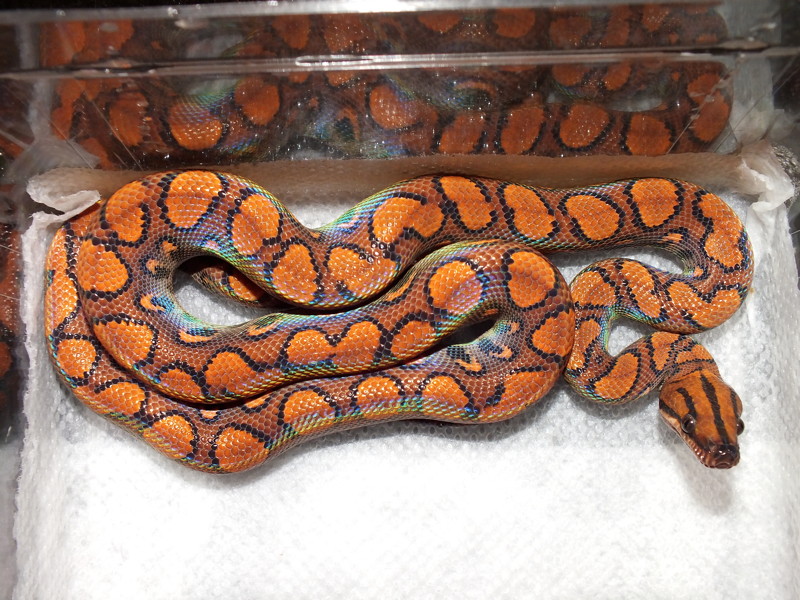 As of March 31, this little one had increased from a birth weight of 33 grams to 96 grams. ------ B-16 (Male) This guy was one of two final babies I found after everyone else was long put away, carefully hiding under the newspaper. He is a very active snake, and would not sit still during the pattern inspection. Physically, this little one has several unique traits. On his back, he has three linked chains: one three spots, one two or three spots (depending how you count), and one two spots. On his left side, he has a 100% crescent pattern. On his right side, he has three departures from an otherwise solid crescent pattern, one merged dot and two tiny bonus pearls (the only ones in the litter). His crescents, I should add, are some of the boldest in the litter. At Birth This shot was taken in mid-September 2011. 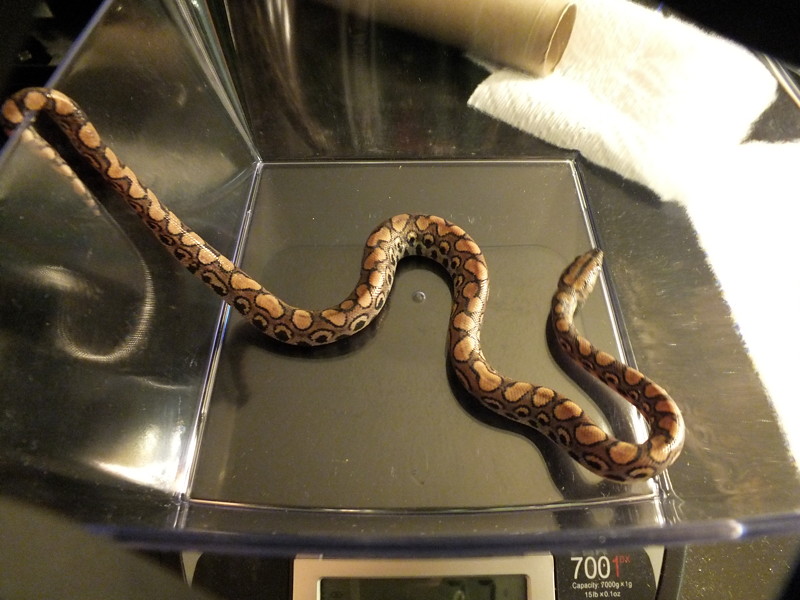 Post Shed This shot was taken in late September 2011. Apologies for the bad lighting; it was taken without formal prep. 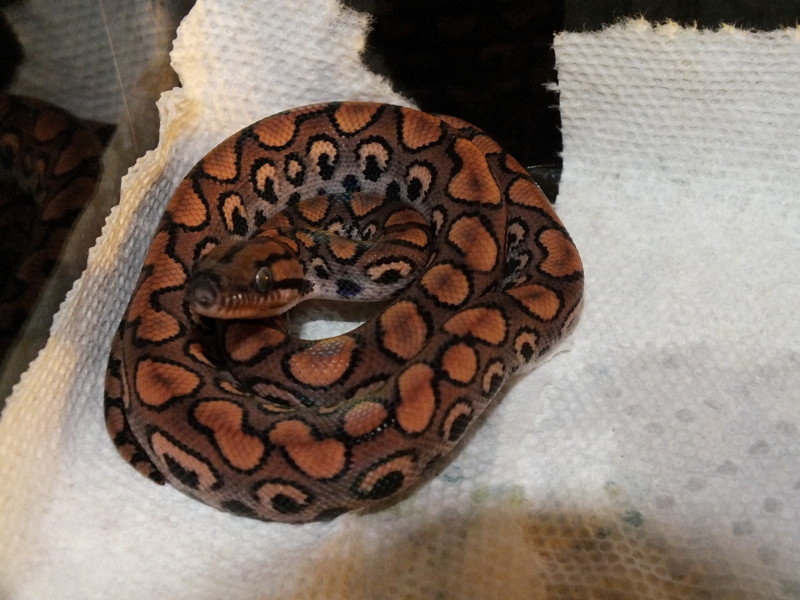 Formal Photo Session This series of shots was taken in early October 2011. Originally, these were to be the sale shots, but circumstances forced a long delay. This mini-set includes a front shot, a side shot, a top shot, and a close-up head shot. 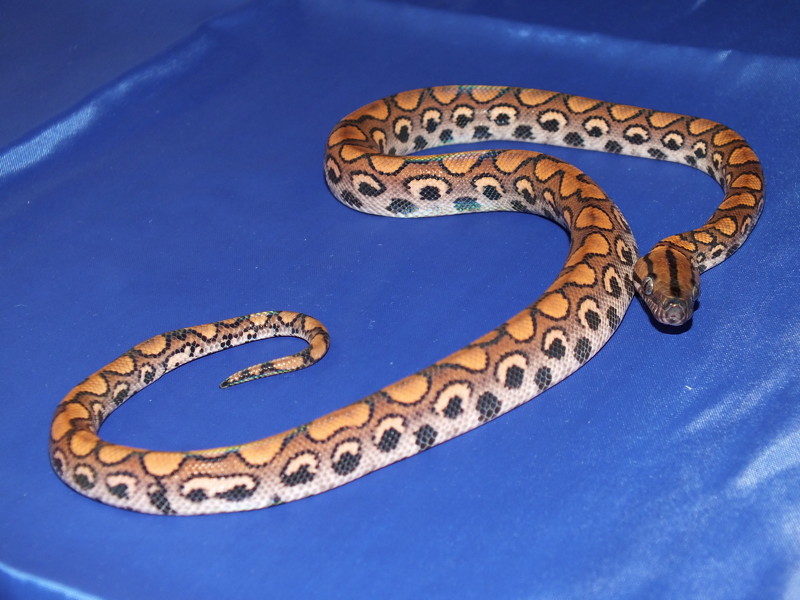 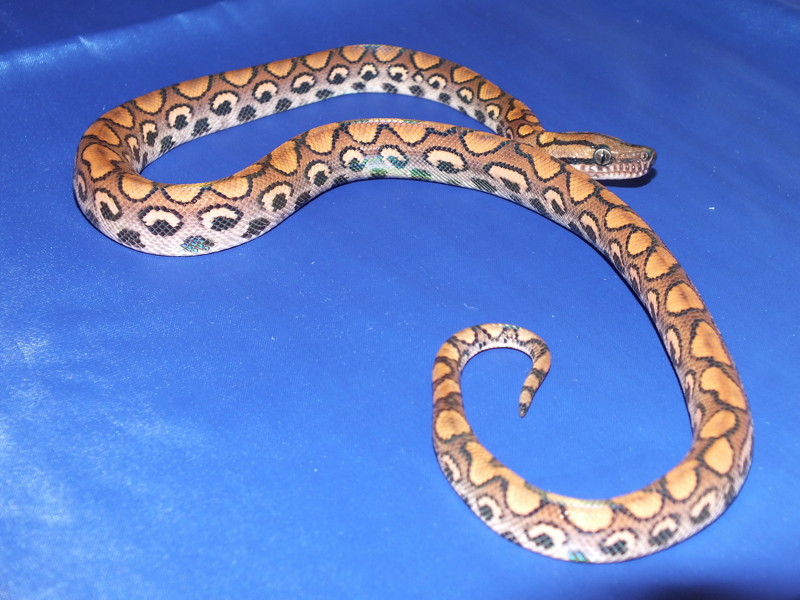 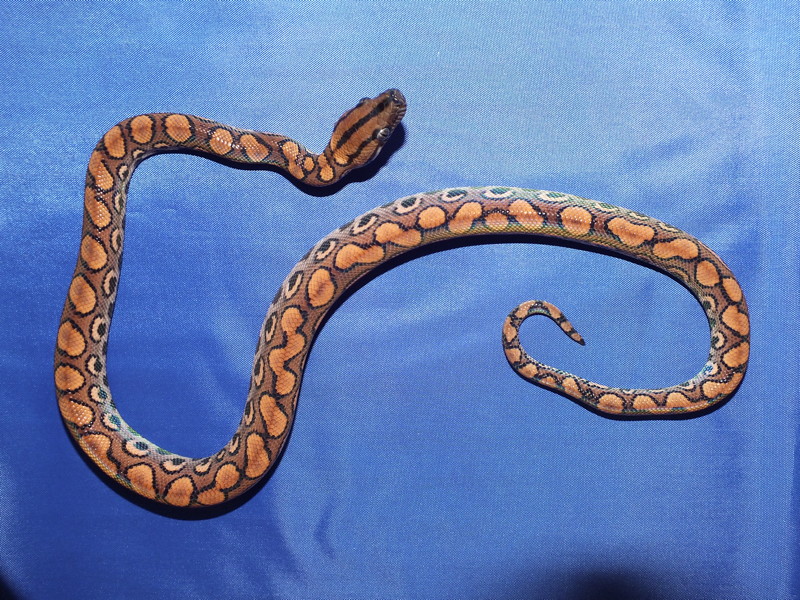 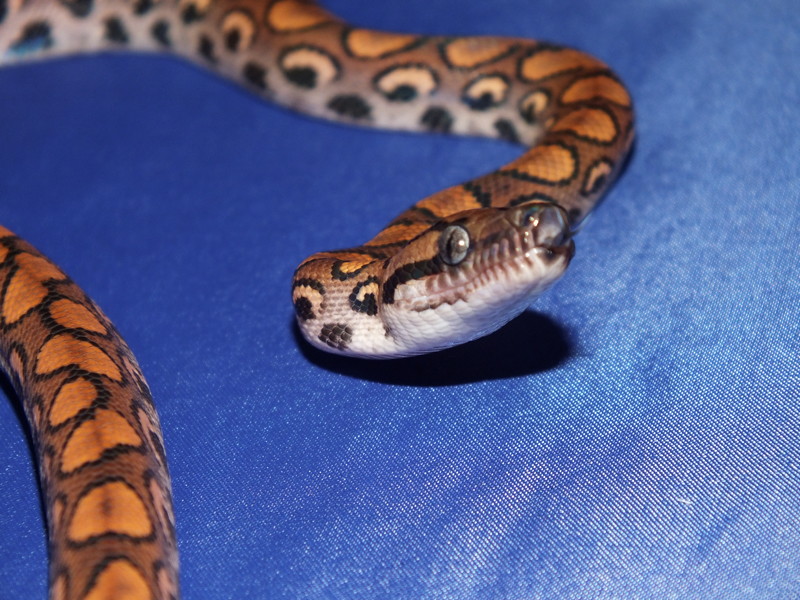 Three-Month Update These shots were taken in late December 2011 to late January 2012, and present an updated view of the baby after the delay. This mini-set includes a front shot and a top shot. 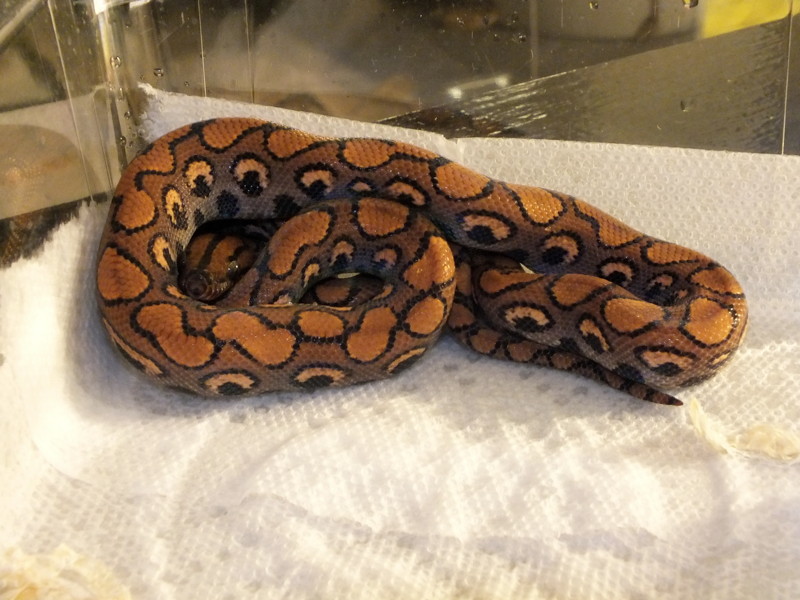  Six-Month Update These shots were taken in March 2012, and present a further updated view of the baby after the delay. This mini-set includes a side shot and a top shot. 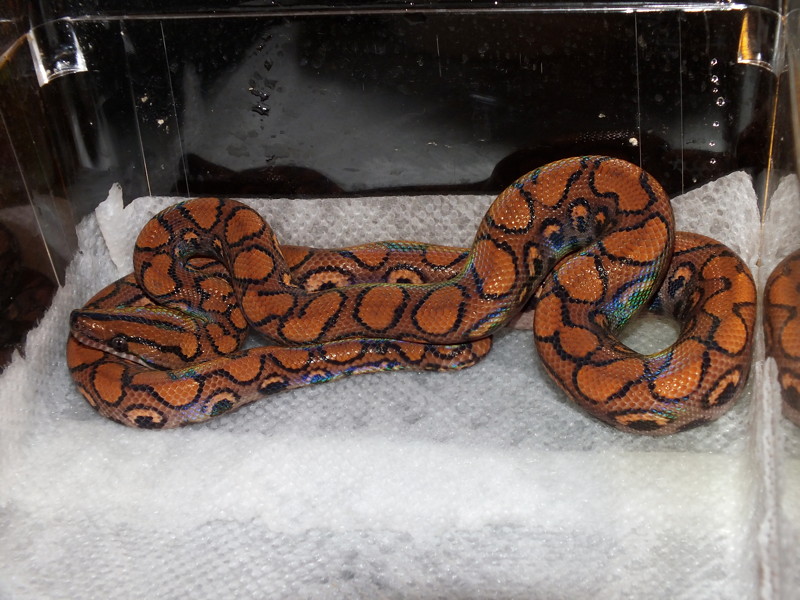 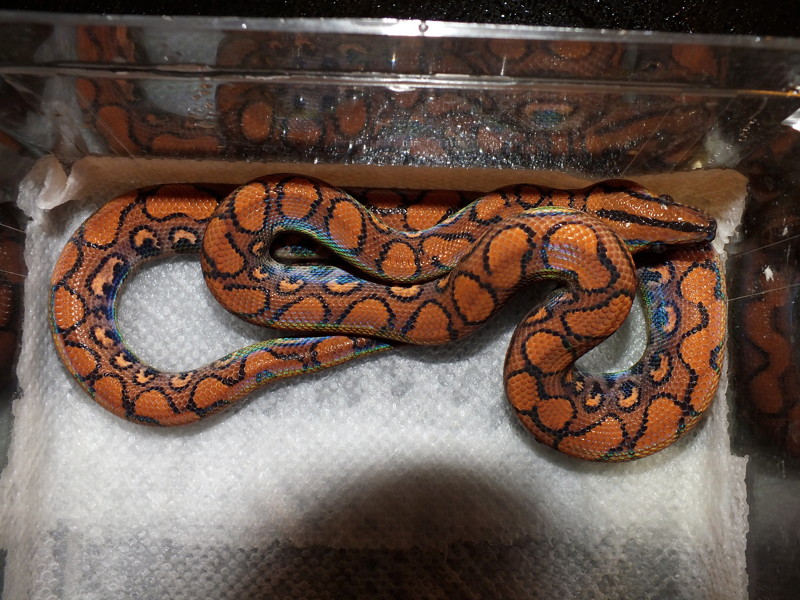 As of March 31, this little one had increased from a birth weight of 32 grams to 89 grams. ------ B-17 (Male) This guy was one of two final babies I found after everyone else was long put away, carefully hiding under the newspaper. Even then, he was fairly mellow, and that has not changed as he aged. Interestingly, he is the only baby in the litter that likes to hang out at the very front of his drawer, something he does almost all the time (and it is not due to temps -- I’ve checked!). Physically, this little one has several unique traits. On his back, he has two linked chains of two spots. On his right side, he has three departures from an otherwise solid crescent pattern, all eclipses (one is an “almost”). On his left side, he also has three departures from an otherwise solid crescent pattern, two eclipses and one merged dot. At Birth These shots were taken in mid-September 2011. The first shot was taken shortly after birth, just after I discovered him as the last holdout hidden away under the newspaper in Mom's viv. The second is a (slightly) later shot, after he was placed in his own drawer-home. 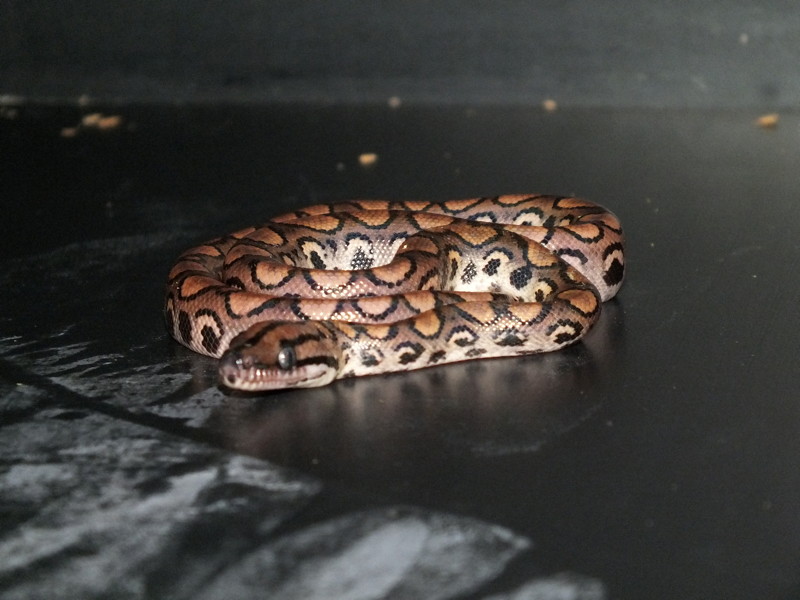 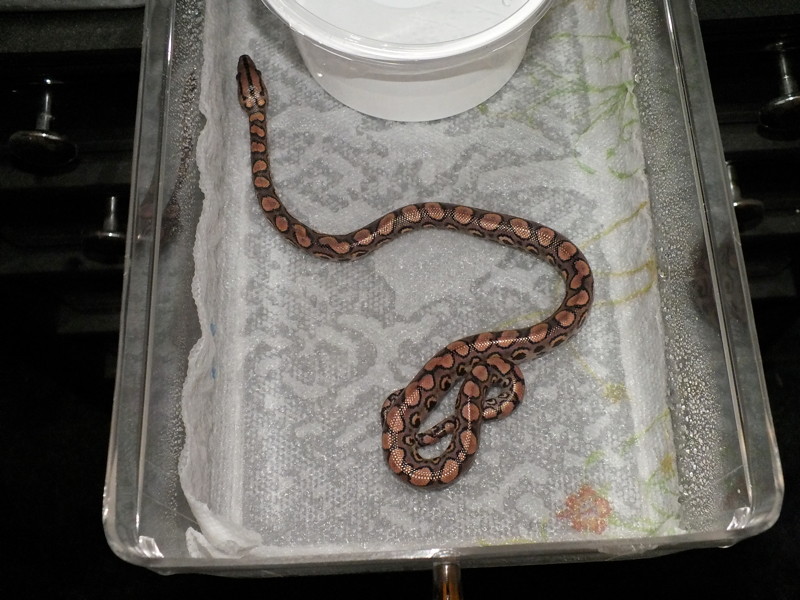 Post Shed This shot was taken in late September 2011. Apologies for the bad lighting; it was taken without formal prep. 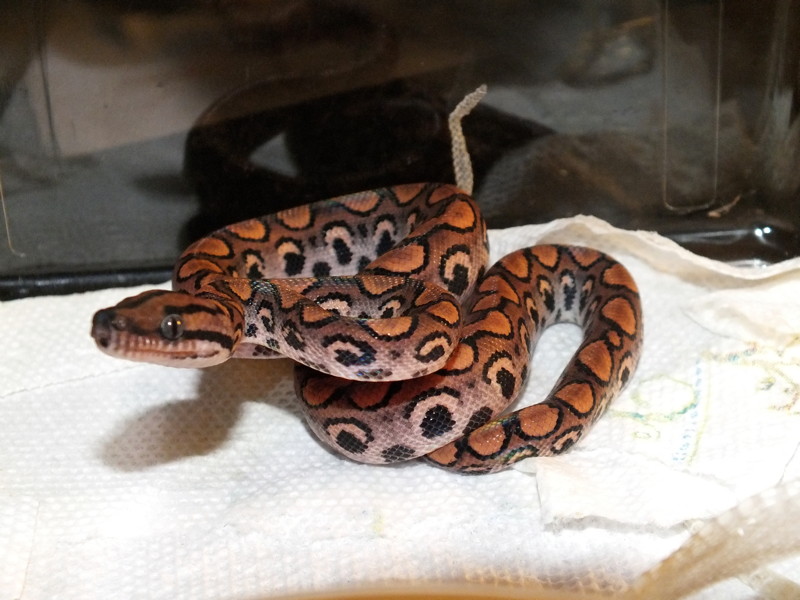 Formal Photo Session This series of shots was taken in early October 2011. Originally, these were to be the sale shots, but circumstances forced a long delay. This mini-set includes a front/side shot, a rear/side shot, a top shot, and a close-up head shot. His neck is craned up in most of them because I had just removed the photo bowl, and he froze to “hide” from me. 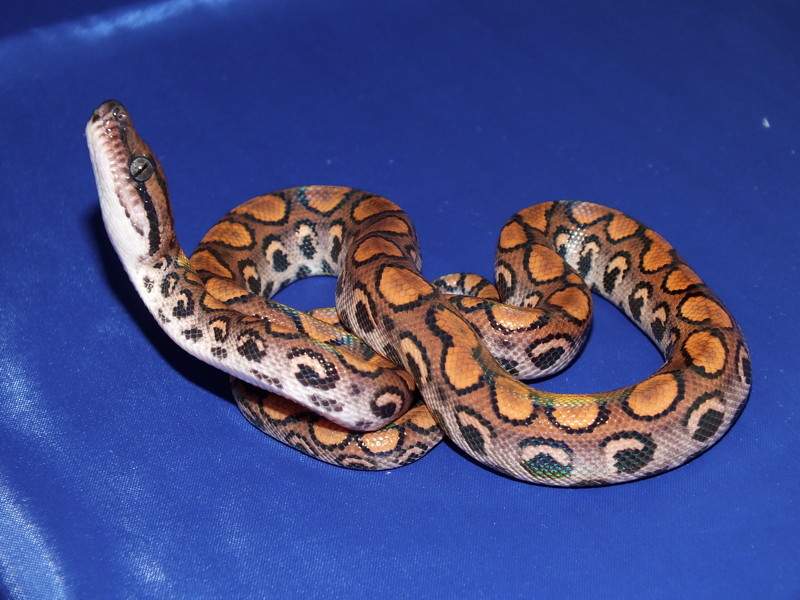  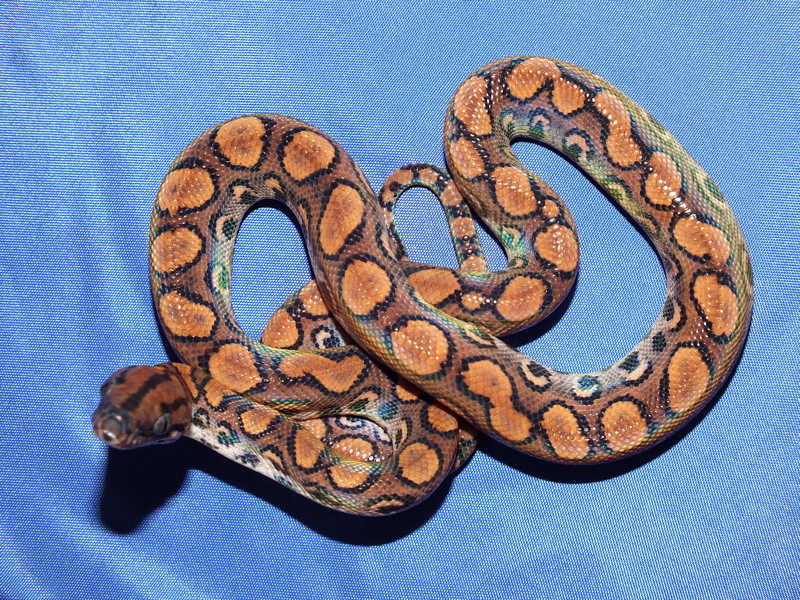  Three-Month Update These shots were taken in late December 2011 to late January 2012, and present an updated view of the baby after the delay. This mini-set includes a front/side shot and a top shot. 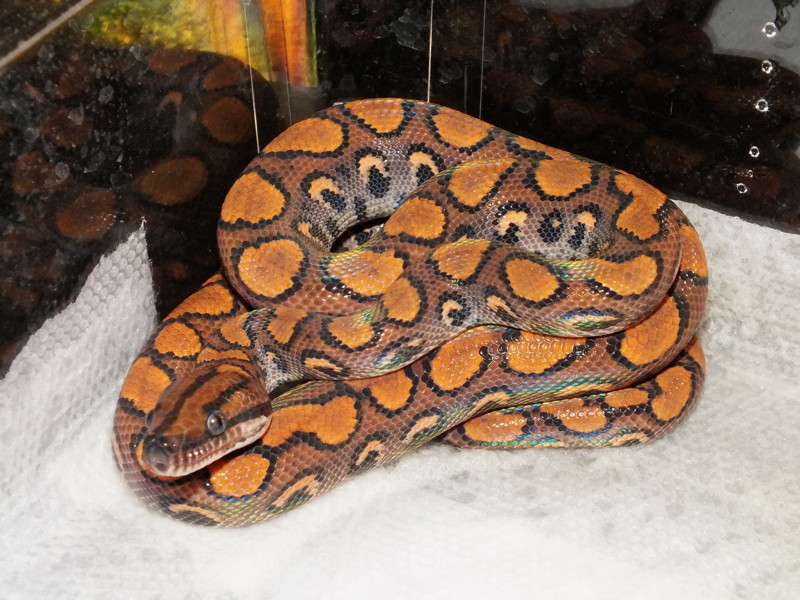 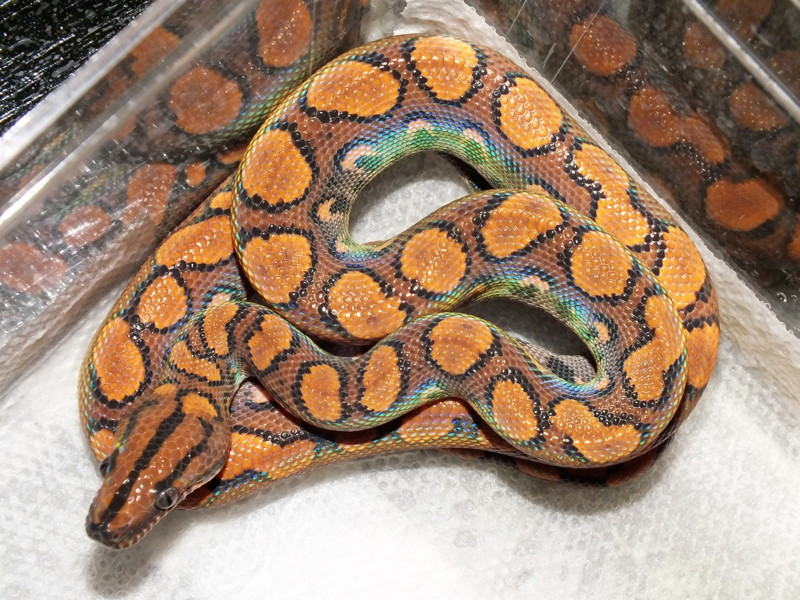 Six-Month Update These shots were taken in March 2012, and present a further updated view of the baby after the delay. This mini-set includes a raised/front shot, a top shot, and a close-up head shot. 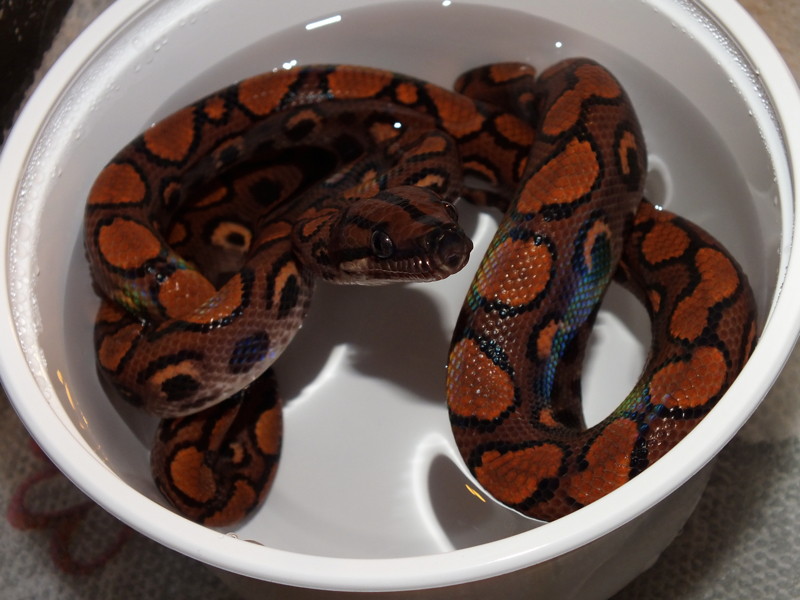 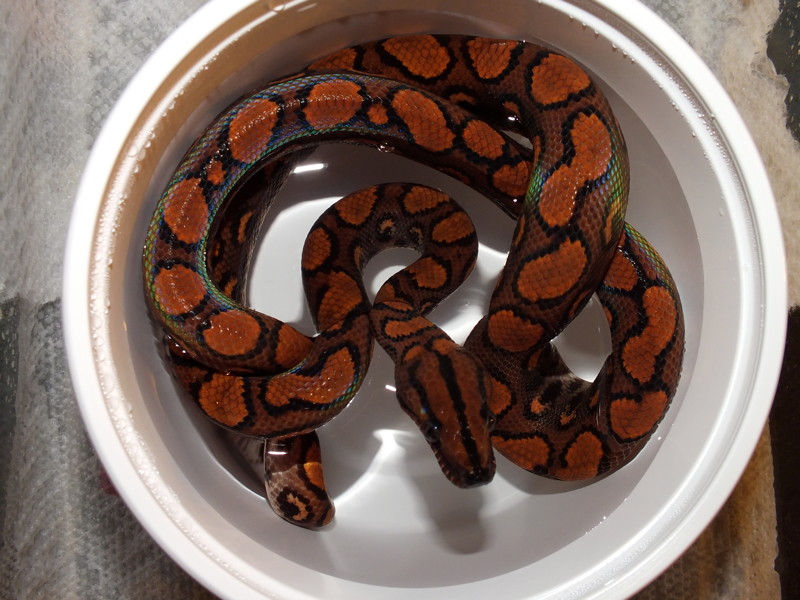 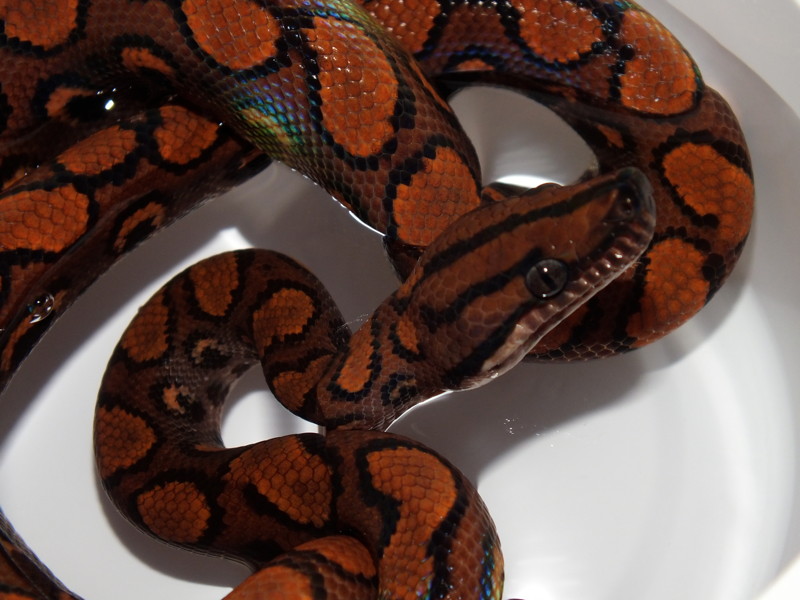 As of March 31, this little one had increased from a birth weight of 31 grams to 90 grams. ------ Partly because last year was a tough one, and partly because this litter turned out so well, I will be holding back four babies in total. Two are more or less decided, and the second two are proving to be tough calls. Suggestions are welcome. Please note that as Hills passed way earlier this year, these 17 little ones will be the sole genetic legacy to his gorgeous color and unusual black back patterning. Rest in peace, buddy -- you done good, and through these little ones your legacy will live on. Thank you, as always, for reading. Friday, March 30 2012Beating a Misdiagnosis
Every once in a great while, an event changes your perception of both your pets and the larger hobby around you. The event can be big, such as the discovery of a game-changing morph; or it can be small, such as the unexpected death of a favorite herp -- but whatever that trigger is, it redefines your comfort and practices forever. The post that follows relates such an event. It is, I suspect -- given the tendency of people to skim long posts and thus miss facts -- a risky move. However, I think the lessons it teaches on the importance of measured reactions, strict procedures, and only using the best “exotic” specialists in the industry are crucial for any keeper; and the events described were not only clearly someone else’s fault, but we took extreme measures to fix them. In the end, everything turned out alright -- but it came tragically close to not being that way.
By way of background, Living Gems Reptiles had lost three animals at the time these events unfolded: Topaz, a stunning orange-red female we had for four years, who passed away from advanced pneumonia in October 2011 (she is the primary animal mentioned below, and her story can be found here); Vlad, an above-average orange male we had since June 2010, who was recovering from an odd infection then suddenly passed away after a difficult tube feeding in October 2011 (his necropsy picked up fluid in his lungs and a strange liver condition); and Hills, a gorgeous high-orange male we had since June 2010 who passed in August 2011 from a simple respiratory infection we accidentally caused (his necropsy turned up nothing unusual). Topaz and Vlad were mates from the 2011 breeding season. Hills was not connected to them in any way. All three animals had been on strict quarantine for some time before passing, the last one starting at the end of August. We also had two August 2009 juveniles that had developed odd scale blemishes, Lancelot and Tigers Eye, both of whom were also on quarantine, and one of whom plays a role in this story. Other a single death back in 2009, these were the first health issues our main collection had ever experienced. ------ Living Gems Reptiles has always prided itself on its thorough care and procedures. We buy 95% of our animals only as babies from top breeders of our species, and carefully screen the (very) few exceptions to learn both past ownership of the specific animal and the general history of its bloodline -- and we ask a lot of questions about those animals. If we cannot find enough information, we will simply walk away from a deal. Regardless of origin, we put all new animals through a strict, no-exceptions quarantine in enclosures that have been pre-treated for mites. We set that quarantine to the maximum length of the advised range, a full six months. And during this quarantine, we subject all acquisitions to careful weekly inspections, so that we can catch and eliminate any threat as soon as possible. While our front-end procedures catch 99% of problems, we also have recurring and back-end procedures that form additional safety nets. On a weekly basis, for example, all members of the collection are carefully inspected, and records are periodically reviewed for any unusual patterns such as weight loss or skipped sheds. On the back end, in the rare event that an animal in our collection unexpectedly passes away, we have a necropsy performed to learn the cause -- as opposed to just trashing the body like so many vendors do. The combination of all these precautions means that real problems are very, very rare. Which is why it was such a surprise when a necropsy came back on Topaz, a prize female that had been in our care for almost four years under excellent care, noting the cause of death as severe pneumonia caused by an unusual strain of bacteria. That diagnosis, though controllable, was troubling enough. However, the pathologist took it a step farther by reporting not only bacteria, but also IBD and possible PMV -- both of the worst possible reptile illnesses, together in one animal. What makes this such a complete tragedy and vivid lesson is that, while we did not know it at the time, those last two diagnoses were totally and completely false. For those unfamiliar with the illnesses listed above, the first abbreviation, IBD, stands for inclusion body disease, one of the disease nightmares of the snake world. While a definitive cause is unknown, it is highly contagious across many species of boas and pythons. Symptoms include neurological (the classic head tremors and star gazing), digestive, and secondary infections. There is no known cure, and it is always (eventually) fatal. The second abbreviation, PMV, stands for paramyxovirus, and is also about as bad as you can get. While a diagnosis in boas would be shockingly rare -- it is a disease of the viper world -- there have been a bare handful of cases reported in boas, about one a decade since the disease was first identified 35 years ago, and usually in mixed viper-boa collections. Symptoms range from respiratory to neurological to digestive and more. While unlike IBD there have been reports of recovery, with this disease too there seems to be no known cure. So what do you do when you get a diagnosis of IBD? (PMV, due to the “possible” flag, was secondary at this early point.) The usual suggestion, as relayed by several “concerned” keepers I know, is to destroy every single animal in your collection, toss all your equipment, wait a year, and then start over. Keep in mind our collection did not have either disease when we were being told this. Thankfully, I’m a stubborn guy who insists on a scientific approach. The deceased animals had displayed none of the classic front-line symptoms of either dread illness. None of my other animals were showing signs of either highly contagious disease. And the idea that one animal who had been with me for so long could have magically developed all three diseases made me wary to start. Either there had been a misdiagnosis, or -- as was whispered in my ear by reptile friends, but I did not want to believe -- someone had deliberately dealt me a bad card. So, since I had major doubts, I set out to get second opinions. The first thing I did was write the experts. Dr. Edward Wozniak, who did a pioneering IBD study in the late 1990s, was the first to reply, and his advice was both absolute and a first hint: “I wouldn’t do anything just yet…. [Dr. Elliott Jacobson and I] have had a full time graduate student working on [IBD] since 2008 and she has greatly advanced the understanding of the disease but even with that, many questions remain. We have still yet to confirm the source of the protein that accumulates in the structures (inclusions) for which the disease was originally named…. While this may seem trivial, it means a lot about the actual cause of the disease and the diagnostic value of simply seeing inclusion bodies in tissue specimens.… It should also be mentioned that many ‘types of inclusions’ can look the same and just seeing such structures on a slide really don’t mean that you have IBD. The true IBD inclusion contains a very unique protein and are classified as non-viral inclusions. Just seeing a red staining body inside a cell really doesn’t mean that the snake has the disease we now call IBD. Without going to electron microscopy and/or other advanced methodologies, its virtually impossible to definitively identify a given inclusion body as an IBD inclusion.” The emphasis is mine -- but the fact that inclusions could be present but not IBD was new information to me. Dr. Wozniak also told me a new blood test had been developed for the disease that was much less invasive than the biopsy method, and that he felt provided definitive results: “Two of the big accomplishments that were recently achieved in our IBD research were 1) the re-creation of a highly specific monoclonal antibody that can be used to specifically stain and identify inclusion bodies as IBD inclusions and 2) the ability to use this antibody on blood rather than tissue samples. With those developments we can now simply draw a blood specimen and use it in much the same way that I used liver biopsy specimens in my original research. This is a huge leap forward because you can easily test a given animal with a simple blood draw and classify it as IBD positive or IBD free.” I next spoke with Dr. Rita (Li-Wen) Chang, a PhD student under Dr. Jacobson (the same doctor as above, and one of the leading authorities on IBD). In a very generous phone conversation, she confirmed what I had learned so far, and also elaborated a bit further on the new test, saying that while it was still not 100% definitive, it was the best way to screen large numbers of animals. Another key fact was that, despite what everyone reads on the web, a viral cause of IBD had not yet been proven -- which was important because it quickly showed me that most of the conventional web advice on IBD, much of it littered with official-sounding references to viruses, is based on unproven assumptions. I next spoke with Dr. Doug Mader, who should be familiar to many readers of this post as the author/editor of the Saunder’s authoritative “Reptile Medicine and Surgery” publication. Possibly the best-known reptile vet in the business, we spoke on the phone for over 30 minutes, and kept in touch afterwards. Dr. Mader, in turn, put me in touch with Dr. Thomas H. Boyer. A local California vet, Dr. Boyer specializes in the veterinary care of reptiles and amphibians. He was a co-founder of the Association of Reptilian and Amphibian Veterinarians, has published two books on reptile medicine, and is only one of only five Diplomates of the American Board of Veterinary Practitioners, Reptile and Amphibian Practice. He and his associate Dr. Zachary J. Steffes -- who has the best "bedside manner" I've ever experienced from a vet -- were the expert “boots on the ground” for this project, though they kept in touch with Dr. Mader throughout. As their names will probably be unfamiliar to readers, full biographies for both men can be found here: [url]http://www.pethospitalpq.com/site/view/186194_MeetourDoctors.pml[/url]. As a result of the last two conversations, two decisions were made. In the first, the lab that had diagnosed Topaz would run some (generously free) tests on Vlad to see what he tested positive for. In the second, I made the difficult choice to put down Lancelot, one of the juveniles with the odd scale problem, in order to give us a more comprehensive set of tissues (the two deceased snakes had only limited and now dated samples available). It was suggested I just send Lance down via overnight mail…but that did not sit right with me. Part of owning a pet is taking responsibility for the hard parts, and I felt the least I could do is drive him down in comfort myself. So, the next Saturday, I did. I was not there for the actual procedure, but was told by the euthanizing vet that Lance was “a good snake” all the way to the end. (I know some of these names may be unfamiliar to newer keepers, so I would appreciate it if some of the more experienced readers could weigh in on the caliber of these names to clarify why they mean something.) But lab tests take time, so while they worked, I was stuck in wait mode. I don’t know if it’s possible to describe the paranoia and dread you feel when managing a possible triple outbreak in what many have acknowledged is a top-notch collection. It’s a truly horrible experience. Every single action has to be performed in a manner that minimizes the possible transmission of disease. In my case, from the time I received that first report, I implemented a draconian quarantine: I handled all animals using not only latex gloves, but disinfected both hands and tools with bleach between each and every snake. As a further precaution, I divided my vivs into small quadrants based on risk, and between every quadrant performed additional disinfecting. That level of caution imposes a terrible toll, because every possible source of contamination -- be it a stray piece of moss, a falling drop of water, or a snake simply touching your arm -- has to be immediately and thoroughly sanitized. Your time commitment goes up by a factor of four or five. Weekly cleaning, which used to take two to three hours, now took ten. Monthly weigh-ins, which used to take three hours, now took a full fifteen. I showered right after every cleaning session…just in case. A new weekly activity involved disinfecting all handles and knobs in the house…just in case. You go through endless supplies of bleach and paper towels and gloves. Your free time and social life both go to hell/heck. As anyone in this situation should, I also suspended all sales and canceled all acquisitions. I gave up a lot of business and passed on two great animals during that time. I also avoided any and all reptile shows -- which I love -- just in case my hunches were wrong. All, to repeat, for two diseases we did not have. The labs, both busy places, took a long time to get back to me. Vlad’s samples were submitted on October 11, and Lancelot’s on October 24. It was November before I started getting answers. In the meantime, it was more agonizing cleaning and worry. You start jumping at ghosts that aren't there. One night, one of my top females scared me by regurgitating a meal she had swallowed just moments before. Was it a sign related to digestive issues? I watched her, and realized she was acting like I’d startled her. I froze, and she started nosing her meal, then latched on to it again. I slowly turned out the lights and slunk from the room. When I came back 30 minutes later, the rat was gone. A week later, she had kept it down and was acting as healthy as ever. On November 1, the original lab came back with a final report on Vlad. His cause of death was noted as “disseminated hepatic heterophilic granulomas with intralesional acid-fast positive bacilli, and with variably proliferative pneumonia.” This was “consistent with a bacterial infection.” However, the summary cause of death did not mention IBD. It was only in reading the extended print that the pathologist mentioned “rare discernable…inclusions.” That surprised me: as Vlad had lived with Topaz for four months, and with IBD as contagious as it is said to be, why wasn’t it listed as a primary cause of death, just as it had been for her? And why were the inclusions, when in this case they would have been specifically looking for them, only noted as “rare”? Most significant of all, as he was the “noob” in the collection and therefore the presumable carrier, why no diagnosis? That same afternoon, the preliminary results came back from ZooPath on Lancelot. He did indeed have the bacterial infection, presumably passed from Topaz or Vlad. But he, as verified by both Garner and a second pathologist at the firm, did not show any signs of the far more communicable IBD or PMV. (In the report’s very definitive wording, “this snake does not have inclusion body disease or paramyxovirus infection.”) Those reports were my second big hint that something was very wrong with the original results. After discussing with the various vets, we decided to wait until the final results came back on Lancelot before making any further testing decisions. Again, that took weeks. More bleach, unhappy girlfriend. I saw more “ghosts.” Another one of my snakes scared me with a bad shed -- it was patchy, though she managed to get everything off except her chin. Was it a sign related to a secondary symptom, shedding issues? It was only after I thought about it that I realized we’d just entered the winter season, which -- combined with less spraying of the cages to lessen risk -- meant lower humidity. She continued to act fine, and ate a full-sized meal with gusto two days later. A few days past that, I soaked her for two hours and then tried gently rubbing it off. As with all our long-term boas, she was a total sweetheart about being poked and prodded, and I worked a bit off. Unfortunately, I also discovered that trying to assist-shed a friendly but squirmy adult snake while preventing too much contact and wearing latex gloves is impossible. Thus, after reducing the area a bit, I surrendered her back to her viv to let her work the patch off over time, and instead just made sure to keep her humidity high. I also began to dig for additional information on the bacteria. Things began to fall into place when I discovered that members of this particular bacterial genus, the “mycobacteria,” can generate surface and secreted proteins -- in other words, inclusions. (A great example of this phenomenon, which is apparently common to many types of bacteria, is this article: On November 15, the final results came back for Lancelot. Findings were as before: no IBD, no PMV, just bacteria. At this point, the vets were all suspecting the first results were wrong. We decided to take two more actions: one, have Dr. Garner re-examine the original two samples to see if there had indeed been a misdiagnosis; and two, test the bacteria to determine which strain it was -- thus giving us a more definitive lead on how to proceed. Due to some confusion at the original lab, samples were delayed by a full week, and only sent out on November 23. My downstairs neighbor now got into the act by accidentally setting his apartment on fire. Badly. Have you ever planned for an evacuation of 30+ reptiles in five minutes under quarantine conditions in cold winter weather? Neither have I. Instead I grabbed a fire extinguisher and waded into the firefight. I played only a minor role before the fire department arrived, but we won, burns and all. It did not, however, help my stress level. As was the now-familiar pattern, the analysis took weeks. While the makers of Clorox and Bounty got rich, my world continued to go to hell/heck. I saw more “ghosts.” A third snake started getting food-fussy. She refused one meal on November 8, the next on November 22, and a third after that. Was it a sign of some other horrible problem? Then I looked over her care history and recalled she had done this periodically since she was a young adult -- always with reason, such as food that had been in the freezer too long for her taste, or she was in shed, or it was winter and therefore breeding season. Each time, she would refuse meals until bribed with a few live mice, after which she would return to regular feeding. I even recalled a conversation about it on the Kingsnake forum from last year, where it had been pegged as completely normal. So I finally offered those mice, and she downed four in one sitting, then looked around for more. On December 7, the long-awaited re-test results finally came in. The official diagnostic report for Topaz, the original and main IBD/PMV suspect, listed the cause of death as (primary) “severe granulomatous bronchointestinal pneumonia with intralesional bacteria” and (secondary) “atrophy, edema, microgranulomatosis, mild fatty change, and pigment deposition, liver.” It ended with the words “I saw no evidence of paramyxovirus or inclusion body disease in the examined sections.” Diagnosis reversed. The official diagnostic report for Vlad listed the cause of death as (primary) “severe granulomatous necrotizing hepatitis with intralesional bacteria” and (secondary) “moderate interstitial pneumonia.” It ended with the words “lesions characteristic of inclusion body disease are not represented in the examined sections.” For paramyxovirus, although the pathologist found evidence against, he lacked the full tissue samples needed to render a final opinion. He did, however, come pretty close for a scientist who has to watch his legal back: “paramyxovirus or other viral infection is considered unlikely.” While I suppose that will worry some people, let me put it in perspective, and in three ways. One, only a possible diagnosis had been made…of an obscenely unlikely disease in boas…based on incomplete samples…by a pathologist with a terrible track record on this case…who missed significant evidence against found by one of the best reptile pathologists in the business. Two, Dr. Boyer is one of the few top reptile vets with hands-on experience with a PMV case in non-vipers, and he -- who has now held every snake in my collection -- said its symptoms absolutely do not match what I had experienced. Finally, and most damning of all, while mycobacteria can be serious, it is far less contagious than PMV, which can sweep through a collection in weeks. It is unlikely that a snake with both illnesses would manage to pass only the less virulent one along. Yet Vlad did this once. In fact, Vlad did this twice. And one of those cases was to an animal that lived in the same viv as him for a whopping 17 weeks. That just does not happen. Based on the combined results, the consulting vets -- again, top experts in the industry -- both felt that PMV was not a real issue. I raised the idea of having additional animals screened anyway, but was told it was a waste due to the reasons above. So, again, diagnosis reversed. We were clear of the Dread Two. That left just the bacterial infection. Mycobacteria, for those unfamiliar, is an unpleasant little corner of the bacterial world that contains a few nasty bugs. Several of those have slow reproductive cycles, which means an animal can be infected for a long time before it shows symptoms. One of those in particular is reptilian tuberculosis -- the vet’s first suspect in this case (at the risk of spoiling the story, it was not this, either). It’s an unpleasant malady, though not nearly as bad as the Dread Two. The real problem, however, is not the disease itself, but its treatment -- which often requires more than six months and multiple medications. Because of this, standard practice is to have infected reptiles euthanized to protect the broader collection. After more consultation, it was decided to screen my collection for this final affliction through what is called a “PCR” test. PCR, short for “polymerase chain reaction,” is described by Wikipedia as “a scientific technique in molecular biology to amplify a single or a few copies of a piece of DNA across several orders of magnitude, generating thousands to millions of copies of a particular DNA sequence.” It is an extremely sensitive test, capable of detecting minute amounts of a pathogen, and thus the gold standard for this situation. If any of our reptiles had it, PCR would find it. The first step was sample prioritization. I sorted my reptiles by risk, ranging from four animals at the highest level who had any possible link to the deceased snakes, to medium-risk animals who were fed on the same night as and lived near the decreased, to animals at the lowest level who were fed on a different night and lived farther away (thankfully, the largest group by far). For the babies, who had been born into a sanitized vivarium, maintained on bleach-level quarantine since birth, kept away from the adults, and were growing like weeds, I felt little risk…but just to be safe, I included a random sample with the last group anyway. The second step was sample collection. Dr. Boyer performed this part with impressive skill. The first set of snakes went down on December 13. This group included Tigers Eye, the only remaining animal with minor scale issues, and I spent a long time pondering whether to test her or simply put her down for safety. In the end, however, the facts that she acted healthy, was eating fine, and the vets did not think the scales looked indicative of the disease -- as well as the fact I could never forgive myself for putting down an innocent animal -- convinced me to test her instead. It also contained Alexandrite, the sole remaining breeder from last year, who though she showed no signs of illness, I needed to clear for her babies. (The other two animals in the high-risk bucket also showed no red flags.) The second set went down on December 16. I had planned to wait until results for these first two sets came back to take the third set down, but after two weeks realized that plan would put me at risk if there were any delays. Thus, the third set, which included all remaining animals from the collection and the random sample of babies, went down on January 2 -- even though it meant I had to test in smaller and therefore more expensive groups. At the vets’, to make sure the test caught any trace of disease, we collected not one, or even two, but four samples from each snake: one from the lung, one from the stomach, one from the cloaca, and a bit of blood. It was a long process, taking an entire day for each set of animals. The third step was testing. As with the pathology work, we again went with one of the best facilities in the industry: the University of Florida’s College of Veterinary Medicine. A highly regarded program whose faculty includes some of the top names in the industry, their lab estimated it would take two weeks to run each test. Each test would cover from one (the highest risk levels) to three (the lowest risk levels) animals. While I was advised that I could drop the draconian quarantine, I believe in a zero-risk policy -- especially given the luck I’d been having lately. So I maintained the gloves-bleach-quadrants approach while the tests ran. Fairly soon, I was told it would take not two weeks, but three. And those weeks, as before, were hell/heck -- especially as they erased all free (read: social) time during a holiday season I could have really used. While I waited, I learned that the initial mycobacteria test -- the one we’d ordered six weeks ago through ZooPath to determine which strain it was -- had failed due to the age and processing of the initial samples. It would not affect the current tests, which were screening for any form of the bacteria using fresh samples, but it was still a disappointment. Soon, three weeks stretched into four with no word. My hands, best efforts aside, were getting chemical burns. As the vet noted, university labs are great resources…but have no sense of urgency. That was the same week my girlfriend broke up with me, because -- in her words, and seeming to entirely miss the “six months from hell/heck” angle -- “all I wanted to do was ‘play’ with my snakes.” While admittedly not a disease item, I include this to drive home the real-world cost of a reptile health crisis -- even in cases of a (mostly) false alarm like this. At the end of the fourth week, I finally got impatient and called the vet. He contacted the lab, who informed us that the tests were set up and ready for the final step, which would run next Tuesday. That meant results would be delivered Wednesday -- five long weeks since the first samples had been sent in. Surprisingly, all three sets would come back at once -- despite the fact the first and last sets had been taken three weeks apart. Next Thursday morning, I waited as long as my patience would allow, finally phoning the vet at 10:30AM. But the lab, it turns out, had yet again missed the deadline. The vet had already e-mailed them, but the lab had now delayed so long that I was running into my own deadlines -- one of them being the looming 2012 breeding season, which I refused to start until all breeders were cleared. I asked him to please phone the lab, too, which after some persuading he did. However, he did not get a response to either message that day. The next day, I waited until noon and called again. The vet was in surgery, but a receptionist said the lab had finally replied to them, and was “awaiting results.” There was no explanation of delivery time provided. Towards the end of the day, I added a polite but firm phone call of my own to the lab to add urgency, but we heard no more that day. That pushed me into the weekend. More bleach, more towels, more stress. Let me tell you, nothing rankles like being forced to waste time due to someone else’s silence. The snakes seemed impatient to be done with quarantine, too: one of our two new adult males, who up until this weekend had always calmly hung out in his quarantine drawer while I cleaned it, decided to explore for the first time while I was in the bathroom emptying his water. I came back to find he’d crawled all over the top of the rack, and was sitting there with the equivalent of a big snake grin, as if to say “Hey look, I found the penthouse!” Half an hour of disinfecting later…. Preliminary results finally came in on Monday, January 23. And the lab tests said… …it was not mycobacteria after all. Rather, it was a completely different genus, the tsukumurella. No one seemed to know much about it, so I did some digging. Tsukumurella, I found, was first identified in 1971 and formally reclassified in 1988. It is comprised of around a half-dozen species of bacteria noted for their distinctively long carbon chains, and they operate as opportunistic infectious agents. They are fairly uncommon, and as such, are often misdiagnosed as mycobacteria or another genus within the scientific order they all share. However, we were still early in the testing process: only four of the twenty test sets we had submitted were done. The other 16 were promised for the end of that week. On Saturday, January 28, almost seven weeks into the initial “two-week” cycle, the lab finally delivered. Out of the twenty test sets we had submitted, only one came back positive. And that one set was not even part of our main collection. Rather, it was a group of four new(ish) acquisitions that had been on quarantine since their arrival last year. The results told me several important facts. The first was that the entrance vector was almost certainly Vlad. It explained perfectly the pattern of the outbreak: Vlad the newish arrival as carrier, the long-tenured and previously healthy Topaz by living and breeding with him for four months, and the medium-tenured and previously healthy Lancelot by a re-feed from one of them. (There is sad irony in the last case: after holding out for years against the all-too-common practice of re-feeding, we had begun practicing it regularly only in May -- one short month before the first vague symptoms broke -- and Lancelot had the misfortune to be the big juvenile who would eat anything, and thus “won” the regular re-feed slot during the exact same period the breeders were refusing meals. The practice has since been discontinued.) The second fact was that this pathogen was lousy at spreading. It did not seem to spread by air, as otherwise the entire collection would have been sick given the long delay before testing. It did not seem to spread by proximity, as the snakes that lived between Topaz and Vlad or near Lancelot had all tested clean. It did not even seem to spread reliably though re-feeding, as two other re-fed animals had tested clean a full seven months after that potential exposure. (I note, however, they were re-fed only once each, as opposed to Lancelot, and at a different point in the year. The lack of spread may also have been aided by good procedures on our end, as well as the limited ventilation Brazilians require.) The third and most important fact was that even my high-risk animals were clean. Tigers’ Eye had the scale issue. Alexandrite had no symptoms, but was the last of my 2011 breeders, and the fact she was clean also cleared both her deceased mate Hills and their very lively babies. The other two, as noted, also never showed any symptoms. At this point, Dr. James Wellehan, a prominent specialist in bacteriology/mycology and virology at the University (whose impressive bio can be found here Another round of testing within that last group -- which the University conducted with stunning speed this time, completing two rounds in three weeks -- narrowed it down to just two animals. They had arrived just after the earliest symptoms broke, and must have been just unlucky to catch it. (In fact, looking at the arrival dates, I can guess why: they were the earliest arriving of the new acquisitions, before I even suspected an illness was afoot, and as the new arrivals were handled last -- even after snakes that later proved to be sick.) I also received further proof that the illness was lousy at spreading. When I had set up the second round of PCRs, I had requested we re-test all six animals in the new arrival rack, just to make absolutely sure we were rooting out this illness for once and all. The vet, however, said he would not recommend it. I asked again later, and was told the same thing. So we re-tested just those four. I later found out that the University had (very kindly) tested the animals in two groups of two, not one group of four -- and that one of those pairs had originally tested clean. As we had not requested it, the vet had not noticed this fact at the time. That oversight, however, served its purpose for me: those same animals stayed clean on the re-test, even though they lived right next to a sick snake. On February 23, we learned the sick snakes’ identities; and on February 24, specific details. As seems par for this experience, the results again contained a twist: the bacteria was mycobacteria after all, just two different strains. Although the PCR test had accurately detected the infection, this had caused it to misreport the specific strain on the first round as the closely-related tsukumurella. The second-round individual testing had reported the exact strains correctly. Reassuringly, neither was reptilian tuberculosis. Even more reassuringly, neither was even a slow-growing type. Of the two, multiple sources described the pathogenic one as a very low risk of transmission (thus supporting my observations), and the other as non-pathogenic at all. Given the fact neither snake showed any sign of illness, either to me or to the vet, I further suspect that both cases were inactive, and thus not infectious, lowering the risk even further. Thinking through those two snakes’ histories again, one of them had come to me from a top breeder, but after being rehabilitated from a pet store where she had not done well. I now wonder if that snake came in with an independent but ironically related issue that we were just lucky to catch in our sweep. But these are final minutia in a long and tiring ordeal. The semi-serious case was transported to a local vet with 24 hours, during which his drawer was not even opened, and put to sleep on the morning of February 25. The other animal, due to a technical holdup, was my guest for a bit longer; she was put to sleep on February 28. Those gentle ends, far nicer than the freezer some owners use, was the last kindness I could offer two innocent victims of a random world. Their spots in the new arrival rack were immediately bleached. And then bleached again. Following that, the entire facility was given a thorough cleaning…just to be sure. Finally, we were clear. When all was said and done, we had lost only three animals from the main collection -- and they were the exact same ones we had already self-identified and self-quarantined months ago -- plus two new arrivals who never left quarantine at all. I only wish it had not cost me five months of my life and thousands on thousands of dollars to validate our firm’s own procedures. ------ Before I sign off, let me turn this from pure tragedy into (somewhat of) a triumph. So long as I was only performing defensive testing in this crisis, I was playing the role of victim. I hate being a victim. So, having been through the grind already, I decided to be proactive, and turn this into an opportunity. While the collection was now deemed clear of both IBD (a real-world threat) and PMV (a somewhat puzzling diagnosis in a boid-only collection), I never wanted to go through a major health scare again. To make sure of this, I had every new arrival from the past year screened for IBD using the new blood test described near the start of this piece. These tests -- which were run over the surprising objections of my vet, who felt we were already clear of this issue and who I had to prod to cooperate -- were conducted at the same time as the PCR tests, and conveniently meant that Dr. Jacobson, a noted specialist in IBD, was performing a secondary sweep of my collection after Dr. Garner. All six animals passed. I also decided to go one step further still by vetting our entire 2011 and 2012 breeder lineups, and again had every member screened for IBD using that same test. Again, all six animals passed -- including the babies’ Mom, which (again) clears both Hills and them. For those who doubted the original reversal, another 12 negatives should bury any and all doubt. As every animal in the Living Gems collection has now had both an inspection by one of the top reptiles vets in the country and a PCR test by a leading research lab; and as the overall collection has been extensively probed for IBD by the two of the top specialists in the world, I believe that this incident has -- ironically -- made us one of the best-tested, and therefore safest, reptile facilities in the United States. That means buyers do not need to take the “leap of faith” about health that reptile transactions have traditionally required in this business: you can see hard evidence, in advance of spending your money. As proof, test results for parent animals will be made available to customers of their litters upon request. While no one can ever claim a 100% certainty of being disease free, I feel this gives us a unique and significant competitive edge. Sadly, however, this experience has fundamentally changed how I view our industry. I will never take for granted that the cute little boa being offered to me, no matter how high-end the genes or well-regarded the breeder, even might be healthy. Too many sellers these days fail to necropsy -- much less announce -- their dead, and even some of the best have admitted serious quarantine lapses in the past year. Then there are the countless horror stories I’ve heard over the past six months from specialists of all stripes on just how much stays buried in our industry, such as vendors who receive a diagnosis of IBD and do no more than put down the single sick animal. A secure facility -- or, at least as close as our industry can come to that holiest of grails -- is a tested facility. I will also never again believe an institution's promise about a deadline. While the final test results are a vindication of the Living Gems collection, they were painful to obtain. I've already described the long delay with the University of Florida. That delay, while vexing, was at least a one-time hiccup, and the University performed subsequent PCR and IBD tests with stunning skill and speed. What was more agonizing were the endless bad luck and communication glitches plaguing other parts of this process. For example, when we had to re-run one set of tests, half of the replacement samples froze on the way, and the vet did not bother to tell me for eight days -- adding another weeks’ delay to the overall process. In a small but necessary criticism, while I respect both Dr. Boyer and University of Florida as premier institutions with highly talented professionals and staff, the lack of immediate communication about such delays worries me. If this had actually been a severe and contagious viral disease rather than the simple and low-contagion bacterial incursion it was, all sorts of mayhem could have happened during these delays. (That said, I strongly urge people to support and use both facilities. This odd experience aside, they are amazing resources, and their skills and tests can help make this a safer industry.) And I will never, ever again take the word of the first “expert” to weigh in. Going forward, I intend to maintain Living Gems’ new edge by instituting several new policies. We have already instituted the first of these, eliminating re-feeding. While I know many top breeders engage in it, Living Gems will never do so again. Two, I am vastly curtailing purchases of adult animals. Given how often they can change hands -- and the fact that a Tier 1 male is rarely sold anyway, and a Tier 1 female almost never -- I feel it is no longer worth the extra risk to our collection. Three, as the “six-month quarantine” theory has proven woefully incomplete by itself, all new arrivals from here on will also undergo a vet inspection the day of arrival, disease testing (to include IBD, PCR, and a fecal at a minimum) during quarantine, and a final vet inspection at the end of quarantine. I feel these new steps raise our already thorough procedures to the best in the Brazilian industry. As a final silver lining to this situation, I now have a very good grasp on major reptile diseases, available medical tests, and quarantine best practices, as well as connections with several leading specialists -- all of which provide a nice bonus in addressing the future needs and questions of our customers. ------ Which brings us, in the end, full circle to the snakes where this all began. To “Vlad,” what can I say? You were confrontational from the start, but maybe you were, in your own snake way, trying to warn me off. It was not your fault, and I hope that you no longer suffer. To “Lancelot,” there’s something oddly fitting about a snake of that name giving his life in a quest to save his people. Lance, rest in peace knowing your sacrifice saved over 30 friends from an undeserved end, and that your brother Galahad will carry on in your name. To our new arrivals, I’m sorry you got caught in the crossfire of a cleanup. In better circumstances -- not at the end of a marathon testing regimen, not in a time crunch due to breeding and sales, but mostly not in a facility with limited space -- you would have been strong candidates for treatment. To “Topaz,” last in this sad list and my favorite snake, I’m again so sorry that three different consultations with two different vets could not determine what ailed you. Your mate never gave a single sign that he was sick until I’d had him for 14 months. At least you were redeemed of worse accusations in the end, and through that redemption have painted a vivid warning for other keepers. Your legacy is now clear. To our customers, I would like to thank you yet again for your patience throughout this trial. My first and foremost concern as a breeder is to never ship a sick reptile, and I’m proud to say we met that goal. I apologize for not sharing the specifics sooner, but I knew something was terribly wrong with that original diagnosis, and wanted to make sure I had incontestable proof in hand before I posted this. To doctors Boyer, Garner, Jacobson (and his amazingly helpful graduate student Rita), Mader, Steffes, Wellehan, Wozniak, and all their wonderful staffs, thank you for your help and assistance throughout a long process. Your expertise saved a lot of amazing pets. The rest of our snakes continue to act fine…even puzzled by all the fuss. Tigers Eye, the second snake with a minor scale issue, has since shed it out and looks much better. Perhaps fittingly, she is a younger half-sister to Topaz, and looks it. The snake who regurgitated due to being startled continues to feed fine to this day. The snake who refused rats downed four sessions of live mice, and recently took her first frozen/thawed meals again. The big male who went exploring has passed the most thorough sets of tests I’ve ever performed on a new arrival, and will take his place in our 2012 breeder lineup. It is only the carpeting between the snake room and the bathroom that bears scars: the former stylish green weave is littered with dozens on dozens of tiny white dots, vivid testament to five months of living with bleach. But if the worst fallout I have to deal with from this mess is a few stains, I count myself a lucky man. Had I not noticed early inconsistencies and insisted on a second opinion, this could have ended far worse -- all due to a simple illness distorted by a horribly errant diagnosis, further compounded by repeated delays. To repeat: this post serves as a public warning of the importance of measured reactions, strict procedures, and only using the best “exotic” specialists in the industry. If a customer or reader has any questions or concerns, please let me know. Although all is well at Living Gems, I’ve taken a considerable risk in sharing this story to make sure no one ever destroys an innocent collection like I almost did, and would rather address any concerns upfront than allow the rumor mill to churn bad info. As always, thank you for reading. Cliff Earle Living Gems Reptiles: premium Brazilian Rainbow Boas from a disease-tested facility 
Saturday, October 15 2011Sad News
There are many, many snakes that can and will pass through your hands as a reptile owner. There are very, very few with whom you will form a strong bond.
For me, Topaz, the first Brazilian Rainbow I ever brought home, and one of the reasons I got into this as a business, was one of those snakes. She was gorgeous… 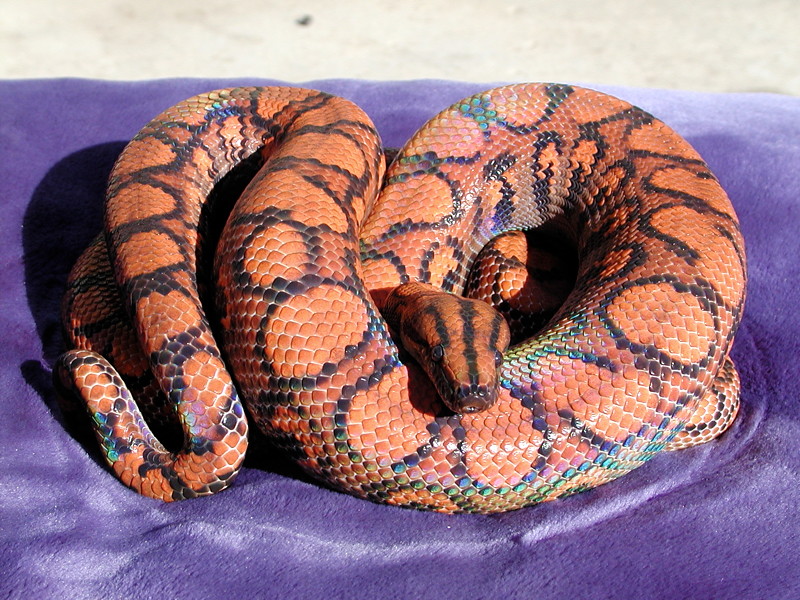 ...but, far more important than that, she had everything you could ever want in a pet snake. She was friendly to a fault, the perfect ambassador for a species often faulted for being “nippy.” One of my friends uses crutches to get around, and whenever she came over to visit, would always want to hold Topaz -- and the worst Topaz ever did was handcuff my friend to her crutch with a roll of curious, friendly snake. She was poseable, almost like she was partly made of Play-Doh. Ever since she saw a baby, she always settled for pictures when asked. You could even rearrange her slightly and she would hold that pose for you without complaint. To the best of my memory, she never bit anyone. So I was excited -- thrilled, in fact -- to breed her for the first time this year, so that I could share those glittering qualities with the world. Unfortunately, Topaz began having health problems -- small, at first -- this past quarter. In early July, she developed a small patch of off-color dry scales on her forehead. I put her in quarantine immediately, just for safety’s sake -- meaning, handle last and detox afterward -- and had a vet look at her soon after (as well as give her a general physical due to her being gravid). He said it was probably a skin issue, and to treat the area with betadine and Animax (effective against both bacterial and fungal outbreaks), and it should heal fine; she otherwise looked great. Time passed, and other than that one issue, Topaz acted fine for a gravid boa. On August 29, however, she lost her litter. She had great trouble with the delivery, struggling to pass some of the slugs especially. She sniffed through the pile of dead babies and slugs at the end, and I’d never seen her look so tired and sad. Later that night, she looked like she might have a retained slug, and I worried about that for days -- the lump thankfully went away almost right away, but I ran all the tests and exercises people advised anyway. On September 4, I fed Topaz her first post-delivery meal -- a small rat, one size down from her usual meal to be careful -- which she took after a slight hesitation. All seemed stable. On September 14, I had the vet look at her again -- costly for just her head and a slug check, but worth it for my favorite snake. The head had no changes, and he said to stop treatment and wait for a shed to heal it. He could find no retained slugs…which made me feel better. At least I could feed her more now. That night, however, she refused her traditional meal of frozen/thawed. She had previously done this only five times in her life -- three of them in deep pregnancy. The next night, when holding her to check up on her, she was attentive to me as always, raising her head right up to mine and watching my every move. However, upon putting her back in her viv, she had trouble staying upright. I made a lot of calls/e-mails that night. The first vet offered a third housecall, but seeing as he’d held her and missed any problems just 24 hours ago, I now wanted a second opinion. (Please note I’m not saying anything negative about this vet, I just wasn’t taking chances.) So, that Saturday (September 17), I rose at dawn to rush Topaz over an hour away to the best reptile vet in the Los Angeles region. The vet was very gracious to see her as a walk-in. He looked her over, but could not find anything specifically wrong: weight was good, mouth looked clean, etc. He said we could treat with Baytril…but it would only be a guess. Instead, he suggested a blood test and skin biopsy, and so I broke out my wallet again. When I got her back from the poking and prodding, she was energetic, actively moving around her box trying to escape. As I later updated my notes for the evening, I realized that today was her fourth birthday…and all I’d given her was a painful vet trip. On Monday, September 19, I got the bloodwork results…but although a few readings were slightly off, nothing caused the vet alarm. He said we should wait for the biopsy results. On Tuesday, September 20, she refused a second meal of frozen/thawed. On Wednesday, September 21, I upped the offer to live mice. The store had only tiny ones though, really hoppers…but you take what you can get. To my immense relief, soon after dropping the first one in, my big girl came to life!!! She hunted it down -- not an easy coordination task the way hoppers jump -- killed it, and ate it. I put two more in. She killed both, but only ate one. I tried gently lifting the remaining body to her face, but she again refused. I tried one more live. She killed this one, too, but again did not eat. Not many calories, I guess, but at least she moved and hunted fine. Again, I felt a bit better. On Saturday, September 24, the biopsy results came in. They had found nothing communicable. In the vet’s words: “Got good news/bad news for you with the histopathology that came in today. The good news that there was no pathological changes noted in the epidermis or dermis, no evidence of inflammation, neoplasia or infectious agents. The bad news is no causes for the skin changes were found. This means you don't have to be worried about your other snakes.” On the evening of Sunday, September 25, I wrote the second vet again, asking what else I could do for my girl. I did not get a response. (Again, I assign no blame: vets are busy, and I assume the message got lost in the crush of daily mail.) Over the next week, there was no other change in Topaz’s condition, for better or for worse. I prepped to feed her some live mice again, this time finding three fat and juicy rodents for the next evening. On Friday, September 30, during my regular monthly weigh-ins, I tackled Topaz last, right before I was to feed her. When I opened her viv, however, I noticed her -- head at the door of her hide -- suddenly open her mouth, and just leave it there. There was no foam or saliva…but this was not a normal yawn. A minute passed, then three, and finally I reached in to gently touch her head. She reacted by closing her mouth and just looking at me. On Saturday, October 1, I took her to the vet, fully expecting the worst -- probably, having to put her down. This was a third vet, as the other two were closed that weekend. Unfortunately, he was too busy to see her -- 10:30AM the next morning was the best they could do. I took my girl home and gently placed her back in her viv. She barely budged in her hide the entire trip. By the next morning, she was already gone. *** Soon after, I gently packed her up, and took her on one last car ride, right back to the vet for a necropsy. I spoke with the vet at length, then left her with a very sympathetic office staff, who said the vet would call around 4PM. In the meantime, I settled down to deal with the aftermath. Thankfully, communicable or not, she had been on strict quarantine for months, so I only had to deal with her immediate viv. Over the course of two hours, I followed a ruthless, take-no-chances scorched earth routine: I emptied her viv of all disposables, bagged them, and removed them from the apartment, along with the newspaper I laid down on the floor to catch any stray moss. The odd scrap of shed made me stop several times thinking of her. I set the furniture to soak in bleach solution. The classic rock channel, left on to try and distract me, did not help: Blue Oyster Cult weighed in with “The Reaper.” The viv itself was scrubbed with an even stronger bleach solution, and I allowed the chemical film to sit. Kansas upped the audio with “Dust in the Wind.” I then went back and cleaned again with mint disinfectant, which was also allowed to sit. The music now was less invasive; either that, or I’d stopped registering. Finally, I cleaned the viv doors a third time, now using Chlorhexidine to remove any residue of the stronger chemicals. I then cleaned my hands with arms and bleach and took a long shower. At 4:10PM, the vet called with the necropsy results. Topaz had died from pneumonia -- hidden away in her lower respiratory tract, deep enough that two other vets had not suspected a thing. The current vet, in fact, was amazed that she had not died a week ago. My poor, brave girl, hanging on to the bitter end, waiting for me to fix things for her like I always had. The vet continued, rattling off technical details. She had a bit of extra liquid around her heart, but that could be a result of the RI. She did indeed have a retained slug (also missed by two vets), but it was not giving her any problems. The odd scales were surface issues only -- he had checked under them, and all was normal. Everything else was fine. But details like those are black and white, not the vibrant oranges and reds that I remember her by. Looking through her care notes now, I find myself second-guessing. I see once where I had once noticed a gentle wheeze in July 2010. I’d checked myself her and found nothing; and even asked an herp sitter, watching the place while I was out of town, to check too. She wrote to me via e-mail “No issues with Topaz. Did not hear any whistling or gurgling; did not see any bubbling from the nostrils.” Or, when I’d given her several betadine baths to treat the scale issues, and she had gotten a tiny bit nervous on the last one in August 2011 -- had she inhaled something then? I’d looked carefully, several times, and seen no signs at all. All of which, I guess, is moot. She leaves me, if far too early, at least after four wonderful years, by my records having vanquished 146 rodents, filled 373 lines of Excel with care notes, and gifted me with dozens on dozens of amazingly colorful photos. May 2011 (43 Months) 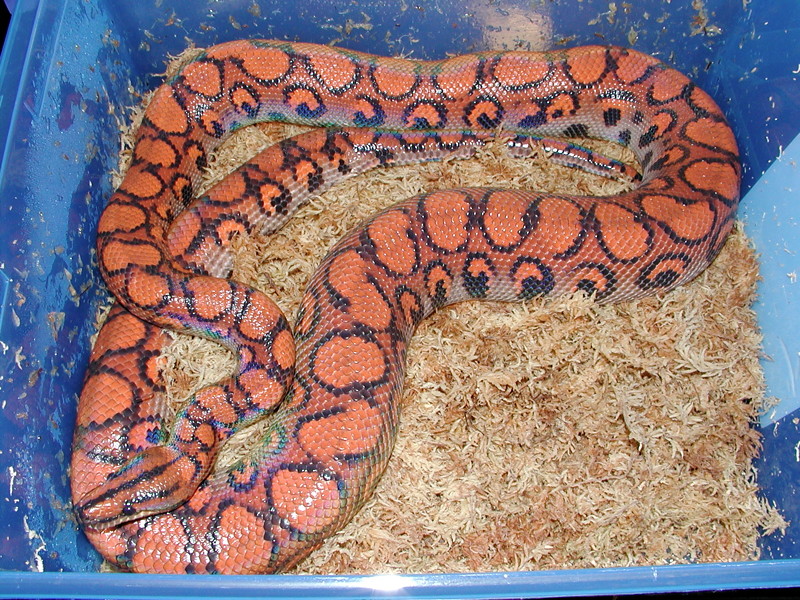 April 2009 (18 Months)  November 2007 (Baby) 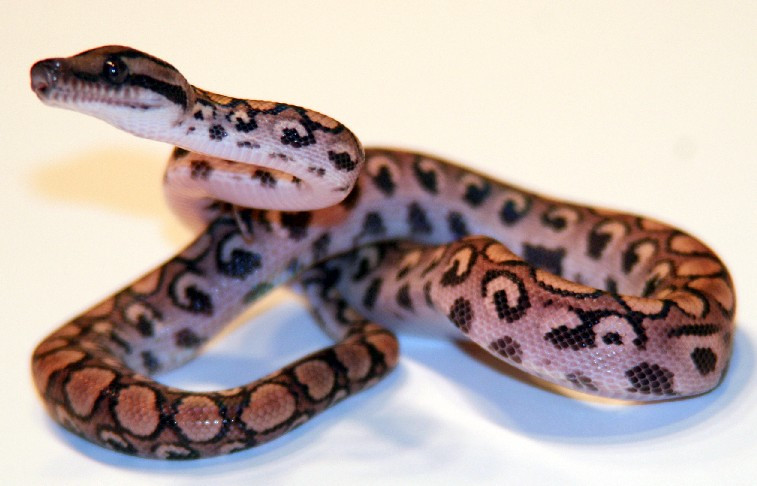 Topaz, my beautiful, posable, always-a-sweetheart snake, I’m so sorry that I failed you in the end. You will always be the one living gem that I wanted to share. Cliff Earle Living Gems Reptiles: premium Brazilian Rainbow Boas from a disease-tested facility 
(Page 1 of 1, totaling 3 entries)
|
Our SponsorsArchivesCategoriesSubscribe |
|
AprilFirstBioEngineering | GunHobbyist.com | GunShowGuide.com | GunShows.mobi | GunBusinessGuide.com | club kingsnake | live stage magazine
| ||||||||





